☫ 41 countries around the world: Africa, Asia, Oceania, South America
What is the definition of a “minor navy” ?
Surely there is a “top tier”, which is most often assimilated to a “blue water navy”. And it is most often assorted with a true aircraft carrier (not an assault ship), which gave us a limited club (USN, and Russian Navy, British, French, Italian and Spanish Navies, and in Asia the PLAN, JSDMF, Indian and Thai Navies). Then came “regional navies” sometimes flagged as “green water” navies, which in high tier have guided missile destroyers and assault ships (like Turkey) while the Bundesmarine have not, and they could still make a projection of power due to large ships with logistic for oceanic operations such as anti-piracy missions in the Red Sea. And this is the lower tier, which could defend its EEZ and do limited projection of powers nearby but not much esle, which is the object of the present chapter.
And there is at the bottom what most calls a “brown water” navy. The name suggest essentially a riverine fleet. It’s especially true of the country had still a limited coastal area but restricted budget and/or is landlocked and only has a complement to just a “police force” for its riverine traffic. This is true also for large lakes, like the Tanganyka in Africa. Still between the low tier regional naval power to the small riverine force, enters most nations on the planet. They are classed by alphabetical order. It must be said that 44 countries in the world (on 195 recoignised ones worldwide) are truly landlocked. Let’s cite Afghanistan, Andorra, Armenia, Austria, Czechia, Hungary, Liechtenstein, Luxemburg, Montenegro, North Macedonia, Serbia, Slovakia, Slovenia, Switzerland, in Europe alone, but also Azerbaijan, Belarus, Bhutan, Bolivia, Botswana, Burkina Faso, Burundi, Central African Republic, Chad, Eswatini, Ethiopia, Somaliland, Kazakhstan, Kosovo, Kyrgyzstan, Laos, Lesotho, Malawi, Mali, Moldova, Mongolia, Nepal, Niger, Paraguay, Rwanda, Slovakia, South Ossetia, South Sudan, Tajikistan, Transnistria, Turkmenistan, Uganda, Uzbekistan, Vatican, Zambia and Zimbabwe. In population, 475,818,737 so 6% roughly of the world’s population, showing superbly that the bulk of humanity lives close to the sea. Many of these only have a token riverine police force or nothing at all, even with a small river going through, nike Nepal. These are absent of the list but could be added next year.
PART II: Honduras to Lithuania
 Honduras Navy
Honduras Navy
History of the Fuerza Naval de Honduras
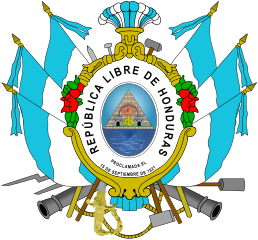 The Armed Forces of Honduras were originally created through article 44 as part of the country’s First Constitution in 1825, December 11, divided into battalions between seven departments and under French military doctrine. In 1831, the Military School was created and local arms production setup. Between 1842 and 1876 a new uniform emerged, soon at war in 1854.
The Armed Forces of Honduras were originally created through article 44 as part of the country’s First Constitution in 1825, December 11, divided into battalions between seven departments and under French military doctrine. In 1831, the Military School was created and local arms production setup. Between 1842 and 1876 a new uniform emerged, soon at war in 1854.
In 1860, the Guardiola administration, gave order to mobilize 400 army men and 220 more were transferred on the schooner “Correo Nacional” of the “Honduran navy” guarded by the British gunboat “Icarus” commanded by Admiral Sir Nowell in order to repel the filibuster William Walker who reinforced himself in New Orleans. After a battle that took place near the Tinto y Negro River, Walker was ambushed, captured on September 3, tried and executed by firing squad on September 12 of that year (1860.
On September 28, 1865, during the presidency of Captain General José María Medina, the Military Navy of Honduras was established, with President Medina himself boarding the schooner Colibrí that day. This first attempt to organize a Naval Force with a proper regulation met soon issues of cost as was deemed unsustainable.
For memory, Honduras is located on the land bridge between the north and souther continents, at the foot of the “horn” made by Belize and Guatemala. It is largely a Caribbean Nation due to its largest coast by far extending west to east from Puerto Cortes to Puerto Lempira. It’s greatest port was and is now La Ceiba. There is a small Pacific enclave in the south, cornered between El Salvador and Nicaragua, with the Port of San Lorenzo.
Several attempts to reactivate the idea of a Navy started with Doctor Policarpo Bonilla, who ordered the construction of the steamship Tatumbla in Kiel by November 22, 1895, to receive army guns. In 1896, General Manuel Bonilla built the private yacht “Hornet”. Later Dr. Bonilla and General Don Tiburcio Carias Andino ordered the construction of more steamers, Búfalo and El Tigre. But the political life of the country at large was unstable, riddle with coups and interference of the military in internal affairs. The navy was neglected. And to be clear, there is no record in Conway’s for the WWI book, only a small mentiuon for 1860-1905 and a bigger one in the 1947-95 volume.
Honduran Navy in WWI, WW2
In 1905 Honduras, is one of the larger republics (1905 official census 500,136) in Central America with an area of 43,277 square miles. The country has two coasts — Pacific and Caribbean Sea (63 miles and 375 miles). In the early years of the twentieth century she was closely associated with and her foreign trade was mainly with the USA. US Marines landed in January 1912 to protect American property. The main port was and is Puerto Cortés on the Caribbean and smaller ones Trujillo, Omoa and Amapala on the Gulf of Fonseca (Pacific). Amapala’s surrender on 11 April 1907 had virtually ended the war with Nicaragua since the cruiser USS Chicago gave refuge to the defeated Honduran President Manuel Borilla, landed marines and arranged terms with the victors. There was a small army of 500 soldiers which was supported in emergency by 20,000 militia. The Navy was still really symbolic with just a single 13t steam (22 ihp) launch, “22 Februar”, launched on 24 December 1897. From 1919 the Navy was “expanded” to the following:
-200-ton gunboat “Tatumbla” (2 small guns, 44 crew, 12kts)
-24—ton “Liberia”, ex-Liberian revenue cutter Mesurado, 85ft x 12ft x 4ft 6in, one Nordenfelt gun, one MG, 120hp engine working with 500 gal. paraffin, 12-14kts.
There is no record at all for the interwar of any addition.
Honduras had good diplomatic relations with Germany since the end of the 19th century and German citizens founded companies, sugar mills and coffee plantations under the Migration Law. As the Second World War broke out, many young German-Hondurans enlisted back into the German Army and Navy. At the same time, German U-Boat went up to dock on the Honduran coast and refuel food.
President Tiburcio Carías Andino broke relations with Germany however after strong pressures from the US embassy, especially after Pearl Harbor. So by December 8, 1941, Honduras declared war on Japan and four days later with Germany and Italy. It was justified to save face in press by the destruction by U-Boats of merchant ships, notably from Honduran banana companies. Comayagua was the first torpedoed in 1942, followed by Amapala on May 16, 1942. On June 7, ship Castilla was sunk and then Baja California, which caused some 200 Honduran citizens losses.
Carias Andino sent pilot officers, soldiers and sailors to serve mostly in the US Navy. Honduran sailors on November 10, 1942 were noted for their bravery. When conducting the freighter “Contessa” into the port of Lyautey (French Morocco) full of gasoline and ammunition for allied troops she was taken under enemy fire, and was able to repel it. According to reports and statements of survivors, the armed ship claimed 15 Italian aircraft. Other fought in the Pacific, and frequently served as gunners on US ships, especially AA guns.
Honduran Navy in the cold war
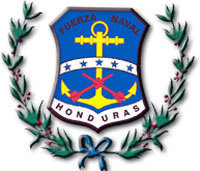 Honduras post-WW2 was one of the largest Central American republics (43,277 square miles) but also the poorest. Her Caribbean coastline did not changed much, neither additions to its “navy”.
Honduras post-WW2 was one of the largest Central American republics (43,277 square miles) but also the poorest. Her Caribbean coastline did not changed much, neither additions to its “navy”.
Under the administration of Dr. General Juan Manuel Gálvez on November 8, 1950, Regulations on Insignia and Uniforms of the Navy were issued. By April 20, 1964, the first two officers were assigned to the Navy, Erin O’Connor Bain and Humberto Regalado Hernández plus fourteen troops coming from the third Infantry Battalion. They were all sent to attend studies in Yorktown, at the Officer Training Center reserve of the Coast Guard. Sub Lieutenant Regalado were later posted for practice at the Naval Base of Panama, trained by local technicians with US assistance, thus forming the “First Boat Detachment” which became essential to allow a Naval Force to be created in 1976. Lieutenant Colonel Erin O’Connor Bain became its Commander.
By 1964, the US government donated two Mark-IV type boats (40 feet CPV) registered as OLA and ARO (General Oswaldo López Arellano, Andrés Ramírez Ortega). In short, the navy was officially reborn in 1976 by a presidential agreement of August 14, whose purpose was the protection of the national marine territory, in the waters of the Atlantic and Pacific Oceans. Its tasks were defined at the time to be able to Execute Naval Operations in the Caribbean Sea and Gulf of Fonseca (Pacific Ocean) in order to safeguard national maritime interests.
Specializations includes anti-narcotics via sea, interception of unidentified vessels and protecting sovereignty by sea. Personel amounted to 4,000 approximately recently between personel at sea and inland (specialists, maintenance, administrative).
In 1977; so one year after its creation, this small Naval Force acquired three units. The 105 feet Guaymuras and the 65 ft La Patuca and Ulua.
Like neighbouring central american republics in the cold war, political situation was tense, and what happened in the 1980s in El Salvador and Nicaragua led Honduras to rearm massively with US assistance, including its reborn navy. Honduras in 1982 emerged from a long spell of military government during which time repressive action was taken by military leaders against agricultural unions; discontent was due to the slow pace with which agrarian reform was taking place.
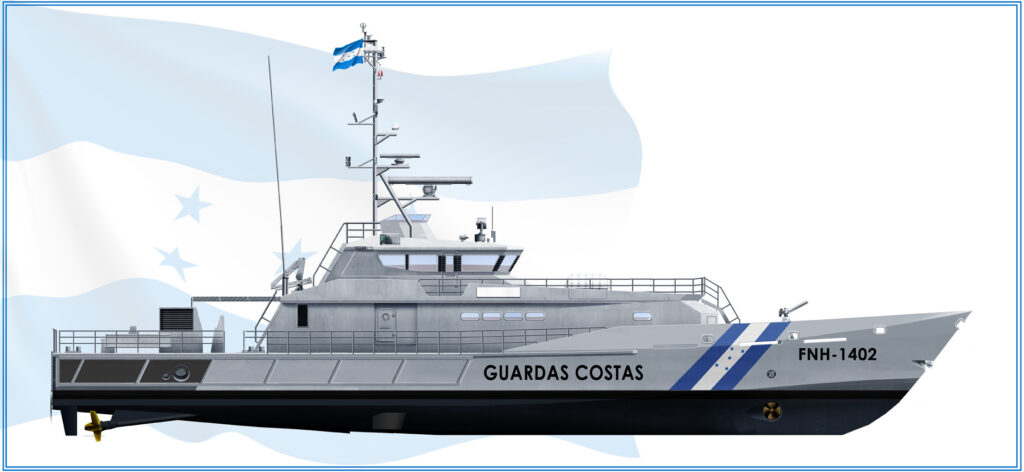
Author’s rendition of the Damen Stan Patrol 4027 of the Honduran Guardas Costas.
In 1988 the Punta Caxinas was its first amphibious ship (149 feet, capacity 100 tons) and a few years later, the first Peterson Mk-III model patrol boat was acquired (65 ft, 82 tons, powered by three GM 8V71T1 diesels for 26 knots, range 450 miles full speed). In 2013, two Damen Stan 4207 ships (FNH 1401 and 1402) were also acquired, one in September and the other in November, to make the the Honduran navy one of the most modern in the region.
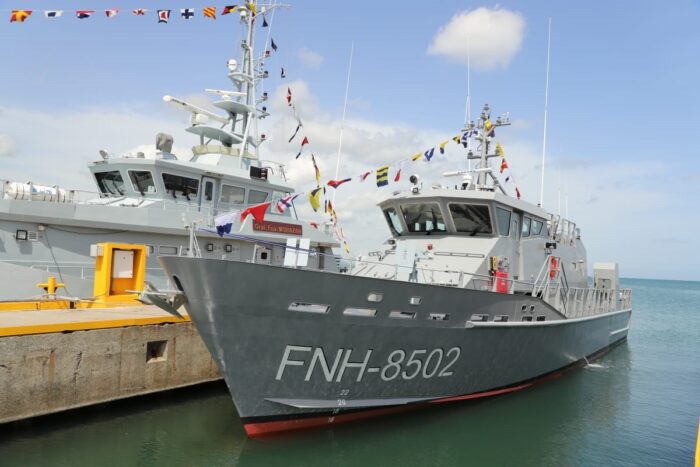
The U.S. government donated the “Río Aguán” FNH-8502 patrol boat to the Honduran Secretariat of National Defense, on July 9, 2021. (Photo: Honduran Secretariat of National Defense)
In 1982 a civilian government led by Roberto Suazo Cordora came into power. Honduras, like many Latin American countries, has experienced border disputes with all the countries adjacent to her. In 1969 the so-called ‘Soccer War’ took place with El Salvador, occasioned by disagreements over a football match. The dispute continued intermittently until 1976 when both countries agreed to talks. Honduras found herself the thoroughfare for arms supplies to El Salvadorian guerrillas coming from Nicaragua and consequently has been exposed to pressure from the US government in an effort to reduce these supplies of arms. The terrorist violence experienced by Honduras’ neighbours now appears to be establishing itself in Honduras; in 1982 measures were taken by the military against terrorist groups.
The republic’s Coast Guard was created abnd expanded with US helpe for its basic maritime security needs, with US help. This force employed in the 1990s 900 men, a percentage of whom are carrying out the 24 months’ national service. The main base is at Puerto Cortes on the Caribbean coast.
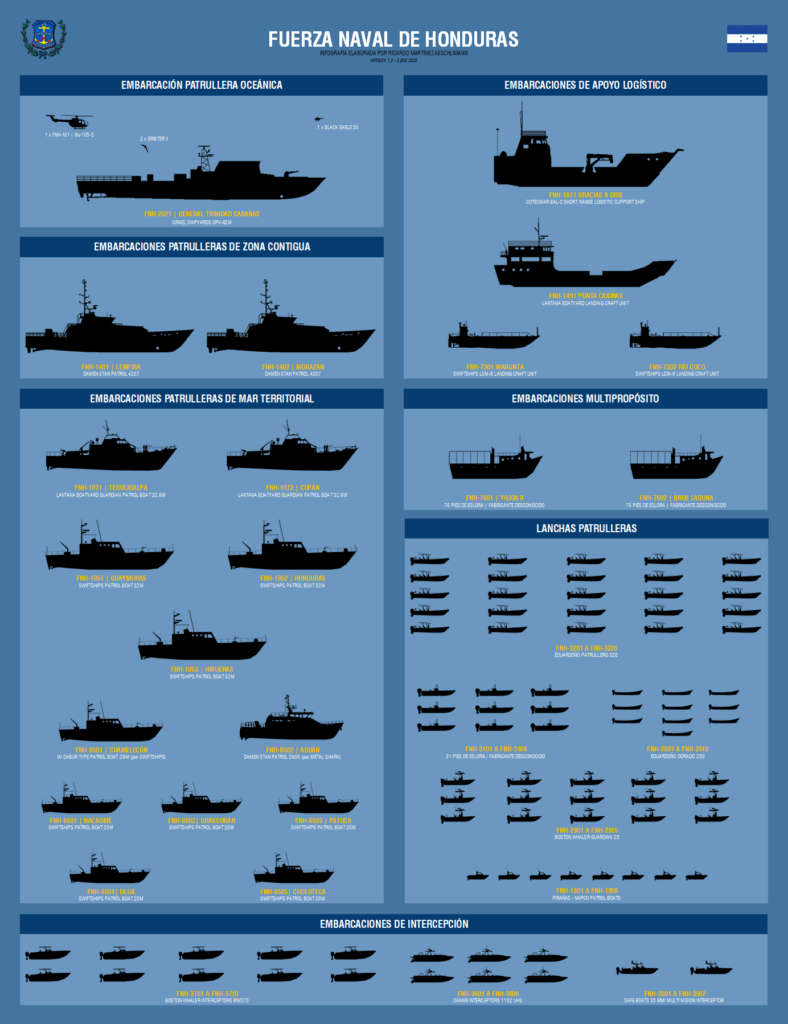
Creative commons Poster of the Honduran Navy today.
List (Cold War)
-3x ‘Swift’ type 105ft class patrol boats: Guaymuras (FN 1051), Honduras (FN 1052), Hibures (FN 1053).
Built by Swiftships, Morgan City, Louisiana, in service April 1977 (FN 1051) and March 1980 the latter units.
Specs:
103t, 32kts, 2 shafts, 2 MTU diesels, 17 crew. Armament !—20mm Gatling, 2 -12.7mm, or 6-20mm (2×3). Extant 1995.
1x US 85ft patrol boat (commercial cruiser type): Chamelecon (EN 8502). Built by Swiftships, Louisiana, in service date unknown.
Specs: 50t, 23kts, 2 shafts, 2 GM diesels, 10 crew. Armament 1-20mm, 2—12.7mm. Extant 1995.
5x US 65ft commercial cruiser type patrol boats: Aguan (ex-Gral, FN 6501), Goascoran, ex-¥ T Cabanas (FN 6502), Petula FN 6503), Ulua (FN 6504), Chuluteca (FN 6505).
Built by Swiftships, Morgan City, Louisiana. In service December 1973 (FN 6501), January 1974 (FN 6502), 1980 remainder.
Specs:
33t, 25kts, 3 shafts, 3 GM diesels, armed with 2-12.7mm MG, 5 crew.
Haiti ordered FN 6501 and FN 6502 originally, transferred to Honduras 1977, three more fitted with 3 MTU diesels (36kts), armed with 120mm, 2—12.7mm. Extant 1995.
2x inshore patrol craft: FN 2501 and FN 2502. Built by Ampela Marine, Honduras, entered service 1981-82.
Specs:
3t, 24kts, 25ft x 8ft 10in x lft 4in (7.6m x 2.7m x 0.4m), 1 Chrysler diesel, waterjet drive, armed with 1-12.7mm MG, 1—7.62mm MG, 4 crew. Now stricken.
2x Guardian coastal patrol craft: Copan (FNH 106), Tegucigalpa (FNH 107). Delivered by Lantana Boatyard 1983, 1986
Specs: 94t, 2070bhp = 30kts, 1—20mm Gatling, 3-20mm Hispano Suiza (1×3), 2-12.7mm). Extant 1995.
12x Piranha class riverine patrol craft: Numbered only, delivered 1986—90.
1x landing craft (LCU): Punta Caxinas (FNH 1491). Delivered 1988 by Lantana Boatyard (625t full load, 14kts), extant 1995.
6x ex-fishing boats: FN 7501, FN 7502, FN 7503, FN 7504, FN 7505, FN 7506. Extant 1995.
Bases and Organization:
The Honduran navy possess today four naval bases (“Base Naval”):
-Puerto Cortés: Main repair/logistics base, Caribbean.
-Puerto Castilla: Main operating, patrol boats, Caribbean.
-Amapala: Main operating base, for coastal patrol craft, north end, Pacific coast.
-Caratasca (new) well placed to intercept drug trafficking boats
-1st. Marine Infantry Battalion at La Ceiba
-Honduras Naval Academy, for officers, La Ceiba
-Naval Training Center: NCO and Sailor training facility.
-Possible air support from either Hernan Acosta Mejia AB (Tegucigalpa), Soto Cano AB (Comayagua), Armando Escalon Espinal AB (La Lima, Cortés), and Hector Caraccioli Moncada, La Ceiba.
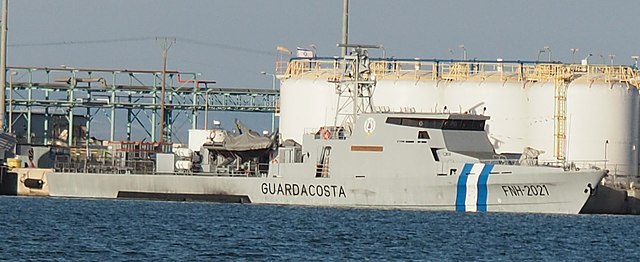
Sa’ar 62 type General Cabañas (flagship)
List (today)
The Navy is tasked of coastal and riverine security and stil boasts some 71 patrol boats, interceptors and landing craft units, which makes its a sizeable green water fleet.
1x Sa’ar 62-class offshore patrol vessel (OPV): FNH-2021 General Trinidad Cabañas (62 (204 feet)) OPV-62M from December 2019
2x Damen Stan Patrol Boats: FNH-1401 Lempira, FNH-1402 General Francisco Morazán (42.8m (140 feet) Dutch CPV (Coastal patrol vessel)
3x LANTANA BOATYARD Guardian CPVs: FNH-1071 Tegucigalpa, FNH-1072 Copán, FNH-1073. US built (32.3m or 107 feet)
3x SWIFTSHIPS CPVs: FNH-1051 Guaymuras, FNH-1052 Honduras, FNH-1053 Hibueras (US built 32m/ 105ft)
1x IAI Dabur Type CPV: FNH-8501 Chamelecón (26 m/85 ft)
5x SWIFTSHIPS CPV FNH 6501-05 Nacaome, Goascorán, Patuca, Ulúa, Choluteca (US built 20m/65 feet)
10x BOSTON WHALER Interceptors BW370, Guardian class 1102+ UHS
6x DAMEN Interceptors 1102 UHS: FNH-3601 to FNH-3606
2x SAFE BOATS 35MMI Multi Misión Interceptor (Colombia)
2x Interceptor boat 35 MMI FNH-3501-2
25x EDUARDOÑO Patrullero 320: (Colombia) FNH-3201 to FNH-3225
8x NAPCO Piraña PBs; Riverine, US built Ops boats.
1x LANTANA BOATYARD Landing Craft Coastal transport: FNH-1491 Punta Caxinas
1x COTECMAR BAL-C Short Range Logistic Support Ship (Colombia), Short Range Logistic: BAL-C FNH-1611 Gracias a Dios
3x SWIFTSHIPS LCM-8 Landing Craft Unit (US): FNH-7301 Warunta, Rio Coco, unnamed.
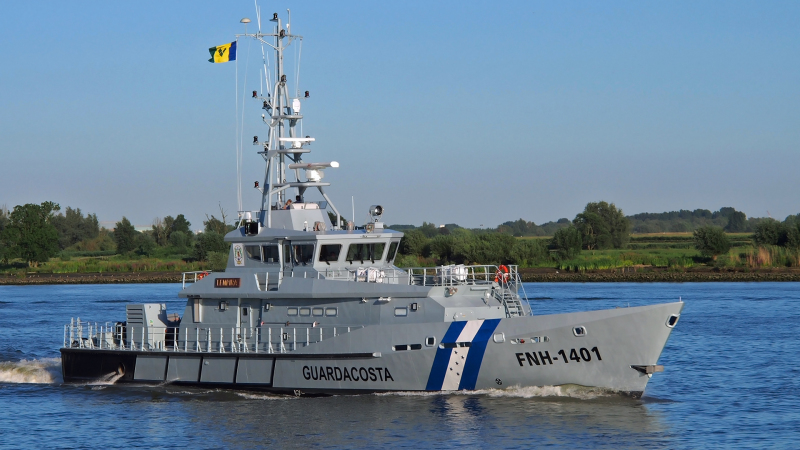
Damen Stan Patrol 4207 FNH Lempira
Sources
Conway’s all the world’s fighting ships 1905-1921 p416, 1947-1995.
defensa.com/ guardacostas
cimcon.armada.mil.co/
en.topwar.ru/
elheraldo.hn/honduras
articulo66.com/ nicaragua-denuncia-invasion-maritima-el-salvador/
proceso.hn
infodefensa.com
dialogo-americas.com
laprensa.hn/
defensa.com/ asi-son-patrulleras-…
shipbuildinghistory.com /lantana.htm
defensa.com/ avanza-israel-construccion-opv-62
es.wikipedia.org Fuerza_Naval_de_Honduras
en.wikipedia.org Armed_Forces_of_Honduras
 Icelandic Navy
Icelandic Navy
History
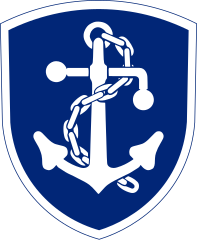 Iceland had been inhabited by Scandinavian people dating back the sagas in the wake of the mythical discoveries of so called Greenland, Vinland and Helluland. In 870s it was a free Norwegian colony until it became part of the realm of the Norwegian King, and its military defences of Iceland rested on multiple chieftains (Goðar) and their village followers. The colony grew and in the 13th cent. major feuds (the Age of the Sturlungs) in the 13th century followed the construction of some 21 fortresses. Amphibious operations were remained common in the Westfjords, with the largest sea battle called Flóabardagi, seeing only a few dozen ships going into a brawl in Húnaflói bay. Fast forward and before the Napoloenic era, Iceland was defended by a few hundred militiamen in the southwest of Iceland armed with old muskets and halberds. English raiders arrived in 1808, sank and capture the bulk of the Danish-Norwegian Navy, in the Battle of Copenhagen.
Iceland had been inhabited by Scandinavian people dating back the sagas in the wake of the mythical discoveries of so called Greenland, Vinland and Helluland. In 870s it was a free Norwegian colony until it became part of the realm of the Norwegian King, and its military defences of Iceland rested on multiple chieftains (Goðar) and their village followers. The colony grew and in the 13th cent. major feuds (the Age of the Sturlungs) in the 13th century followed the construction of some 21 fortresses. Amphibious operations were remained common in the Westfjords, with the largest sea battle called Flóabardagi, seeing only a few dozen ships going into a brawl in Húnaflói bay. Fast forward and before the Napoloenic era, Iceland was defended by a few hundred militiamen in the southwest of Iceland armed with old muskets and halberds. English raiders arrived in 1808, sank and capture the bulk of the Danish-Norwegian Navy, in the Battle of Copenhagen.
There was an independence movement from Denmark rule in 1855-57. In 1918, Iceland regained sovereignty, appearing as a separate kingdom under the Danish king and first established a small Coast Guard.
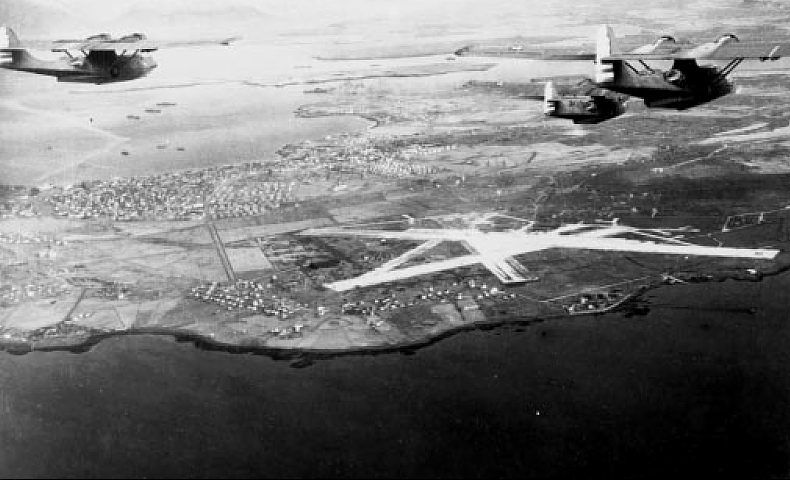
PBY-5As returning to Reykyavik NAS in 1942
Then, close to the Second World War, the government expanded the Icelandic National Police (Ríkislögreglan) with its reserves creating a small militia army under command of former Chief Commissioner Agnar Kofoed Hansen, previously trained in the Danish Army, procuring Weapons and uniforms and trained hard near Laugarvatn. The army counted 60 officers when UK launched the invasion of Iceland on 10 May 1940 as a preemptive measure to void German capture of this very strategic island in the north Atlantic.
In mid-1941 British troops were needed elsewhere and the United States took over occupation duties for the same reasons, but started to negociate the installation of a base and airfield for patrol bombers in order to monitor this “dark spot” in ASW coverage of the mid-Atlantic. It was not with Iceland’s approval again, but the country remained neutral.
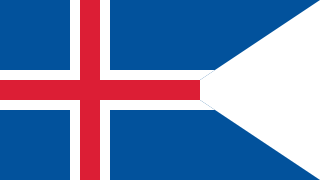 This stationing of US forces remained well after the war, and was solidified through NATO in the “Agreed Minute”. In 1949 Iceland became a founding member of NATO, being the linchpin of the organization by essence due to its location and the very name of the organization. It was the new bastion of noerthern defences against Soviet submarine incursions. But it remained the sole member without a standing army. There was an Expansion of forces of the Icelandic Coast Guard, which aside its role withing NATO was more acute of defending its own territorial waters, notably against British fishing vessels, sometimes protected by the Royal Navy (The “Cod Wars”), which were militarised interstate disputes.
This stationing of US forces remained well after the war, and was solidified through NATO in the “Agreed Minute”. In 1949 Iceland became a founding member of NATO, being the linchpin of the organization by essence due to its location and the very name of the organization. It was the new bastion of noerthern defences against Soviet submarine incursions. But it remained the sole member without a standing army. There was an Expansion of forces of the Icelandic Coast Guard, which aside its role withing NATO was more acute of defending its own territorial waters, notably against British fishing vessels, sometimes protected by the Royal Navy (The “Cod Wars”), which were militarised interstate disputes.
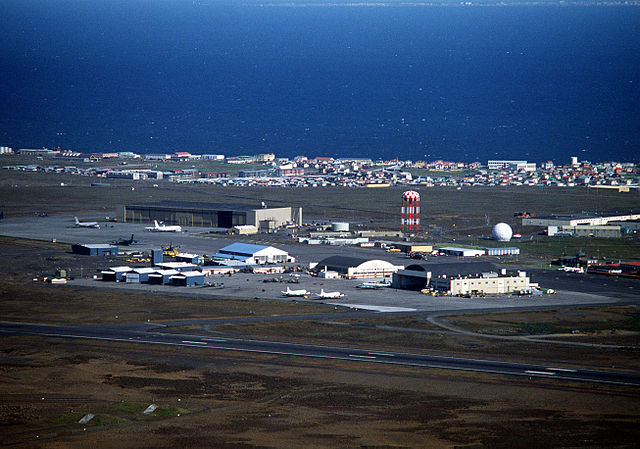
Keflavik NAS aerial view in 1982.
The Iceland Defense Force became a military command of the United States Armed Forces, from 1951 to 2006, created at the request of NATO in which the US would defend Iceland provided the latter did nit created its own army and concentrated in its coast guard only, procured and operated in a fullly independent way.
There was no Icelandic air force either and the U.S. Air Force maintained 4-6 interceptor at NAS Keflavik until 30 September 2006. From May 2008, NATO made rotations there as part of Icelandic Air Policing mission. Relations with UK always had been tense, though.
the Icelandic Defence Agency (Varnarmálastofnun Íslands) was founded in 2008 under the Minister for Foreign Affairs, overseeing operations at the Naval Air Station Keflavik, and closed in 2011 after the 2008 economic crisis. The Icelandic Coast Guard is today still the only standing military organization of the country.
The Icelandic Coast Guard
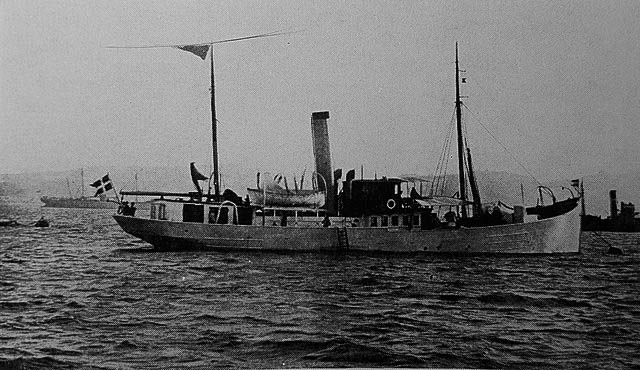
The research vessel Thor in 1928.
From its sovereignty in 1918, the Icelandic Coast Guard was created from a single former Danish research vessel armed with a 57 mm cannon. It was tasked of protecting the country’s rich and vital fishing areas. It was also tasked of research, and SAR services for the fishing fleet. ICGV Þór (1926) was the first patrol ship of the Icelandic Coast Guard, named after the nordic mythology god and buit by Edwards Brothers at North Shields, 1899 as a steam trawler for the Danish-Icelandic trade and fishing association. She was based in Geirseyri and later became a research ship for Denmark, purchased in 1920 by Björgunarfélag Vestmannaeyja for fishing control and rescue. It was definitely took over by the Icelandic government in 1926 as the starte of a Coast Guard and armed with two 57 mm cannons, later one 47 mm cannon. She ran aground at Húnaflói in a storm on 21 December 1929 and was declared lost.
Next came ICGV Óðinn, another Patrol vessel from 1926 until 1936. She served until sold to Sweden in 1936.

In WW2 the Icelandic coast guard comprised the following:
-ICGV Ægir (I) Patrol vessel (1929) purchased in July and used for coastal patrol, rescue and research, sold for scrap 1968. She was built in Burmeister & Wain, Denmark, launched 25 April 1929 for Iceland, powered by a B&W diesel engine to 13 knots (24 km/h; 15 mph). She had a single 47 mm gun. Ægir was the sister ship of the Danish research vessel Dana, commissioned in July 1929, she took part in the first of the Cod Wars, tasked for patrols, search and rescue, fishery inspections, research and nautical survey, replaced by the new Ægir in 1968.
The second vessel of the Icelandic navy in WW2 was ICGV Þór (II), acquired in 1930 but only active until 1939. She had been built in Stettin, Germany in 1922 as “Senator Schäfer” and arrived in 1930. She became a transport ship until sold to England in 1946 and was stranded in Scotland in 1950, declared a total loss.
The Icelandic naval force consisted entirely of fishery protection vessels, converted from merchant types and was set up about 1930. The vessels taken into service up to 1946 were Esja (1939, 1347t gross); the armed trawlers Aegir (1929, w497t gross) and Thor (ex-German Senator Shafer purchased 1930, built 1922, 226t gross) both with one 57mm gun; the MFV Odinn (1938, 72t gross) armed with one 47mm gun; and the Sudin (ex-Cambria, ex-Gotha, 1895, 811t gross). Thor and Sudin were discarded in the 1940s, the Esja in the 1950s and the Aegir and Odinn (renamed Gauter c1959) in the 1960s.
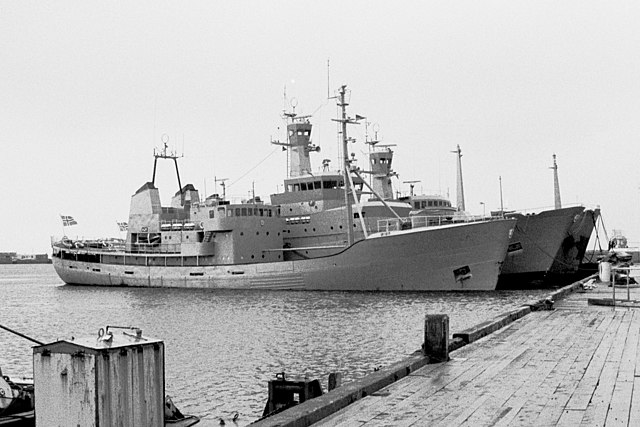
Icelandic coast guards ships in 1982
Although a member of NATO, Iceland has no navy. However, there is a coast guard service which is mainly employed in fishery protection and offshore patrol duties. Although its patrol craft were regularly referred to as ‘gunboats’ during the 1975-76 ‘Cod War’ with the UK, they have only nominal armament (originally 1—57mm gun: vessels in service in 1990 were rearmed with 140mm Bofors). Aegir, 1929, 507t, 14kts, BU 1968 Saebjorg, 1937, 98t, 10kts, stricken Aug 1965 Gautur (ex-Odinn), 1938, 72t, 11kts, stricken 1.1.63 Hermadur, 1947, 208t, 13kts, foundered 17.7.59 Maria Julia, 1950, 138t, 11.5kts, sold 1969 Thor*, 1951, 920t, 17kts, stricken Albert, 1956, 200t, 12kts, stricken Odinn*, 1959, 1000t, 18kts, extant 1995 Arvakur, 1962, 716t, 12kts, stricken Aegir*, 1968, 1150t, 19kts, extant 1995 Baldur, 1974, 740t, 15kts, stricken Tyr*, 1974, 1150t, 19kts, extant 1995 * have sonar, helicopter deck and hangar.
In 1952, 1958, 1972, and 1975, Iceland’s EEZ as expanded gradually to 4, 12, 50, and 200 nautical miles, encroaching on claimed fishery areas of the United Kingdom, leading to the “Cod Wars”. The Icelandic Coast Guard and Royal Navy were at standoff continuously from there, no shot was ever fired but there were tense moments. The Coast Guard today possess four large OPVs and a few aircraft and helicopters. They also took their share with peacekeeping operations abroad. The Coast Guard has four vessels and four aircraft (one fixed wing and three helicopters) at their disposal.
Cold War Icelandic Ships
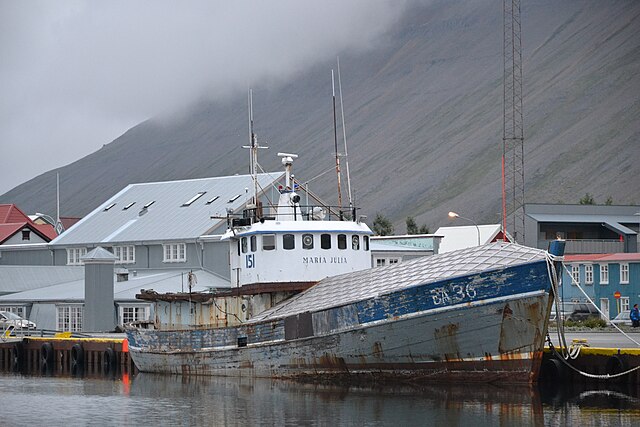
CGV Gautur: Patrol vessel (1938-1964) Built in 1938 in Akureyri.
Baldur class: Fast patrol boats (1945): Baldur, Njörður, Bragi: Built for the Turkish Navy in 1943, expropriated by UK, bought early in 1946 and returned because due to rough seas inabilities.
ICGV Sæbjörg: Patrol and rescue ship built 1947 used by the National Life-saving Association of Iceland (NLSA), decommissioned 1960s.
ICGV María Júlía: Patrol, research and rescue vessel (1950) privately financed, Joint ownership by ICG-NLSA, decommissioned late 1960s.
ICGV Þór (III): 1951 OPV, British built, flagship, seeing all three Cod Wars. Sold 1982.
ICGV Albert: OPV/SAR purchased 1956, owned by now ICE-SAR. Decommissioned 1978.
ICGV Óðinn (III): OPV (1960). Decommissioned in 2006, museum ship.
Ægir class (1968): Danish-built OPV with ICGV Týr (II). flagship ICG, last two Cod Wars. Decommissioned 2020 unlike ICGV Týr (II) 1974-2021.
ICGV Árvakur: Lighthouse tender/OPV (1969) built in Holland 1962 for the Department of Lighthouses, decom., sold 1988.
ICGV Týr: Armed whaler (1972, Hvalur 9) borrowed for the second Cod War and called “Moby Dick” by the RN, decom. 1973.
ICGV Baldur (II): Armed trawler (1975-1977) for the third Cod Wars. She collided with, and knocked out three British frigates during the conflict.
ICGV Ver: Armed trawler (1976-1976) Built in Poland for Krossvík hf. in Akranes. Last Cod War.
The “cod war”
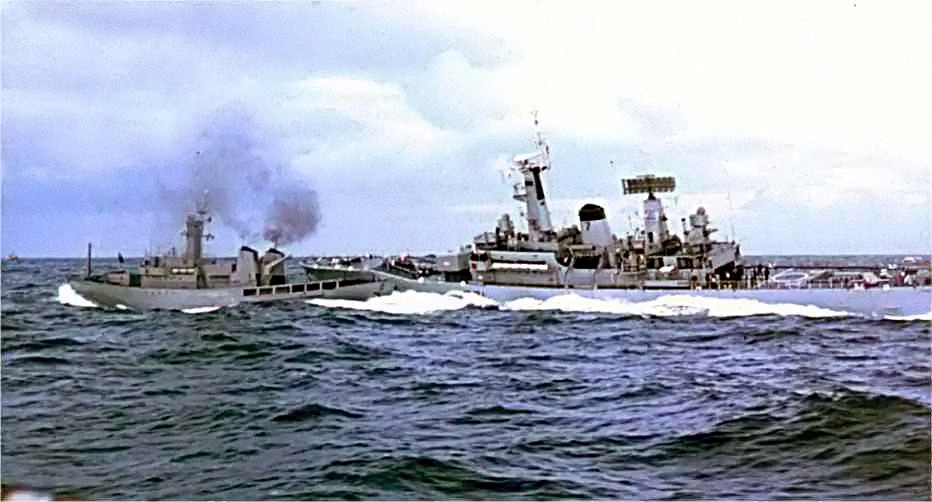
HMS Scylla rammed by Odinn
Another case of tensions within NATO (after the Turko-Greek tensions) is the case of fishery area claims made between UK and Iceland, both having superposed EEZ. The Cod Wars were a series of confrontations between the United Kingdom and Iceland in the mid-20th century, primarily over fishing rights in the North Atlantic. These conflicts occurred in three main phases: 1958-1961, 1972-1973, and 1975-1976. The disputes were largely non-violent but involved various naval maneuvers and incidents of ramming and cutting fishing nets. Here’s an overview of each phase:
First Cod War (1958-1961):
The first conflict began after Iceland unilaterally extended its fishing limits from 4 to 12 nautical miles in 1958, aiming to protect its fish stocks from overfishing. The UK, whose trawlers fished in the area, refused to recognize the new limits and continued fishing. There were several confrontations at sea, including instances of ramming between Icelandic patrol vessels and British trawlers. The Royal Navy was involved to protect British trawlers. The conflict ended in 1961 with an agreement that allowed British trawlers limited access to the disputed waters.
The Second Cod War (1972-1973) started when Iceland further extended its fishing limits to 50 nautical miles in 1972. The UK again refused to recognize the new limits, leading to another round of confrontations. More serious clashes occurred, with Icelandic patrol boats cutting the nets of British trawlers. The Royal Navy was again deployed to protect the trawlers. The conflict ended with a temporary agreement, where the UK recognized Iceland’s 50-mile limit in exchange for limited fishing rights within the zone.
The Third Cod War (1975-1976) started when Iceland extended its fishing limits to 200 nautical miles in 1975, following the global trend towards extended economic zones.
The UK resisted this move, leading to the most intense of the Cod Wars. This phase saw frequent confrontations, including ramming incidents and the use of trawler wire cutters by Icelandic vessels. Iceland threatened to close a key NATO base if its demands were not met, leveraging its strategic importance during the Cold War. The UK eventually conceded, recognizing the 200-mile limit, and Iceland agreed to allow a limited number of British trawlers to fish in the area for a transitional period.
The Cod Wars significantly reduced British access to fishing grounds around Iceland, impacting the UK fishing industry. These contributed to the broader acceptance of 200-mile exclusive economic zones (EEZs) in international maritime law, which were later formalized by the United Nations Convention on the Law of the Sea (UNCLOS). Despite the confrontations, the UK and Iceland maintained overall peaceful diplomatic relations, and the disputes were resolved without significant loss of life or major escalation.
Today’s Icelandic coast guard
The Coast Guard’s fleet consists of three patrol vessels and one monitoring and measurement vessel. Þór is the largest and newest ship in the fleet, and flagship. The fleet includes the sister ships V/s Týr and V/s Ægir, built by Ålborg Værft a/s in Denmark. All has the latest navigation and electronic communication systems with powerful light boats on board to transport personnel between ships as well as other tasks. There are helipads on Ægi og Tý, unable however to support the heavy Super Puma helicopters alshough they can resupply them with a pump fuel, provided they hover over the ships.
M/s Baldur was built by Vélsmiðja Seyðisfjörður in 1991, used for monitoring the continental shald, taking sea measurements and otehr tasks. On board is a dinghy equipped for marine measurements in shallow water.
ICGV Freyja ()
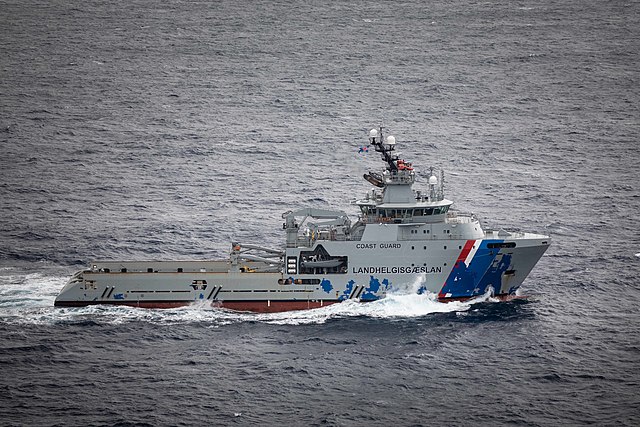
NORTH ATLANTIC OCEAN (April 4, 2022) – The Icelandic off-shore patrol vessel ICGV Freyja sails with Allied units in the North Atlantic Ocean in support of exercise Northern Viking 22, April 4, 2022. Northern Viking 22 strengthens interoperability and force readiness between the U.S., Iceland and allied nations, enabling multi-domain command and control of joint and coalition forces in the defense of Iceland and Sea lines of Communication in the Greenland, Iceland, United Kingdom (GIUK) gap. (U.S. Navy photo by Mass Communication Specialist 3rd Class Jesse Schwab)
Built in South Korea as OPV, Named after the goddess Freyja. Built at SeKwang, South Korea, launched 29 April 2009, acquired 2021.
Specs:
4,566 GT, 85,8 x 19,9 x 8,8m, Bergen Diesel ME, 2×6000 kW 17 knots, 2x Waterjet engine FRC, crew 18. Unarmed.
ICGV Þór (2011)
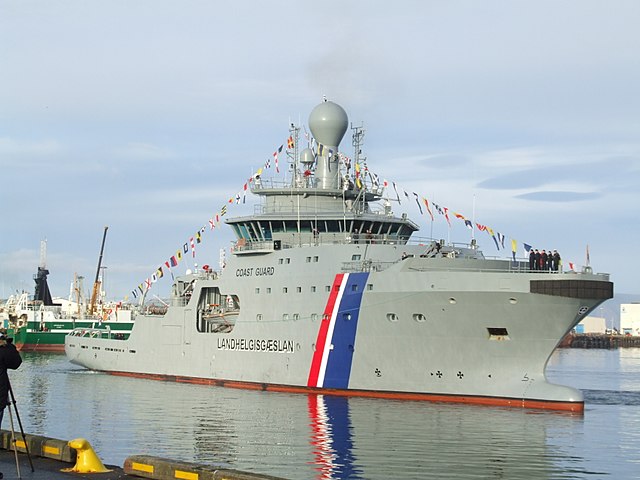
Ex-Chilean OPV, Named after the god Thor. Flagship. Rolls-Royce Marine AS “UT 512 L” type offshore patrol vessel. Ordered 4 March 2005. Construted at ASMAR Naval Shipyard in Talcahuano, Chile, on 16 October 2007.
Specs:
4,049 GT, 93.80 x 16/30 x 5.80 m (307.7 x 52/98 x 19 ft), 2 × 4,500 kW Rolls-Royce Bergen diesel, 2 × 450 kW bow tunnel thrusters, 883 kW retractable azimuth thruster, 20.1 knots.
Equipped with 2 MOB boats, Helicopter in-flight refuelling capabilities (HIFR), Bollard pull: 120 t (132.3 st)
Armed with one Bofors 40 mm gun, 2 × 12.7 mm HMGs, S-band radar, 2× X-band radars and Synthetic aperture sonar. crew 48.
ICGV Baldur
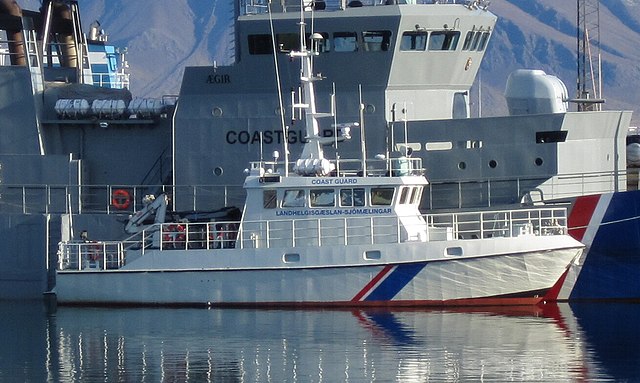
OPV Named after the god Baldr, also performs hydrographic survey duties. Built by Vélsmiðja Seyðisfjarðar, Iceland in 1991, used for hydrographic surveying, patrol, law enforcement, exercises. Shje disvoverted in 2002 a Northrop N-3PB lying upside down at the depth of around 11 meters in Skerjafjörður, close to Reykjavík.
Specs:
21.3 x 5.2 x 1.8m (69 ft 11 in x 17 ft 1 in x 5 ft 11 in). Speed 12 knots, crew 4-8, unarmed.
ICGV Óðinn
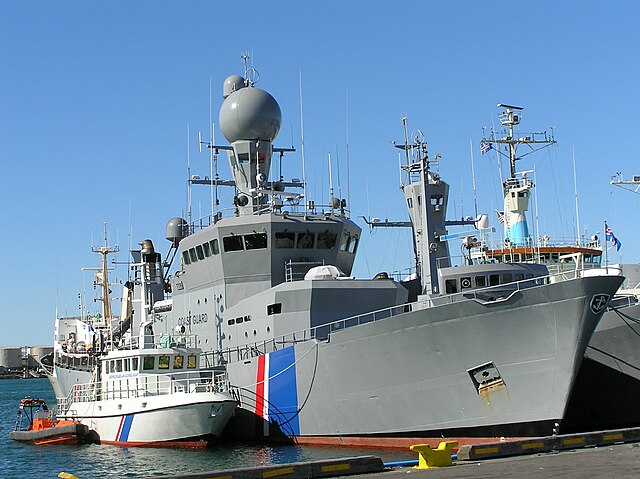
Used for Special operations. The action boat Óðinn is a covered hard-bottom tube boat that, among other things, is used by LHG’s special operations division but also for surveillance and exercises. No more infos.
Icelandic Naval Aviation
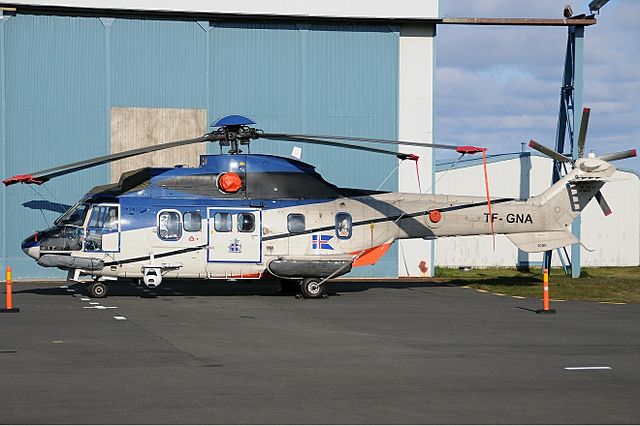
The Aviation Department of the Coast Guard consists of three helicopters and one airplane. The aircraft is of the type De-Havilland DHC-8-Q314, TF-SIF(4). It arrived in Iceland in the summer of 2009. The Coast Guard operates three Airbus H225 helicopters leased from Knut Axel Ugland Holding, designated TF-EIR, TF-GRO and TF-GNA. They are very well equipped for search and rescue operations.
Src
Official
1 2 3 4
lhg.is/um-okkur/taekjakostur/loftfor/
lhg.is/um-okkur/sagan/sagan
timarit.is/1 timarit.is/2
commons.wikimedia.org/ Icelandic_Coast_Guard
en.wikipedia.org Icelandic_Coast_Guard
is.wikipedia.org/
 Iraqi Navy
Iraqi Navy
Origin in 1937 and composition
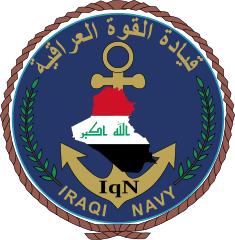 The birth of the Iraqi Navy is concomitent of the country’s independence and access to the sea. The Royal Iraqi Navy was formed as a four-ship force (HQ Basra), primarily a riverine force. Long story short, the Bronze Age Sumer, Akkadian Empire, Assyria, and Babylonia all had fleets of riverine vessels notably for protection trade on the Tigre and Euphrates. These important waterways saw activity later under the Achaemenid and Seleucid rule, Parthian and Roman rule, Sassanid Empire, Abbasid Caliphate, Turco-Mongol rule, Ottoman and Mamluk rule until British mandate of Mesopotamia after WWI. The Independent Kingdom of Iraq started in 1932 but poltical instability plagued the country until 1941. There was a short lived pro-Nazi government, defeated in May 1941 by the allies with local Assyrian and Kurdish help known as the Anglo-Iraqi War and as instrumental as was the allied invasion or iran and fight over Vichy-French Syria.
The birth of the Iraqi Navy is concomitent of the country’s independence and access to the sea. The Royal Iraqi Navy was formed as a four-ship force (HQ Basra), primarily a riverine force. Long story short, the Bronze Age Sumer, Akkadian Empire, Assyria, and Babylonia all had fleets of riverine vessels notably for protection trade on the Tigre and Euphrates. These important waterways saw activity later under the Achaemenid and Seleucid rule, Parthian and Roman rule, Sassanid Empire, Abbasid Caliphate, Turco-Mongol rule, Ottoman and Mamluk rule until British mandate of Mesopotamia after WWI. The Independent Kingdom of Iraq started in 1932 but poltical instability plagued the country until 1941. There was a short lived pro-Nazi government, defeated in May 1941 by the allies with local Assyrian and Kurdish help known as the Anglo-Iraqi War and as instrumental as was the allied invasion or iran and fight over Vichy-French Syria.
All that time, the small Royal Iraqi Navy aligned the following:
-The only true naval vessels possessed by Iraq were four patrol boats (1-4) built by Thornycroft in 1937. They were of 67t displacement, 100ft x 17ft x 3ft (30.48 x 5.18 x 0.91m), propelled by 2-shaft Thornycroft diesels of 2,830bhp = 12kts and armed with 1~3.7in howitzer, 2—3in mortars and 2 MG.
-There was also the tug Alarm (exBritish Admiralty ‘Saint’ class St Ewe, 1919, 820t, purchased in 1926)
-And the royal yacht Faisal I (ex-San Pew, ex-Restless, 1923, 1025t). Faisal I became a lighthouse tender in the 1940s. All the above vessels were discarded c1977-79.
The Iraqi Navy in the Cold War
Although the Iraqi coastline is very short — just 58km — she maintained a relatively powerful navy until the Gulf conflict of 1991. Her geographical location at the head of a narrow and restricted body of water (the Persian Gulf) with an exit outside her control made the February 1981 order placed with Italian shipyards for four Lupo class fast frigates, six corvettes and a Stromboli class replenishment ship seem nonsensical — a deep sca navy without a sea to sail on. With hindsight it can be seen that this enlarged and modernised navy was intended to pose a military and political threat throughout the Gulf region; occupation of the disputed islands of Bubiyan and Warbah held by Kuwait would in any case have improved access to Iraq’s main naval base, Umm Qasr.
Iran-Iraq War
Naval forces played a relatively minor part in the Iran-Iraq war, which lasted for most of the 1980s. Information on naval operations is still sparse, though both Iran and Iraq were reported to have lost eleven minor warships (including four Iraqi patrol boats claimed sunk by Iran on 21 September 1980). The Iraqi navy, with some 3000 men, remained the smallest of her armed services, and the order for the training frigate Ibn Khaldoum from a Yugoslav yard reflected the difficulty of training adequate numbers of men to crew the Italian-built ships, whose delivery was held up pending the end of the war. Furthermore, Iraq’s main port, Basra, was effectively out of action throughout the conflict.
The Gulf War 1991
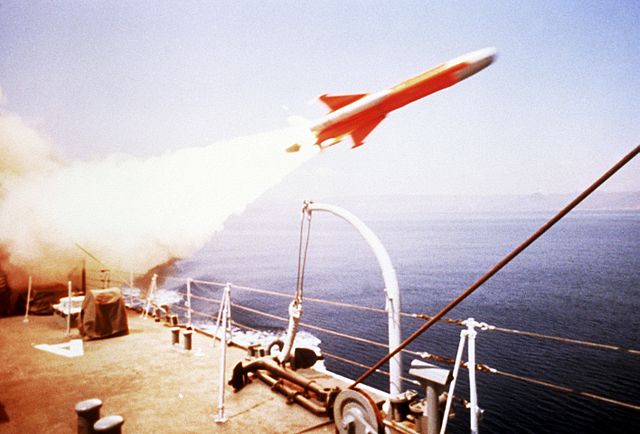
The Iraqi Navy fielded three types of missiles in 1993, the Silkworm (A 1968 chinese version of the Soviet P-15 Termit) on board the Osa class, and the Otomat see above, fielded by the Italian built Al Assad class class corvettes.
Following the ending of the Iran-Iraq war, delivery of the Italian_built warships was again held up by Iraq’s occupation of Kuwait in late 1990. Iraq suffered a severe defeat at the hands of Allied armies and navies in Operation Desert Storm in 1991, and the navy was one of the major casualties. All Iraqi naval vessels which ventured into the open sea during Desert Storm were either sunk or severely damaged, and others were destroyed or damaged in port. It is likely that all the missile boats, landing ships and minesweepers were sunk. Personnel strength of the navy had increased to 4600 men by 1989, but is impossible to assess accurately in the wake of the Desert Storm defeat. The Iraqi Navy has effectively ceased to exist as an operational force. FLEET STRENGTH 1947 Four ‘Thornycroft’ type patrol vessels, disp 67t, were launched in 1937 and, when no longer serviceable, were used as barracks. Numbered J—4, renamed Abd al Rahman, Al Ghazi, Dat Al Diyan and Janada.
The Battle of Babuyan:
The Battle of Bubiyan was a major naval engagement of the Gulf War off Bubiyan Island and close to the Shatt al-Arab marshlands. There, the Iraqi Navy attempted to flee to Iran when caught by Coalition warships and aircraft. Lynx helicopters of the British Royal Navy after being vectored on thse ships, used their Sea Skua missiles and wiped out 14 vessels (3 minesweepers, 1 minelayer, 3 TNC 45 Fast Attack Craft, 2 Zhuk-class patrol boats, 2 Polnocny-class landing ships, 2 salvage vessels, 1 Type 43 minelayer, and 1 other) in 21 separate engagements over 13 hours with a Canadian CF-18 Hornet fighter recording an official victory first. This happened during the Battle of Khafji in which an amphibious assault was spotted by the Coalition naval forces and promptly eliminated.
The last action of the Iraqi Navy was to fire a single Silkworm missile from an wheeled inland launcher at USS Missouri, intercepted mid-flight by a Sea Dart from HMS Gloucester and destroyed. This was also a first. After the Battle of Bubiyan the Iraqi Navy ceased to exist.
Strenght in 1990
-Training Frigate Ibn Khaldum (1978)
-4x Hittin class Frigates (Lupo class, 1983-85): Hittin, Thi Quar, Al Qadissiya, Al yarmouk
-6x Abi Sherh class missile corvettes (1982-84):
-3x Polocny D landing ships
-6x OSA I FACs
-8x OSA II FACs
-12x P6 class FACs
-3x SO-I clas Large Patrol Crafts
-2x Poluchat I class Large Patrol Crafts
-4x Zhuk class coastal patorl crafts
-2x Nryat II class patorl craft
-2x T43 class minesweepers
-3x Yevgenya class minesweepers
-4x Nestin class riverine minesweepers: Yugoslav built, transferred 1980, 3 still in 1995.
Training Frigates Ibn Khaldum (1978)

IBN KHALDOUM was a training frigate (Pennant 507) built at Titograd in 1978. Yugoslavian Training ship with frigate characteristics of Yugoslav design. Laid down 1977 aand in service 21 March 1980. The first of three such ships ordered — one for w the Yugoslav Navy which was never completed and the other named Hasr – Dewantara by Indonesia. Ships differ in machinery and armament (no helicopIt ter pad). These are handsome ships of similar appearance to the Vosper Thornycroft frigates of the Iranian, Brazilian and Nigerian navies. Ibn Khaldoum could carry four SSM. Used as a transport in the war with Iran. Renamed Ibn Manjd. Severely damaged February 1991, but remains afloat. Seems she was never repaired however and is not operational.
Specs:
Displacement: 1850t full load. Dimensions: 317ft 4in, 295ft 3in pp x 36ft 8in x 14ft 10in 96.7m, 90.0m x 11.2m x 3.6/4.5m
Machinery: 2 shaft CODOG (CP propellers), 1 Rolls-Royce Olympus TM-3B gas turbine: 22,000shp: 26kts
2 MTU 16V 956 TB 91 diesels 7500bhp: 20kts.
Range 4000nm at 20kts
Armament: 1-57mm/70 Bofors, 1-40mm/70,8—20mm AA (4×2), 2 ASW TT and ASW mortar, DC rack
Sensors: Radar Decca 1226, 1229, 1 search Philips 9LV 200 Mk II; sonar Plessey MS 26
Complement: 93 + 100 trainees
Hittin class Frigates
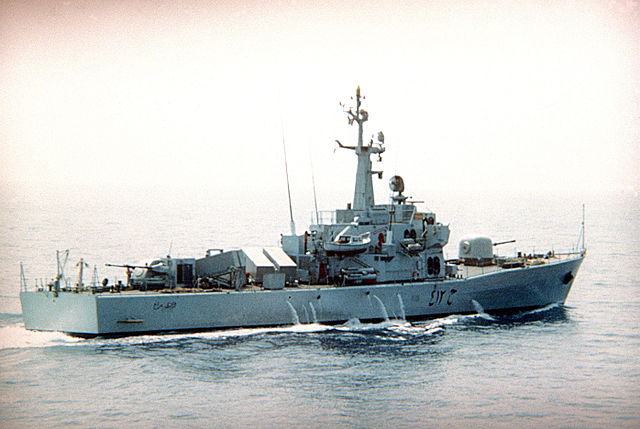
Class: F14 HITTIN (Fincantieri, lauhched 27.7.83, not delivered) F15 THI QUAR (19.12.84), F16 AL QADISSIYA (31.3.84), F17 AL YARMOUK.
The Assad-class corvette were originally built for Iraq during the Iran–Iraq War by Fincantieri in Italy. Six ordered in 1981, but they were completed just before Operation Desert Storm, and as Italy was part of the coalition following the invasion of Kuywait and ultimatum, these were never delivered due to the embargo.
Instead, four of these were sold to the Malaysian Navy, becoming the Laksamana-class corvettes in 1995. The two remaining ones were resold to La Spezia and kept in reserve, but in 2005 it was announced they would be delivered to the New Iraqi Navy until the deal was cancelled due to their general condition after inspection (rather poor). On 19 May 2017, La Spezia managed to have them drydocked and maintained, so after another inpection they were given the go ahead for delivererance to Iraq… after 26 years. On La Spezia they were loaded on the semi-submersible carrier Eide Trader on 22 May, reached Iraq in June 2017. Thir fate is uncertain as of 2024.
The Libyan Navy operated also four of these, Al Tadjier destroyed during the Libyan-US confrontation, Al Tougour, Al Kalij and Al Hudud which entered service 1977-1979 being scrapped in 1993.
Specs:
Displacement: 2213t standard; 2525t full load
Dimensions: 370ft lin oa, 347ft 9in pp x 39ft 4in x 12ft 7in 112.8m, 106.0m x 11.98m x 3.84m
Machinery: 2-shaft (CP propellers) CODOG, 2 Fiat/GE LM 2500 gas turbines, 50,000shp=35kts, 2 GMT A230-20M diesels, 7800bhp=20.5kts.
Range 900nm at 35kts, 3,450 nm at 20.5kts
Armament: 8 Otomat Mk II SSM, 8 Albatros SAM (1×8) with no reloads, 1-127mm OTO Melara, 440mm Breda Dardo (2×2), 6-324mm ASW TT, 2 AB 212 helicopters
Sensors: Radar 3RM20, RAN-11X, RAN-10S, 2—Orion RTN10XRCT, 2—Orion RTN-20X; hull sonar Edo 610E or Raytheon 1160B, 2-SCLAR chaff launchers
Complement: 185
Abi Sherh class missile corvettes
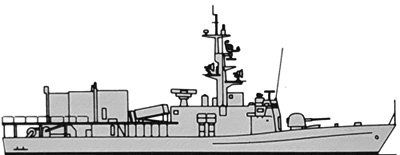
Class: F210 MUSSA BEN (launched 16.12.82, renamed NUSSAIR postwar), F212 TARIQ IBN ZIYAD (8.7.83, not delivered), F214 ABDULLAH IBN (5.7.83, Not delivered, ABI SERH postwar), F216 KALID IBN AL (5.7.83, Not delivered, renamed WALID postwar), F218 SAAD IBN ABI (30.12.83, Not delivered renamed WAKKAD postwar), F220 SALAH ALDIN (30,3.84, Not delivered renamed AYOOBI postwar).
The ABI SERH class missile corvettes were Six corvettes based on the ‘Wadi M’ragh’ design for Libya were ordered in 1981 by Iraq in two versions. The basic version (four ships F 214-220) is described below. Two other corvettes similar to the Ecuadorian ‘Esmeraldas’ class are fitted with telescopic hangar and landing pad for helicopter at a cost of four of the six Otomat SSMs. All these ships were completed in 1986 87 but never delivered as was the case with the Lupo type frigates. They are still in Italian hands, and although it had been proposed that the Italian Navy take them over, two were planned to be sold to Morocco and another two to Colombia, although by 1995 the sales never took place. In May 2014 however Iraqi-US authorities ordered an extensive refit, signed in 2016 and in 2017 two ships arrived to Iraq onboard the cargo vessel Eide Trader, Mussa Ben Nussair and Tariq Ibn Ziad. In service today, maintenance and operational readiness uncertain. As for the remainder in 1997-1999 they were sold and commissioned by Malaysian Navy as the Laksamana class.
Specs:
Displacement: 600t standard; 675t full load
Dimensions: 204ft 5in 0a, 189ft 8in pp x 30ft 6in x 9ft 2in 62.3m, 57.8m x 9.3m, x 2.8m
Machinery: 4 shafts, 4 MTU 20V956 TB956 diesels, 24,400bhp = 37.5kts.
Range 1200nm at 31kts, 4000nm at 18kts
Armament: 6 Otomat Mk II SSM, 1—Albatros SSM (1×4, 8 reloads), 1-76mm/62 OTO Melara, 2-40mm Breda Dardo (1×2), 6 ASW TT (2 x 3)
Sensors: Radar 3RM-20, RAN-12 L/X, Orion RTN-10X; sonar Thompson Diodon, 2-SCLAR chaff launchers
Complement: 51
Other cold war Iraqi ships
Polish POLNOCNY D class medium landing ships (Project 773): Anka (1977), FJanada (1977), Nowh (1978), Ganda (Sep 1979)
Four ships of ‘Polnocny D’ type built in Poland in 1976 80 by Naval Shipyard, Gdynia. Deck structure amidships acts as a helicopter platform and a stores lift, closed during helicopter manoeuvres. One lost to Iranian Harpoon missiles 1980 -81, two sunk 1991, one escaped to Iran.
OSA I class fast attack craft (missile) (Project 205): Haziram, Kanun Ath-Tham, Nisan, Tamuz, I, II.
Six ex-Soviet delivered in 1972 74, two stricken. Other destroyed in 1991. One defected to Iran 1991, one survived until 1995.
OSA IP class fast attack craft (missile) (Project 205M): Sa’d, Khalid Ibn, Al Walid, I IV
Eight boats of this Soviet type were delivered in pairs in 1974, 1975, 1976 and the last pair since then. Some names may be suspect. Two sunk by Iranian warships and two by Iranian aircraft since September 1980. Two replacements delivered 1984. One defected to Iran 1991, remainder lost 1991.
P 6 class fast attack craft (torpedo) (Project 183): Al Adrisi, Al Bahi, Al Shaab, Al Tami, Alef, Ibn Said, Lamaki, Ramadan, Shulab, Tamur, Tareq Ben Zaid, I, named unknown
12 units transferred from USSR; 2 in 1959, 4 in November 1960 and 6 in January 1961. Stricken as worn out. Pennant numbers included 217 222. Six sunk by Iranian forces since 1980, some by Harpoon missiles.
SO 1 class large patrol craft (Project 201M):
3 ships transferred in 1962. Employed as large patrol craft. Carry pennant numbers 310-312. All sunk 1991.
POLUCHAT TP class large patrol craft:
2 Poluchat type were transferred from USSR in late 1960s. Used as patrol craft or for torpedo recovery. One sunk 1991, two survived 1995.
ZHUK class coastal patrol craft (Project 199):
Five transferred to 1975. Three sunk 1991, two extant 1995.
NYRYAT II class patrol craft:
2 multi-purpose craft possibly employed as diving craft. There are also two x-Soviet PO 2 (Pozarnyy 2) type fire boats of very similar design.
T 43 class ocean minesweepers Class: Al Yarmouk (465), Al Kadisia (467)
Built in mid-1950s and transferred to Jraq in early 19708. Pennant numbers changed to 412 and 417, Both sunk 1991.
YEVGENYA class inshore minesweepers:
3 GRP-hulled inshore minesweepers were delivered in 1975 Ostensibly as ‘oceanographic craft’. Armed with 2 25mm. One lost 1991, 2 survived, fate uncertain.
NESTIN class river mineseweepers: Yugoslavian built, 4 transferred in 1980. Three extant in the 1990s
US Occupation and the iraqi Navy Today
2004-2008 birth of the ICDF
In January 2004, the Iraqi Coastal Defense Force (ICDF) were recrated under the new US-backed authorities, with a core of 214 volunteers. On 30 September 2004, it was established to protect the Iraqi coastline, and started operating on 1 October 2004. By 11 November 2008, Rear Admiral Muhammad Jawad signed the Khawr Abd Allah Protocols or “KAA Protocols” at the Kuwait Naval Base after a concept of the British Royal Navy under the Combined Task Force 158 (northern Gulf region) to give a base to access and patrol Iraqi territorial waters aimed at the oil terminals Al Basrah. These were non-legally binding so to defuse any tension between Kuwait and Iraq for the use of the Khawr Abd Allah waterway, based on the British Hydrographic Office chart.
They were written and mediated by a British Royal Marine barrister: Lt. Col. David Hammond wotking with the Kuwaiti Navy and Iraqi Navy commands, in a reunion on HMS Chatham (F87) on 8 May 2008. They were ratified and signed on 11 November 2008 at the Kuwait Naval Base. Were present VADM William Gortney of the USN (Naval Forces Central Command, Bahrain). From 30 April 2010, Iraqi naval forces were tasked of the protection of the Khawr al-Amaya and Basra oil terminals and the ports of Umm Qasr and al-Zubair with mostly OPVs. List below.
Organization:
-Iraqi Naval Headquarters: Baghdad (Camp Victory), with plans to move to Umm Qasr.
-Operational Headquarters at Umm Qasr with tactical Operations Centers at Khawr al-Amaya and Al Basrah Platforms
-Naval Training Center at Umm Qasr, comprising a NCO Academy, Swiftboat Crew Training Course, Diving Squadron
-Maritime Academy at Basrah
-Patrol Squadrons at Umm Qasr: PS701, PS702, PS703, PS704, PB301, PB302, PB303, and five U/I PBs, see list three more planned.
Also Umm Qasr Support & Auxiliary Squadron.
Iraqi Marines:
1st Marine Brigade Special Troops Battalion at Basrah, full strength in 2011.
Battalions at Umm Qasr, Umm Qasr/Az Zubayr, and two at Basrah Log City
Total personal today: 5,400 sailors and officers, plus 1600 in the Iraqi marines guarding oil platforms in Umm Qasr.
List today
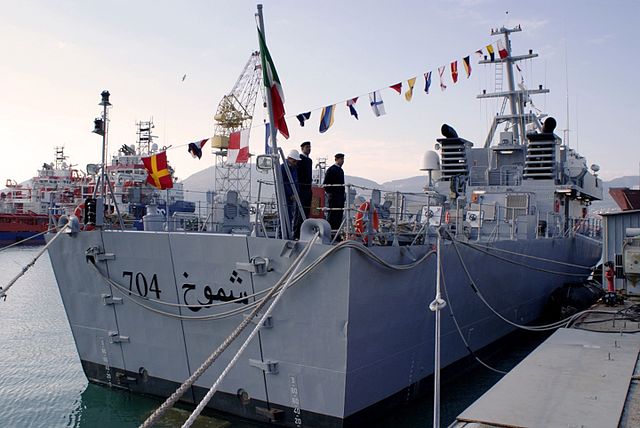
On 15 February 2005 the Iraqi Navy signed a $101 million contract with the Italian Government to provide four Saettia MK4 class Offshore-Patrol Vessels, a modified Diciotti class used by the Guardia Costiera. From Riva Trigoso they were modified for a crew of 38 and included logistical support, crew training over 7-week in cooperation with the Marina Militare whjch including a bridge simulator course at the Academy in Livorno. By May 2009, 701 Fatah was handed over at Muggiano, La Spezia. The crew trained since January 2009, and made the 20 days trip to Umm Qasr, a shakedown cruis of 5,000 nautical miles via the Suez Canal and Red Sea. These are intended only to defend Iraqi EEZ, control maritime traffic, SAR and fire fighting.

Fifteen (15) 35-meter Patrol Vessels (P301–P315) were built by Swiftships in the US back in 2011–2014 to provide logistical support for the oil platforms and protect Interceptor boats plus the Fast Attack boats.
Model 35PB1208 E-1455, 35.06 x 7.25 x 2.59 m, powered by 3x MTU 16V2000 Marine Diesels to 30 knots, 12 knots cruising, Range 1,500 nm (2,800 km; 1,700 mi) at 12 knots, 6 days at sea.
Armed with an MSI 30mm DS30M Mark 2 Cannon, one 50 cal/ 12.7mm MG and two 7.62mm MGs plus carrying a 7m Willard Rigid Inflatable Boat, crew 25.
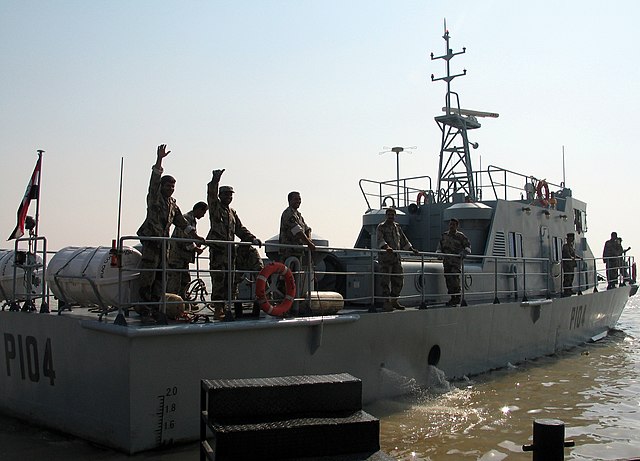
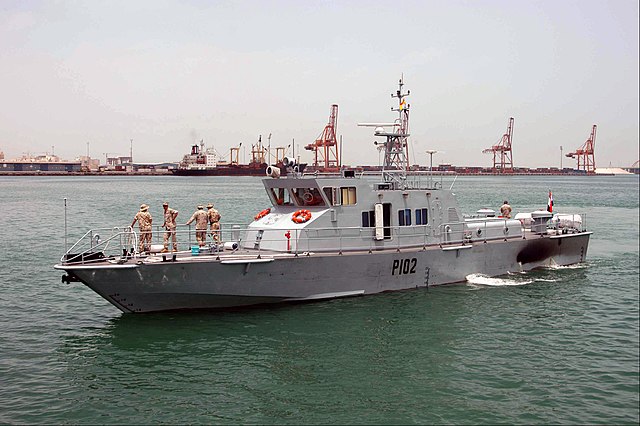
The Predator class P101 to P-105 27-meter NHS615 Class patrol boats were built in China by Wuhan Nanhua High-speed Ship Engineering Co., Ltd. delivered in 2002. Purchased under the oil-for-food program. Top speed 32 knots, Crew 14, unarmed but personal small arms only.
-Tariq ibn Ziyad (F212): Assad-class corvette (sole remaining)
-4x Saettia/Fattah class (Ita. Diciotti class): Fateh (PS 701), el-Naser (PS 702), Majid (PS 703), Shmookh (PS 704)
-2x Al Basrah class OPVs: Al Basra (OSV 401), Al Fayhaa (OSV 402)
-15x Swiftships Model 35PB1208 E-1455 FACs
-10x Predator class FACs
-24 Fast Aluminum Boats
-10 Rigid-hulled inflatable boats
-1 supply vessel Al Shams.
Sources
on navypedia.org/
loc.gov/ iraq country study
globalsecurity.org/
longwarjournal.org/ iraqi security force
longwarjournal.org/ OOBpage15 Equipment.pdf
abcnews.go.com/
navaltoday.com/ 2013 news
en.wikipedia.org Iraqi_Navy
 Jordanian Navy
Jordanian Navy
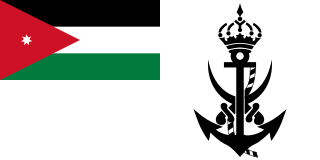 The Royal Jordanian Navy is an oddity since the country is landlocked except for its southern extremity, presenting a coast just 26 kilometres (16 mi) wide along the Gulf of Aqaba allowing at least a vital trade access to the Red Sea. There she had 27 patrol boats and 700 personnel, with the 77th Marines Reconnaissance Battalion and the small green water naval force is under command of the army.
The Royal Jordanian Navy is an oddity since the country is landlocked except for its southern extremity, presenting a coast just 26 kilometres (16 mi) wide along the Gulf of Aqaba allowing at least a vital trade access to the Red Sea. There she had 27 patrol boats and 700 personnel, with the 77th Marines Reconnaissance Battalion and the small green water naval force is under command of the army.
This small fleet today is part of maritime Combined Task Force 152 securiig the Persian Gulf.
Birth in 1951: Royal Coast Guard
The Royal Coast Guard was established in Aqaba and comprised infantry, a company of 200 men with a few small boats. In 1952 its Headquarters was moved to the Dead Sea until 1967. In 1974 it otained its first vessels, four medium patrol boats of the British Bertram Class equipmed to operate divers and frogmen. From there, it was renamed the “Royal Jordanian Navy” but remained under supervision of the army, basicaly its naval force projection department. In practice it stays as coast guard and by 1988 at the end of the cold war, reached 300 officers, still based in Al Aqabah, the Jordanian sole port on the Red Sea.
At the time, the Navy consisted of five US-built coastal patrol boats armed with light machine guns. It was tasked of harbor security, worked with the customs and immigration and fishery protection. By late 1987 the Navy was extended by the acquisition of three larger 90 tons craft built in British yards each with a crew of 16 and 20mm, 30mm guns. They became somewhat of a concern for the nearby Eilat IDF base, both however have only lightly armed patrol boats.
Cold war ship’s list
Officially the navy was stated in 1969 providing the Hashemite Kingdom a Coast Guard, “Jordan Sea Force” taking orders directly from the Army Director of Operations at GHQ. There used to be also a Dead Sea flotilla, which no longer exist ed at the end of the cold war. The Sea Force base had been and stays as at Aqaba with a presonal in 1995 that amounted to 750 officers and ratings. In the late 1980s the king decided that three small fast attack craft should be ordered for patrolling the 12-mile maritime border on the Gulf of Aqaba. Three boats were ordered from Vosper in the United Kingdom and delivered in 1991, a considerable increase in Jordan’s naval forces.
HAWK class fast attack craft (gun)
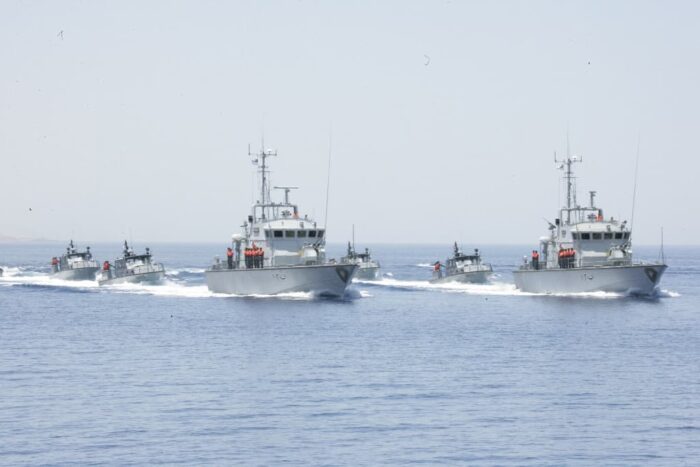
class: AI Hussein (101, Dec 1989), Al Hussan (102, Mar 1990), Abdullah (103, 1991)
Ordered in December 1987 from Vosper Thornycroft. GRP construction. Up to seven were sought. Transported to Aqaba in September 1991 on a merchant vessel.
Specs:
disp. 124t 100ft x 22ft 8in x 4ft 1 lin (30.5m x 6.9m x 1.5m), 2 shafts MTU 16V 396 TB94 diesels 5800bhp = 32kts. Range 750nm at 15kts, 1500nm at 11kts, armed with 2x 30mm Oerlikon GCM-A03 (1×2), 1-20mm Oerlikon GAM-B01, 2×12.5mm MG, 2 Wallop Stockade chaff RL. Radar Kelvin Hughes 1007, fire control Radamec Series 2000 optronic; combat data system Racal Cane 100. Crew 16 (3 officers). Still active.
Rotork class patrol craft
Al Hashim, Al Fatsal, Al Hamza; delivered late 1990. Specs: 9t, 41ft 8in, 240bhp = 28kts, 1x 7.62mm MG), extant 1995
Bertram class CPCs
-Four US-built 38ft Bertram ‘Enforcer’ type coastal patrol craft (8t, 25kts, 3 MG) acquired in August 1974: Faysal, Han, Hasayu and Muhammed. All extant 1995
-Two US-built 30ft Bertram type coastal patrol craft (6.5t, 25kts, 3 MG, 8 crew): Ali and Abdullah, GRP hulls. Acquired 1974, both stricken 1992
Shorough class IPC
Two ex-GDR ‘Bremse’ class inshore patrol craft (42t, 74ft, 14kts, 1-12.7mm MG):
Shoroug I (ex-G 30/GS 5), Shoroug II (ex-G 31/GS 42), built 1971-72, transferred from Germany 1991, both extant 1995.
The Royal Naval Force Today
In 1991, the Coast Guard provided three Hawk Class vessels and on 13 November 1991 it was at last renamed the “Royal Naval Force”. A new acquisition program to replace old units was signed at IDEX 2009 exhibition between Dr. Moayad Samman (CEO of King Abdullah II Design and Development Bureau) for a joint venture with Mr. Mark T. Hornsby from RiverHawk Worldwide LLC to create a locak shipyard, RiverHawk Shipbuilding and Support, PSC. Kaddb-RiverHawk were tasked of providing Shipbuilding and Support for the AMP-137 Advanced Multi-mission Platform Vessels.
Naval Command HQ:
- Command Staff & Naval Signal Company
- Combat Vessels Group
- Naval Frogmen Group
- 77th Marine Battalion
- Naval Special Boat Unit
- Counter-terrorism Team from Special Unit-II
- Marine Surveillance Company, Aqaba
- Marine Surveillance Company, Dead Sea
- Technical Support Group
- Maritime Training Center
List of Jordanian ships as of 2024
3x Al-Hussein class VT Hawk class, 2 × 30 mm guns, 1 × 20 mm gun, 2 × 12.7 mm HMG
2x Al-Hashim class Type 412 class, 1 × 12.7 mm MGs.
8x Abdullah class 2 × 12.5 mm MGs.
4x Faysal class Bertram type, 1 × 12.7 mm MGs.
4x Faysal class Command vessels, 2 × 12.5 mm MGs.
4x AMP-137 PB locally built by Built by KADDB, unarmed.
2x Falcon class with a Rafael remote controlled system, 7.62 mm MG.
Special Force boats
8x RHIB special forces
4x 17 ft launch boat
4x 19 ft GRP boats
2x Light craft SRB special forces
Sources
Conways all the world fighting ships 1947-95 page 243
country-data.com/
combinedmaritimeforces.com
combinedmaritimeforces.com/
jaf.mil.jo/
x.com/Nashab_32
hyperstealth.com
shipshub.com
navypedia.org/
globalsecurity.org/
 Kuwaiti Navy
Kuwaiti Navy
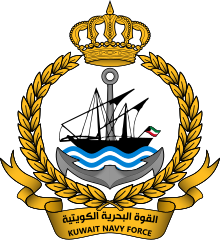 The Kuwait Naval Force (Al-Quwwat Al-Bahriyah Al-Kuwaitiyah) was created in 1961 as part of the Armed Forces. Its headquarters and naval base today is Mohammed Al-Ahmad Kuwait and is 2,200 personal strong, excluding 500 coast guard personnel. The latter is a Border Security Directorate under the Ministry of Interior. Kuwait as a country (the name means fortress on the sea) is bordering the persian gulf, the capital.
The Kuwait Naval Force (Al-Quwwat Al-Bahriyah Al-Kuwaitiyah) was created in 1961 as part of the Armed Forces. Its headquarters and naval base today is Mohammed Al-Ahmad Kuwait and is 2,200 personal strong, excluding 500 coast guard personnel. The latter is a Border Security Directorate under the Ministry of Interior. Kuwait as a country (the name means fortress on the sea) is bordering the persian gulf, the capital.
History
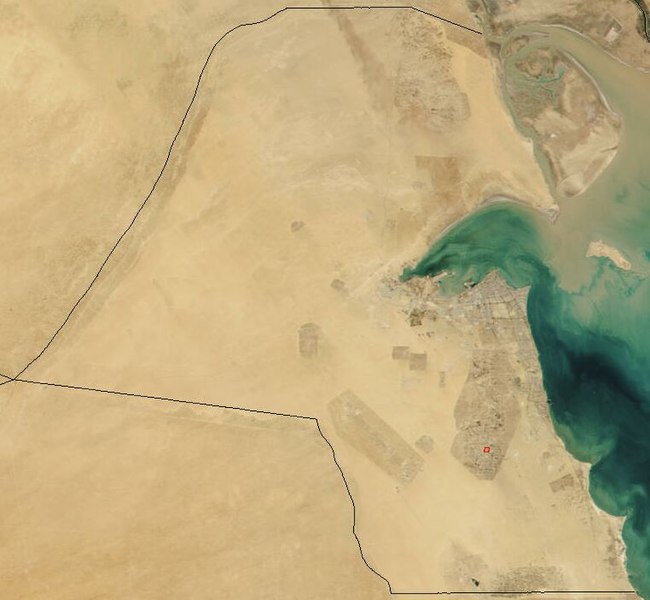
Kuwait as a unique city state historically semi-independent was born under the Sassanids inside a protected bay, ideal as a fishing and later trade port in the region. The country also shares land borders with Iraq and Saudi Arabia, maritime borders with Iraq, Saudi Arabia, and Iran, easing trade, notably with Basra.
Around 1700 it was still a small fishing village, under the rule of the Sheikh of the Bani Khalid clan. It became independent in 1752 as a Sheikhdom and at the end of the century a rapid development made it a hub of trade between Baghdad, India, Persia, Muscat, and the Arabian Peninsula. In the 19th Century its development went on and around 1900 its informal Navy was composed of traditional Arabic vessels, Baghiyas, Baghalas, Baqarah and Dhows, the latter being the largest and armed with bronze cannons. Kuwait’s boat-building tradition are still proudly exhibited today, and the city had a dozen or more shipyards. Some are still in activity today producing this traditional wooden boats. Before that, British influence over the city grew from the East India Company which settled in Kuwait in 1792 to control trade in the area, whereas Basra’s leading merchants fleeing Ottoman persecution to Kuwait made the city more prosperous than ever, and it was before finding oil.
With the Anglo-Ottoman Convention of 1913, Kuwait was established as an autonomous kaza (district) of the Ottoman Empire and, but de facto protectorate of Great Britain. This had consequences as in 1914 its rulmer, Salim Al-Mubarak Al-Sabah, supported the Ottoman Empire. Britain this started a blockade of the city which crippled its economy.
Postwar the need to establish a commercial city in the south of Kuwait caused a diplomatic crisis with Najd. This ultimately led to the Battle of Hamdh and Battle of Hamdh against the Ibn Saud’s warriors, the Ikhwan, which motly repelled the kuwaiti. Help from British troops, who showed up with airplanes and three warships settled the peace between the two. Perhaps the successes of this first border war emboldened Ibn Saud of Najd to to annex Kuwait, leading to the Kuwait–Najd War of 1919–20.
Even after beiong settled again by Britain, Ibn Saud imposed a trade blockade against Kuwait from the years 1923 until 1937 and raided almost yearly the city by sea and land. The Great Depression also further harmed Kuwait’s economy, but had already lost its prominence in long-distance trade, notably by not modernizing its facilities for more modern vessels and the Kuwaiti being intermediary merchants the decline of European demand for goods from India and Africa compounded the problem. Some however prospered by gold smuggling to India. It even became the world’s leader for pearl industry, regularly sending out between 750 and 800 ships. But it was struck by the fall in demand in the early 1930s and Japanese invention of cultured pearls.
Attempts made by King Faisal I of Iraq to build a railway to Kuwait and better port facilities in the Gulf were rejected by Britain and this fed Arabic nationalism. This crystallized as the Kuwaiti people opposed the British imposed separation of Kuwait from Iraq and in 1938, the “Free Kuwaiti Movement” gained traction. In March 1939 there was a popular armed uprising within Kuwait to reunify with Iraq. This was prior finding gold and important to understand the 1990 invasion of the country by Iraq.
Indeed, oil, the new gold, was found within the country in 1938, discovered in commercial quantities in the Burgan field allowing commercial production. In June 1946, the late Amir of Kuwait, Sheikh Ahmad Al-Jaber Al-Sabah inaugurated export and first shipment of crude oil.
From there, prosperity returned like a whirlwind.
This were the golden years of the country with an unprecedented development that went on in a liberal cultural atmosphere and with a massive public contruction programme creating new facilities and extending the city several fold. In June 1961, Kuwait became independent with the end of the British protectorate, Sheikh Abdullah Al-Salim Al-Sabah became Emir. The armed forces were created and notably the Navy. The Kuwaiti navy is thus today “only” 60+ years old, and during the British evacuation (Operation Vantage), a few patrol vessels were left.
Gradual contruction of the Navy 1961-1990
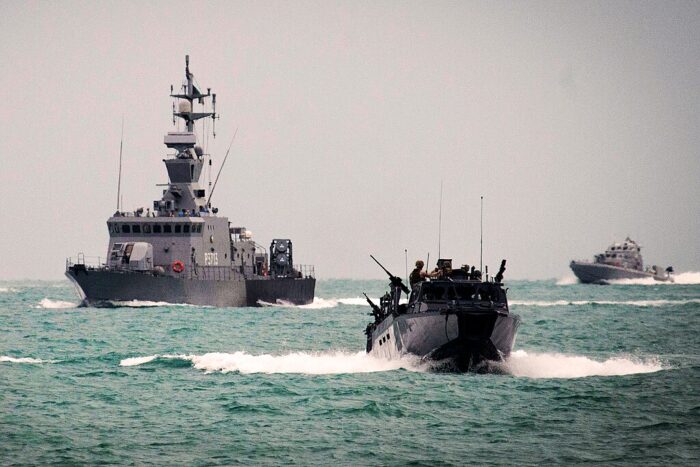
The Kuwaiti navy was primarily a coast guard force, controlled by the Ministry of the Interior and consisting of lightly armed patrol craft (delivered from 1966 onwards) and a number of small landing craft, Naval personnel totalled about 2100 in 1989, almost double the total in 1982.
Lürssen ‘TNC 45” type fast attack craft (nissile)
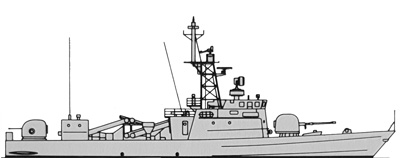
Class: Wenja (K 451, 26.4.84), Mashuwah (K 452, 26.4.84), Jalboot (K 453, 26.4.84), Istiglal (K 455, 9.8.84), Al Ahmadi (P 4509, 9.8.84), Al Mubarekt (P 4511, 9.8.84)
Ordered at Lürssen Werft 1980 to the standard TNC 45 design. All launched 1982 83. First four and the sixth renamed and renumbered soon after completion as Al Boom (P 4501), Al Betteel (P 4503), Al Sanbouk(P 4505), Al Saadi (P 4507) and Al Abdali (P 4511). Al Sanbouk escaped to Bahrain 1990 upon Iraqi invasion of Kuwait, but the others were captured and taken over by the Iraqi Navy, only to be sunk or heavily damaged in February 1991 during Operation Desert Storm. Only A! Sanbouk extant 1995.
Specs
Displacement: 228t standard; 268t full load
Dimensions: 139ft 9in pp, 147ft 4in oa x 24ft 3in x 7ft 7in 42.3m, 44.9m x 7.4m x 2.3m ;
Machinery: 4 shafts, 4 MTU 16V538 TB92 diesels, 14,400bhp = 40.5kts. Range 500nm/1600nm at 38kts/1 6kts
Armament: 4 MM40 Exocet SSM (2×2), 1-76mm/62 DP OTO Melara (250rds), 2-40mm/70 Breda-Bofors Compatto (1×2; 1800rds)
Sensors: Radar Decca 1226, HSA WM-28; ECM Decca Cutlass RDL-2 Dagaie chaff RL
Complement: 40
Lürssen ‘FPB 57’ type fast attack craft (missile)

Class: Isnglal (P5702, Aug 1983), Sabhan (P 5704, 9.8.84)
Two modified FPB 57 fast attack craft ordered 1980 at Lirssen Werft, Vegesack, Germany. Launched 1982 83. Originally scheduled to enter service 1982 and 1983 respectively. Had much larger superstructure amidships than typical FPB 57 type boats. Functioned as leaders for six TNC 45 type boats. Fitted with CSEE Lynx optical sight. Early in their careers armed with MM38 missiles. Istiglal escaped to Bahrain August 1990 when Iraq invaded Kuwait. Sabhan was captured and sunk February 1991 during Operation Desert Storm.
Specs
Displacement; 350t standard, 425t full load
Dimensions: _190ft 7in oa x 25ft x 8ft 10in 58.1m x 7.6m x 2.7m
Machinery: 4 shafts, 4 MTU 16V 956 TB91 diesels, 15,000bhp = 36kts. Range 1300nm at 30kts, 700nm at 35kts
Armament: 4 MM40 Exocet SSM (2×2), 1 76mm/62 OTO Melara, 2-40mm/70 Breda (1×2), fitted for minelaying, Dagaie chaff RL
Sensors: Radar Marconi S 810, Decca TM 1226C, fire control PEAB 9L.V228 (with 9LV200 search and tracking radars); ESM: Racal Cutlass
Complement: 40 (4-5 officers)
ASI 315 type large patrol craft
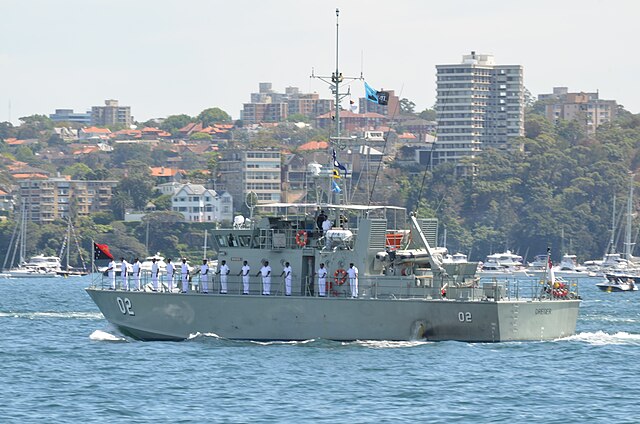
Class: Innisar (P 301, 20.1.93), Aman (P 302, 20.1.93), Maimon (P 303, Jun 1993), Mobark (P 304, Jun 1993)
First two were ordered from Australian Shipbuilding Industries in 1991, Second pair July 1992. Built to proven ASI 315 design widely exported to small Pacific nations. Durable steel hull and aluminium superstructure. Small engine and waterjet propulsion used only for cruising during extended patro} work.
Specs
Displacement: 150t full load
Dimensions: 88ft 1 lin pp, 123ft oa x 21 ft 4in x 6ft Tin 27.1m, 37.5m x 6.5m x 2.0m
Machinery: 2 shafts, 2 MTU 16V 396 TB94 diesels, 5800bhp = 28kts; 1 Hamilton 422 waterjet for cruising, 1 MTU 8V 183 TB 94 diesel, 750bhp. Range 300nm at 28kts
Armament: 1 20mm Oerlikon, 1 7.62mm MG
Sensors: Radar navigational, surface search
Complement: 11 officers and sailors
Thornycroft 78ft type coastal patrol boats
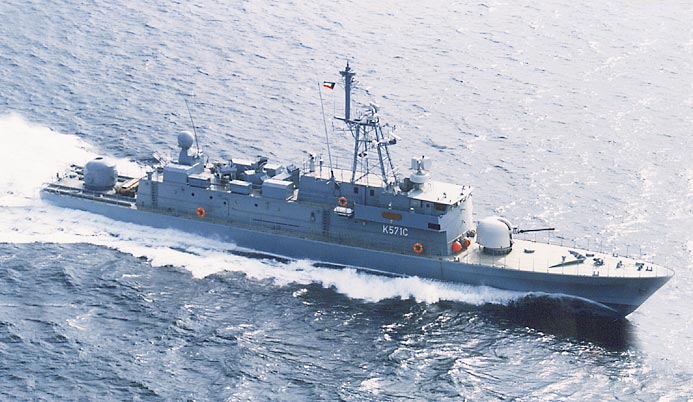
Class: Al Salemi (30.6.66), Al Shurtt (1972), Al Mubaraki (16.7,.66), Aman (Mar 1968), Intisar (1972), Marzook (1969), Mashoor (1969), Maymoon (Apr 1968), Mrashed (1970), Wathah (1970)
Two built by Thornycroft before their merger with Vosper and eight after the merger. Al Salen’ and Al Mubaraki shipped to Kuwait on 8 September 1966 and the last pair A/ Shurt’ and Intisar in 1972.
Welded steel hulls, aluminium alloy superstructures. Twin hydraulically operated rudders, Decca type D202 radar. Modified superstructure and no funnel on later. Designed to have 1-40mm.
Specs
Displacement: 40t standard
Dimensions: 78ft x 15ft 6in x 4ft 6in 25.5m x 4.7m x 1.4m
Machinery: 2 shafts, 2 cyl Rolls-Royce V8 marine diesels, 1340bhp max, 1116bhp = 20kts. Range 700nm at 15kts
Armament: Reported 1 MG or unarmed
Complement: 12
Vosper 56ft coastal patrol boats
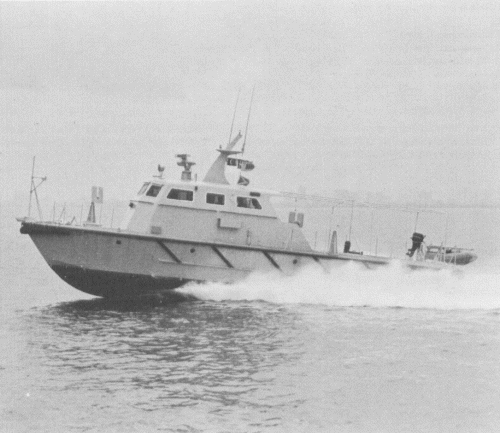
Class: Dastoor, Kasar, Qahir, Sagar, Salam, and probably one with unknown name.
First two ordered September 1973 and built by Vosper Thornycroft Ltd, Singapore, laid down 31 October 1973 and commissioned June 1974. Steel hulls and aluminium superstructure. Three more ordered in 1978. Built by Vosper Private Ltd and commissioned 1979. French source gives two types — first two units built 1974 armed as above and later four with 2 20mm AA (2×1). Second pair ordered 10 March 1977, in service December 1978 and third pair ordered July 1978, in service 1979. Lost to Iraq 1990.
Specs
Displacement: 25t
Dimensions: 56ft lin x 16ft lin x 4ft 3in/7ft 7in 17.1m x 4.9m x 1.3m 2.3m
Machinery: 2 shafts, 2 MTU MB 6V331 diesels, 1350bhp = 26kts for first two and 1800bhp = 29 30kts for last 3 or 4 boats. Range 320nm at 20kts
Armament: 1x 20mm, 2x MG
Complement: 8
Vosper 46ft coastal patrol craft
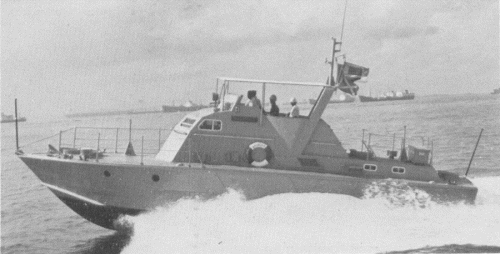
Class: Mahroos
Built by Vosper Thornycroft Ltd, Singapore. Ordered October 1974, delivered 1975 and commissioned January 1976. Hull is of welded steel construction with aluminium superstructure. Originally not armed. Extant 1990.
Specs
Displacement: 21.5t
Dimensions: 46ft 3in x 14ft 5in x 3ft 1lin, 7ft 2in max 14.1m x 4.4m x 1.2m, 2.2m
Machinery: Probably 2 shafts, 2 Rolls-Royce C8M-410 diesels, 780bhp = 21-21.7kts
Armament: Can mount 2—20mm AA (2×1), 2-7.62mm MG
Complement: 5
Vosper 36ft coastal patrol craft
Class: Amar, Al Salmi II, Al Sebbah, Istiglal If, Qarah, Warbah and eight unnamed
All built by Vosper Thornycroft, Singapore. Wooden construction with nylon sheathed hulls. First four unnamed delivered in 1972, second four unnamed in service 1973. Six stricken 1987. Remaining two extant 1990. First three named boats in service 1976 and last three on 2 December 1977. All named boats lost to Iraq 1990.
Specs
Displacement: 6.8t full load
Dimensions: 36ft 5in oa x 10ft 10in x 5ft 3in 11.1m x 3.3m x 1.6m
Machinery: 2 shafts, 2 Sabre 210 turbocharged diesels, 420bhp = 27kts
Armament: 4-7.62mm MG (2×2)
Complement: 4
South Korean ‘SEAGULL’ type patrol craft
First 5 ordered 1985 at Korea SB & Eng, Pusan, and delivered 1986. All captured by Iraq 1990 and destroyed February 1991, Second series of five boats ordered 1988 but not delivered before Iraqi invasion. Locally known as ‘Sawahil 35’ class.
LOADMASTER Mk IP type Logistics landing craft
Class: Al Saffar (L101), Al Seef (L 102), L 103, Al Baldani (L 104)
Ordered from Cheverton 1982. Original design taken over by Fairey Marine, Cowes. First pair completed October-November 1984, second pair September 1985, Can carry 601 liquid cargo and 901 dry cargo or accommodate two 60t main battle tanks. There are 50 places for seated passengers. Bow ramp four metres wide. Lost to Iraq August 1990.
Specs
Displacement: 175t light; 3501 normal; 420t full load
Dimensions: 1 08ft 3in oa x 33ft 6in x 5ft 9in 33.0m x 10.2m x= 1.75m
Machinery: 2 shafts (Kort nozzles), 2 Caterpillar 3412 DITA diesels, 1214bhp = 10.5kts.
Range 1000nm at 10kts
Armament: none
Complement: 7 (1 officer)
*There were also six SRN6 MKS type hovercraft operated by the Coast Guard, built by British Hovercraft, Cowes, which were operational in 1990.
Vosper type Logistic landing craft
Class: Hadiva, Ceriff, Al Fahra
All built by Vosper Private Ltd, Singapore. Ordered July 1978 and commissioned 1979. Unusual design with stern landing ramp. Lost to Iraq 1990.
Specs
Displacement: 1701/320t
Dimensions: 1 05ft llin x 24ft 7in x 8ft 2in 32.3m x 7.5m x 2.5m
Machinery: 2 shafts, 2 Rolls-Royce C8M-41D diesels, 750bhp = 9.5kts. Range 1500nm at 9kts
Armament: None
Complement: Unknown
Vosper type landing craft
Class: Waheed, Fareed, Regga
Built by Vosper Thornycroft Ltd, Singapore. First two ordered 1970 and third October 1974 by Kuwait Ministry of Interior. Able to carry 6400 gallons oil, 9400 gallons water and 40t deck cargo; a 2.5t derrick employed. Supports landing-parties working on islands offshore. Lost to Iraq 1990.
Specs
Displacement: 88t standard; 170t full load
Dimensions: 88ft 7in x 22ft 8in x 4ft 3in 27.0m x 6.9m x 1.3m
Machinery: Probably 2 shafts, 2 Rolls-Royce C8M-41D diesels, 752bhp= 10kts.
Range 1500nm at 9kts
Armament: None
Complement: 9 (can carry 8 passengers)
AL TAHADDY class logistic landing craft
Class: Al Tahaddy (1. 401, 1994), Al Soumood (L 402, 1994)
Two logistic landing craft ordered after the Gulf War to replace lost Loadmaster Mk II type from Singapore Shipbuilding and Engineering Ltd, delivered 1994. Capacity 80t cargo plus 5 containers (5 TEU). Standard design with bow ramp, open cargo deck and machinery and superstructure aft. Fitted with smal] articulated cargo crane.
Specs
Displacement: 130t standard; 250t full load
Dimensions: 141ft lin x 32ft 10in x 5ft 1lin 43.0m x 10m x 1.8m
Machinery: 2 shafts, 2 MTU diesels = 13kts
Armament: None
Complement: Unknown
OTHER SMALL CRAFT
-12x Simmoneau Standard 12 type small patrol boats (10t, 45ft ]lin x 12ft 6in x 2ft 4in, 14.0m x 3.8m x 0.7m, 2 inboard Caterpillar engines, 850bhp = 40kts. 1-12.7mm, 1-7.62mm MG, complement 4): built by Simmoneau Marine, delivered 1993.
-17x Cougar type fast inshore patrol boats: three Cat 900 (32f1), three Cat 1000 (33ft), three Predator 1100 (35ft), four Type 1200 (38ft), four Type 1300 (41 ft): all racing hulls acquired 1991-92 as a stopgap measure. All armed with 1-7.62mm MG.
-33x Al-Shaali type inshore patrol boats: thirteen 33ft, twenty 28ft: built by Al-Shaali Marine, Dubai 1992.
Pre-1990 assets and invasion by Iraq
Both the navy and the naval air force were taken by surprise by the Iraqi invasion in August 1990, and all but two fast attack craft were captured intact by the invaders. The captured vessels were used by the Iragis during Operation Desert Storm, and all were badly damaged or sunk by the Allied forces, many by Sea Skua missiles; the ex-Kuwaiti vessels were virtually defenceless as Iraqi personnel were not familiar with their systerns.
In general, the Gulf War has shown that small fast attack craft are less effective than was hitherto almost universally assumed. They are very vulnerable to helicopter missile attack, and at high speed their masts vibrate so much that their pencil-beam radars have difficulty locking on to targets. The only obvious solution to the problems of such craft is to fit them with fire-and-forget SAM missiles for close-in air defence. During the Invasion and Operation Desert Storm the Navy was almost completely destroyed and at the start of the invasion, the Iraqi Navy captured and sank five Kuwaiti Lürssen TNC-45 type fast attack craft, one Lürssen FPB-57 type fast attack craft. 20 other ships were also lost: Five Seagull, Fifteen Thornycroft, one Halter Marine and seven Magnum Sedan patrol craft, four Loadmaster and six Vosper Singapore type landing craft, ten tugs and launches, twelve Super Puma helicopters, and three Azimut launches of the Customs service.
Some of the vessels captured by Iraq which survived the Gulf War afloat were returned to their rightful owners, but in their damaged and unserviceable condition they are of little value and it is probable that most or all of them will be scrapped after the removal of any useful equipment remaining. The Kuwaiti Navy is actively pursuing its new construction plans, which include the acquisition of two corvettes and two 34m landing craft in 1995, and for the future three minehunters, two diving support vessels and a training ship. Eight large patrol vessels are to be ordered in France.

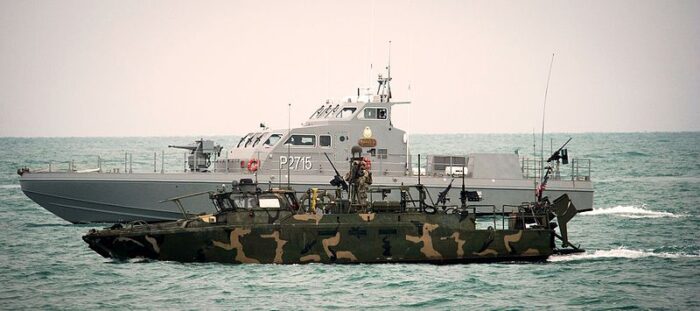
Riverine command boat 802 and OPV P2715
Postwar reorganization and up to this day
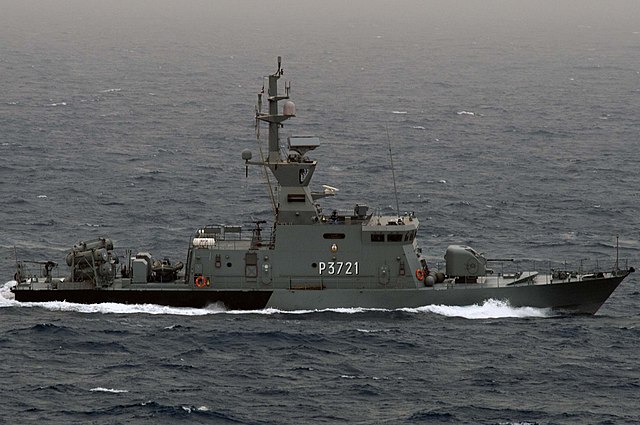
OPV Al Fahaheel, P3721
On 11 November 2008, the Kuwait Naval Base was used for the historical signing of the non-legally binding maritime Khawr Abd Allah Protocols (KAA Protocols) by the heads of the Kuwaiti Naval Force and Iraqi Navy, first formal and successful maritime bilateral military agreement for de-confliction of the Khawr Abd Allah waterway since the Gulf War. The protocols were developed and mediated by Major David Hammond RM, British Royal Navy barrister, ratified by both the Kuwaiti and Iraqi governments before the signing, reported to the US Congress within the December 2008 in “Measuring Stability and Security in Iraq”. The protocols became public knowledge after leaks in US diplomatic notes.
The Structure and Organization of thd current navy is between Naval Warships, the Kuwait Marine Corps and Kuwait Commando Marine Units.
Both shares a number of vehicles, among which US-provided Humvees.
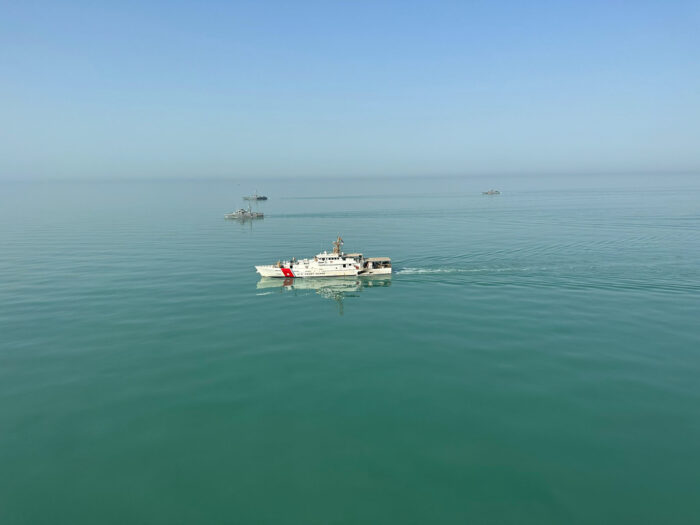
Al Maradim (Combattante P37-BRL)
class: Um Almaradim, Ouha, Failaka, Maskan, Al Ahmadi, Al Fahaheel, Al Yarmouk, Garoh
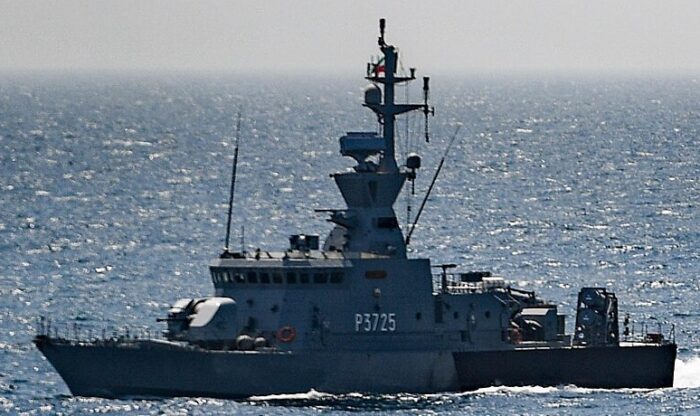
CMN P37BRL design ordered in 1995 from CMN Normandy with a Steel hull and aluminium superstructure. Missile-armed, with Sea Skua SSM and 6 Sadral SAM.
Delivered 1998-2000.
Specs
https://naval-encyclopedia.com/wp-admin/plugins.php
Displacement; 225t standard, 250t FL, Dimensions 42 x 8.50 x 1.90m.
Machinery 2 waterjets; MTU 16V538 TB93 diesels 8000 hp 30 kts, 30t oil 1350 nm/14 kts
Armament: 2×2 Sea Skua SSM, 1×6 Sadral SAM, 40mm/70 Breda-Bofors Fast Forty, 20mm/90 F2, 2x 0.5 in M2HB
Sensors: MRR-3D, 20V90, Sea Spray Mk 3 radars, Najir Mk 2 e/o system, DR-3000S1 ECM suite, 2x Dagaie Mk 2 decoy RL, NCCS CCS
Crew: 29
List as of 2024
1x Istiqlal (German FPB-57, 1983) 410 tons FL, 4 MM-40 SSM
1x Al Sanbouk (German TNC-45, 1984) 255 tons FL 4 MM-40 SSM
8x Um Al Maradim (Combattante P37-BRL) 245 tons FL, 4 Sea Skua SSM (1998–2000)
OPVs:
4x Intisar (Australian OPV-310)
3x Al-Shaheed (FPB 100K)
10x Subahi (FPB 115)
3x Kassir Inshore Patrol Craft
16x Victory Team (P-46)
50x Inshore Patrol Crafts
10x Mark V Special Operations Craft
Amphibious Vessels:
2x Al-Tahaddy LCU
1x Safar (Loadmaster) LCU
1x LCU (ST Marine)
2x Saffar (L 6401) 64m Landing craft built by ADSB, UAE
1x Sabhan (L 4201) 42m landing craft built by ADSB, UAE
5x Sea Keeper 16m fast landing craft built by ADSB, UAE
2x Air-cushioned landing craft, LCAC types
Supply Vessels:
1x Sawahil (Dorrar Support Ship)
2x Nautilus (Swiftship 176) SDV
Sources
www.moi.gov.kw/kcg/
navypedia.org/
Kuwait_Naval_Force
topgun.rin.ru/
www.janes.com
kuwait.anniv/index.html
battleships-cruisers.co.uk kuwait_navy
 Latvian Navy
Latvian Navy
Latvian Naval Forces (Latvijas Jūras spēki) as the naval warfare branch of the National Armed Forces is organized between shore defence, SAR (search and rescue operations) and mine warfare in the Baltic Sea. The navy was also tasked recently of ecological monitoring activities. This Naval Forces had been and is today a core member of the NATO/Partnership in the area, and due to the recent events in Ukraine and tensions with Russia, starts to expand its activities with BALTRON as well as to develop a new Sea Surveillance System networking. The Navy is also focusing on specialized training and English-language teaching for better integration.
History
The Navy is born with the country, in 1919, formal independence recoignised in 1921.
 Latvia
Latvia
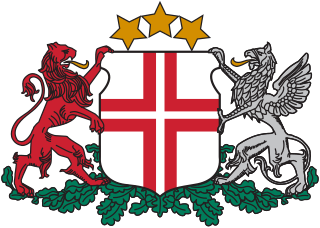 The Latvian Naval Forces were founded on 10 August 1919 with the country taking its independence from the Russian Empire on 18 November 1918 (only recoignised in 1921). Its first ship was the former German minesweeper SMS M68. M68 had been previously sunk by a mine off Riga on October 29 1917 bu she was raised in 1918 and repaired in Riga, later seized by the Latvian Socialist Soviet Republic in 1919, recaptured by Germany and after Independence, formally commissioned as Virsaiti, remaining its only warship until 1926.
The Latvian Naval Forces were founded on 10 August 1919 with the country taking its independence from the Russian Empire on 18 November 1918 (only recoignised in 1921). Its first ship was the former German minesweeper SMS M68. M68 had been previously sunk by a mine off Riga on October 29 1917 bu she was raised in 1918 and repaired in Riga, later seized by the Latvian Socialist Soviet Republic in 1919, recaptured by Germany and after Independence, formally commissioned as Virsaiti, remaining its only warship until 1926.
The same year, the Latvian Navy made the acquisition of two Viesturs-class minesweepers (Viesturs and Imanta) ordered from France, commissioned the same year as two Ronis-class submarines (Ronis and Spīdola) also ordered from France in the same contract. The sixth vacqusition was the ex-German icebreaker Passat, transformed as the submarine tender Varonis.
Post-1929 and the Great Depression hindered any further expansion and reduced training.
The entire fleet under Soviet flag
In August 1940, USSR invaded and occupied Latvia, seized all six warships forcibly incorporated into the Baltic Fleet with the submarines retaining their names, Virsaitis renamed T-297 and Viesturs T-298, Imanta T-299, Varonis renamed “Ural”. They served in in various roles. Ronis and Spīdola were eventually scuttled in Liepāja, June 24 1941 to prevent capture by the advancing wehrmacht wheeras T-299 sank after hitting a mine off Saaremaa by July 1 1941 and Ural on 28 August 1941. Virsaitis evacuated the Soviet garrison on the Hanko Peninsula by late 1941 and on December 2 1941 she took fell to a mine off Hanko. T-298 did survives the war and became a survey ship in 1948. She was not returned to a new Soviet-deminated Latvia.
Rebirth in 1991
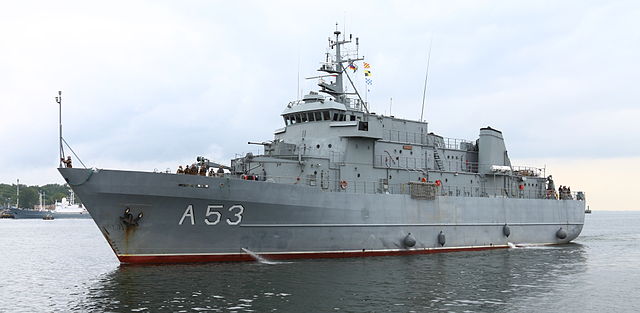
Latvia regained its independence in 1991 and recreated a small Naval Force under command of Admiral (just promoted Captain) Gaidis Zeibots. In 1994, the navy was split between the Southern Region (Liepāja), Central (in Riga), and the Coastal Defense Battalion (Ventspils) completed by the the Training Center in Liepāja. Its first ship was the “SAMS”. It was later increased several folds.
In 1999 the Baltic Naval Squadron (BALTRON) was created, an important date as it aggregated the small Lithuanian, Latvian and Estonian Navies for forma better integrated and larger local force to reinforce NATO operation on the eastern baltic sea. Navy Captain Ilmars Lesinskis (Southern District) became its first commander.
On 1 July the same year was a reorganization:
- Flotilla HQ in Liepāja
- Coast Guard Ships Flotilla in Riga (+ subunits Liepāja, Ventspils)
- Coastal Defense Battalion, Ventspils (subunits Riga Bay)
- Training Center, Liepāja
- Logistic Base, Liepāja (subunits Riga, Ventspils)
1991 ships (now retired)
2x Minesweepers Kondor II (1971): Acquired 1994 M-01 Viesturs, M-02 Imanta, retired 2008
Minehunter Lindau class M-03 Namejs Bundesmarine 1959 acquited 1999, to Liepāja Maritime College in 2008.
4x Norwegian class Storm Patrol boat (1967), P-01 – 04 Linga, Bulta, Zibens, Lode acquired 1991, discarded 2016
3x KA-02, 03, 04 Spulga, Komēta, Sams, ex Ribnadzor class (1964) and Selga class (1974) acquired 1992, discarded 1998, 2000 and 2007.
2004 and today’s stance
On 1 July 2004 the new reorganization called for simplifications:
-Naval Forces Headquarters
-Naval Forces Flotilla HQ (subunits)
-Coast Guard Service.
Modernizing and developing the fleet had been a constant concern also, notably with nationally made patrol vessels with German assistance, the first being launched in 2011.
The Naval Force today is tasked of the following:
- Defense of the national territorial waters
- Disposal of explosive ordnance at sea and harbors
- Co-ordination
- Search and rescue operations
- Foreign representation and NATO assistance
- EEZ/Fishery Guard and Coast Guard duties
- Ecological survey
Ships of the Southern Region notably participated in many international exercises in recent years, notably BALTOPS with the US, and amphibious/cimbined NATO exercises such as COOPERATIVE JAGUAR, AMBER SEA, OPEN SPIRIT among other for better integration to NATO standards.
Ship’s list
Minelayer A-53 Virsaitis Norway, ex Vidar built 1978 , acquired 2003
Hydrographic survey vessel A-90 Varonis Netherlands, ex-Buyskes built 1973, acquired 2004.
5x Tripartite (NL) Minehunters: M-04 to 08 Imanta, Viesturs, Tālivaldis, Visvaldis, Rūsiņš (1984) acquired 2007-2011
5x Skrunda class OPVs Catamaran types, P-05 to 09 Skrunda, Cēsis, Viesīte, Jelgava, Rēzekne, first in Germany 2011 remainder 2013 Latvia
Coast guard KBV class: KA-01 to 14 Kristaps, Gaisma, Ausma, Saule, Klints, Astra built 1963-64 Finland acquired 1993-2001
Gallery
Src
navypedia.org/
militaryheritagetourism.info
en.wikipedia.org/wiki Latvian_Naval_Forces
warshipsresearch.blogspot.com varonis
navalnews.com/tag/latvia/
www.mil.lv/en/kontakti
en.wikipedia.org Latvian_Naval_Forces
 Lebanese Navy
Lebanese Navy
The Lebanese Navy or “Lebanese Sea Forces” was formed in 1950, based in Beirut Naval Base its first and only. The navy currently is a green water protection force with approximately 69 vessels of various sizes/types/roles/procurement and average ages. A move had been constant on the last decade towards increasing its size and modernized it. Today the Lebanese coastal flotilla comprises
64 Watercraft: 24 Interceptors, 20 Patrol vessels, 8 Gun Boats, 2 Landing Crafts and an hydrographic vessel served by 1700 personal. The country had been hit hard by the 2006 was with Israel and is today in poor economic shape with donations mostly from the US, training procvided by the US, French, UK and Italy (Via UNIFIL). The Lebanese Navy plays an important set of missions of oil installation protection, countering drug and arms smuggling, migrant boats interception, and environmental surve among others. The Navy lacks missiles or heavy surface to surface armament, naval infantry or air branch, with air support given by the Army.
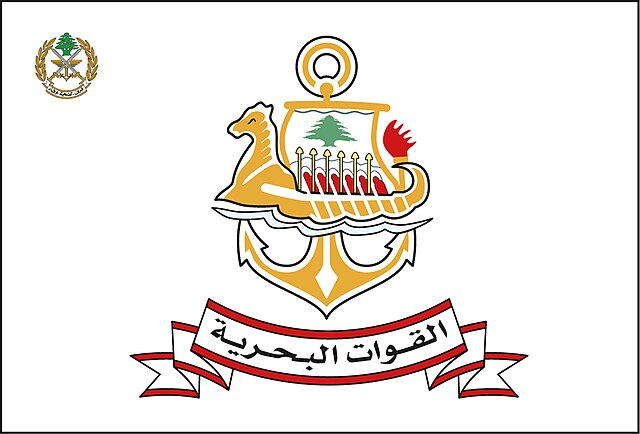
The flag of the Lebanese navy depicts a Phoenician Gaulos with its typical horse figurehead. It is crossed with the Lebanese Cedar tree, used for naval construction incidentally for millenia, especially at the time of the Diadochi. It is positioned on an anchor above the force in Arabic.
The Lebanese Navy forces were established in 1950, with a coupled of small patrol boats in the 1st basin of Beirut Port at first to pilice the port and surroundings. In 1972, this naval base was transferred to Jounieh. After the Lebanese civil war, the Lebanese ships were moved back to the Beirut Naval Base. Lebanon maintained a naval force which consists mainly of small patro| boats and craft supported by former US utility landing craft. The strength of this navy has remained constant over the years and there are no serious plans for a development programme.
Israel gave seven patrol boats to her Lebanese Christian allies in 1975-76. A strong customs service rather than a navy is required. Some of a ten-year $955m programme to re-equip the republic’s armed forces may have found its way to the navy. The main base is at Beirut/Jounieh and in 1995 there was total of 200-400 officers and men serving in the navy commanded by a colonel.
List in 1995
-1x -Tarablous: Large French-built patrol craft: 105t standard, 2 diesels, 27kts, 2~ 40mm, 2-12.7mm MG; built CNE June 1958, launched June 1959, discarded 1991.
-2x Jihad class large patrol craft: Ordered 1975 but sold to Libya January 1978 when defaulting.
-2x ex-RN Fairmile B motor launches: Djounieh, No 41. Stricken 1975.
-3x Byblos class motor launches (28t standard, 66ft, 2 diesels, 18kts, 120mm, 2 MG): Byblos (11), Sidon (12), Beyrouth (13) built 1954-55 by CNE of France. Deleted 1990.
-2x Fairey Marine “Tracker Mk2’ class patrol boats (31.5t full load, 2 diesels, 29kts, 11 crew, 1-twin 23mm of Soviet origin). In service 21 January 1980 and 8 February 1980 (names unknown).
-1x ex-French ‘EDIC’ type landing craft: Sour (ex-L 9096) loaned on 7 November 1983 and since stricken.
2x French EDIC III type landing craft: Sour (21), Damour (22) in service 1985-86:
Built by SFCN, Villeneuve-la-Garonne: ordered in 1983, can carry 11 trucks or five armoured personnel carriers. These craft were damaged in 1990 but were repaired in 1991, Extant 1995, now discarded.
6x Aztec class 9-metre coastal patrol craft: CP 1001-1006, GRP customs boats supplied by Crestitalia, La Spezia, 1980. CP 1006, discarded 1991.
5x ex-RN Attacker class patrol craft (38t, 65ft, 21 kts, 1-20mm Oerlikon. 2 MG): L 01 L O05 (ex-Auacker, Hunter, Chaser, Fencer) three acquired 1992, two in 1993, Extant 1995.
1x ex-US LCU 1466 utility landing craft: Sour (ex-LCU 1474) launched 1955 and transferred November 1958. Stricken 1980.
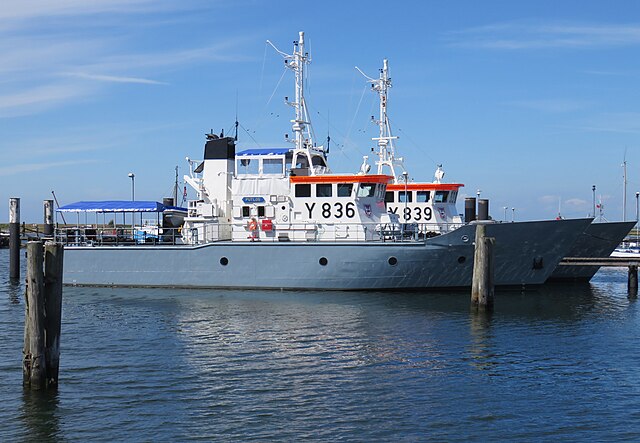
Totendorf class PVs
Recent Events
During the 2006 Lebanon war, posts of the Naval Forces along the Lebanese coast used early detection of drones from Israel. These drones targeted some of these posts, leading to casualties and injuries. The Navy also helped in clearing oil pollution after the destruction of fuel tanks at Jiyeh station. The Lebanese Navy supported the Army against Islamist groups in the Nahr el Bared camp near Tripoli, with the Navy at sea stopping supplies to the jihadists and prevented their escaped during mopup operations.
The Lebanese Navy also took a part in the rescue operation when Ethiopian Airlines Flight 409 bound to Addis Ababa crashed into the Mediterranean shortly after takeoff from Rafic Hariri International Airport on 25 January 2010. The Lebanese Navy found and reported the crash site 3.5 kilometres (1.9 nmi) off Na’ameh village, under 45 metres (148 ft). The search for survivors wad done by Army Sikorsky S-61 helicopters but also the Navy and UNIFIL.
On January 16, 2009, the Lebanese government approved the Lebanese MoD proposal to build a new naval base off Nahr el-Bared, a Palestinian refugee camp in northern Lebanon.
The Lebanese Navy was also involved in several Migrant boats crisis events. On september 22, 2022 rescuing part of the 94 dided when their boats capsized off Syria’s coast. This happened also on April 23 in Tripoli (Lebanon), September 24, 2023 off northern Lebanon and October 7 with 124 Lebanese and Syrians rescued on board an illegal immigration boat off al-Mina and on December 17, 51 were recued from a sinking vessel.
The Current Lebanese Navy
1x Advanced Multimission Platform (AMP) 145 43.50 m Coastal US 41-Trablous
3x Protector-class OBs 27 m, US built, 2701, 2702, 2703 (ex-USCGC Dorado, Chinook, Shearwater)
1x German Todendorf class 28,9 m Security boat: 42-Tabarja (ex-Y838 Bergen) with NEXTER Narwhal 20A RWS.
1x Fassmer FPB 20: 308-Nakoura (ex-Bremen 9), NEXTER Narwhal 20A RWS, fire fighting WC.
1x Attacker class 20m 307-Sarafand, NEXTER 15A 20mm cannon
1x Fast interceptor boat Phenix 55 FPB 17 m/46 knots Speed-boat Sannine
1x Medium Yacht (Captured) 501-Imanuella
4x Small support boat SILLINGER 1200 RAFALE 11.53 m High speed interceptor (FR)
8x Gun Boat 11 meters RHIB US
4x SAFE 44 full cabin 13.4 meters
2x Landing craft EDIR 59m 21-Sour, 22-Damour
1x Hydrographic/survey 7.5 m ship (IT) with sophisticated electronic for undersea measurements + 8 UNODC drones
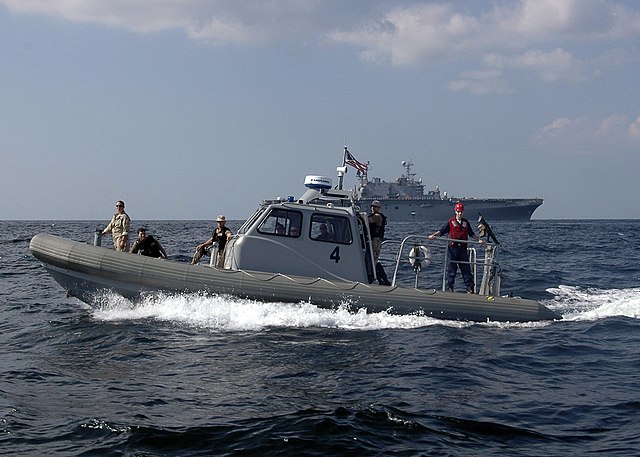
On February 19, 2015, Saudi Arabia cancelled the $3 billion program for military aid to Lebanon. The Lebanese Navy status is uncertain due to the lack pof training and maintenance, even for simple missils such as Search and Rescue, Safety, Environmental Protection, or just Maritime Law Enforcement. It had been hard-pressed to deal with illegal migrant traffic to Europe, or to provide adequate protection to natural gas installations and just police territorial waters due to underfunding and corruption by officials. US military recently however discussed provifing the capable RiverHawk OSV 60 and by May 2021, confirmed donated 7 of them.
The Lebanese Navy also is in charge of coastal radar stations, from 1992, with three stations at Tripoli, Sidon, and Tyre and upgrades in 1997. The 2006 Lebanon War saw these destroyed by the Israeli Navy. Germany and Lebanon had a bilateral agreement to establish The Coastal Radar Organization (CRO) to rebuilt and consolidate a chain of seven coastal radar stations to cover the entire Lebanese coast. Three are refurbished, four are new. Status: Completed.
The Lebanese Naval Forces had no in-house facilities for training, which is done aborad via cooperation agreements with various Naval Acamedies in the US and Europe. Repartition depdens on local specializations. In the US it’s for surface warfare and the Coast Guard. Engineers are formed in France for detection, transmission, and artillery, while amphibious training, maritime drug enforcement is done in UK.
Cooperation with the UNIFIL Maritime Task Force also participates in honing the skills of Lebanese naval personnel through joint exercises and daily cooperation. The MTF settled after the 2006 Lebanon War and mainly trained with the Italian Navy, for peace operation.
Sources
en.wikipedia.org/ Lebanese_Navy
lebarmy.gov.lb navy-forces
globalsecurity.org /lebanon/navy.htm
the961.com Lebanese-navy-7-new-OPV
lebarmyofficial/status X
 Liberian Navy
Liberian Navy
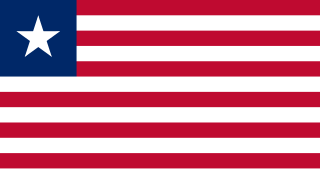 The Liberian National Coast Guard was created in 1959 as part Armed Forces of Liberia to ensure law enforcement along its coast and maritime area, as well as practicing rescue at sea. It started operations with two 40-ft patrol boats from the US to patorl the 200-nautical-mile limit of Liberia’s territorial waters. In 1976 it was augmented by three new mall craft delivered by the US. From 1977 the coast guard was responsible to manage the network of coastal lighthouses. In 1980 three c50 ton Swedish-built coastal patrol craft were delivered. However the lack of spares was an issue. Throughout the Tubman administration, based on a tiny budget, the coastguard ha a handful of patrol crafts in dubious maintenance and readiness served by little trained personnel. The Ministry of National Defense oversaw the force which was 1984 was held by Captain S. Weaka Peters.
The Liberian National Coast Guard was created in 1959 as part Armed Forces of Liberia to ensure law enforcement along its coast and maritime area, as well as practicing rescue at sea. It started operations with two 40-ft patrol boats from the US to patorl the 200-nautical-mile limit of Liberia’s territorial waters. In 1976 it was augmented by three new mall craft delivered by the US. From 1977 the coast guard was responsible to manage the network of coastal lighthouses. In 1980 three c50 ton Swedish-built coastal patrol craft were delivered. However the lack of spares was an issue. Throughout the Tubman administration, based on a tiny budget, the coastguard ha a handful of patrol crafts in dubious maintenance and readiness served by little trained personnel. The Ministry of National Defense oversaw the force which was 1984 was held by Captain S. Weaka Peters.
This improved in the 1980s and ultimately, better will from later administrations made it perhaps the best trained of the Liberian armed services.
In 1984 the Liberian National Coast Guard only counted 450 personnel, six patrol craft under Patrick D. Wallace. In 1986 under the Samuel Doe administration, this force was retitled the “Liberian Navy” under the Act of that year, but it was barely of the minimal scale for a green water navy.
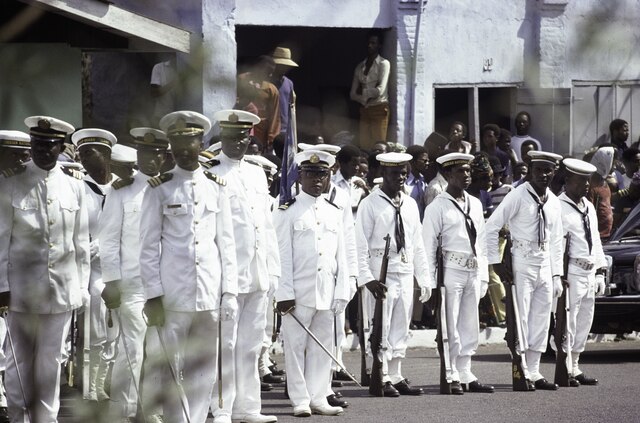
Members of the Liberian National Coast Guard at the inauguration of President William R. Tolbert in 1976. The navy reached its peak on paper in 1980 with 7 ships.
The First and Second Liberian civil wars cut the navy from its bases. The few vessels took refuge where they could and were abandoned, personal returning to the country or emigrated where they were. It became an insignificant force but was reactivated as the “Coast Guard” on the 53rd Armed Forces Day, February 11, 2010. Initially it had only 40 personnel trained in the United States, supervised by a US Coast Guard officer based at the U.S. Embassy in Monrovia.
A detachment from SeaBee Naval Mobile Construction Battalion 7 from Naval Station Rota in Spain were detached there on demand to build a United States Africa Command with a boat ramp and concrete perimeter wall in order to protect this embryo of Coast Guard, until handed over the Liberians on December 2010. In February 2011, the US donated two USCG Defender class boats and they are its only force now. The main port is at Monrovia, with secondary bases at at Buchanan, Greenville, and Cape Palmas.
List Today
2x 27′ Defenders, SAFE 27 Full Cabin type.
2x 33′ Law Enforcement (SPC-LE) based on Defender-class, SAFE 33 Full Cabin type
2x 24′ Boston Whalers
Src/read more
mod.gov.lr/ the-liberian-coast-guard
globalsecurity.org/
web.archive.org www.uscg.mil/
africom.wordpress.com/ liberian-coast-guard-ready-for-247-ops/
africom.mil/1
on en.wikipedia.org/
 Libyan Navy
Libyan Navy
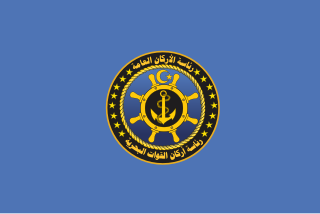 The Libyan Navy was created as part of the Libyan Armed Forces in November 1962, headed at the time by Admiral Mansour Bader, Chief of Staff. Before the First Libyan Civil War (under Muhammar Gadhaffi) it was asizeable green water navy with missile frigates, corvettes and patrol boats, mosty build from a Soviet procurement, with the exception of Britain and Italy.
The Libyan Navy was created as part of the Libyan Armed Forces in November 1962, headed at the time by Admiral Mansour Bader, Chief of Staff. Before the First Libyan Civil War (under Muhammar Gadhaffi) it was asizeable green water navy with missile frigates, corvettes and patrol boats, mosty build from a Soviet procurement, with the exception of Britain and Italy.
The Navy was also the smallest of Libya’s military branches. The Gaddafi-era fleet was destroyed in 2011 and after the start of the Second Libyan Civil War, it was aligned on the Government of National Accord (GNA) based in Tripoli. The Libyan National Army controlled a motley collection of light crafts however.
General Context
After the Second World War, the provinces of Libya were placed provisionally under British and French administration until the country became independent in December 1951, the first independent state created by the UN. The conservative, pro-Western rule of King Idris was bolstered by an American and British military presence, but this did not prevent its overthrow by a military coup in September 1969. The new Arab Republic reversed previous policies as Western bases and troops were evacuated by 1970 and has subsequently steered a somewhat maverick course internationally, a course apparently often dependent on the whims of her erratic yet mercurial leader, Colonel Muammar el Gaddafi.
In the world arena, oil-rich Libya has developed love-hate relationships with both Western and Eastern blocs. Nearer home, the main enemies are Israel and Zionism, but realistic appreciations of Libya’s current military capabilities and her oil installations’ vulnerability have prevented direct armed conflict. As a fervent exponent of pan-Arab Socialism, she has proposed (and occasionally affected) unions with other Arab states, but these have always proved transitory. No money or effort have been spared in attempts to destabilise less revolutionary Arab leaders, or even revolutionary leaders following different roads to socialism. Libya replaced Algeria as the main arms supplier to the Polisario Front in the Western Sahara, and also began economic and military penetration southwards, alarming the fragile and vulnerable states of the Sahel and tropical Africa; attempts in 1979 to shore up Idi Amin in Uganda and Bokassa in the Central African Empire brought only ignominy and ridicule, but the Libyan intervention in Chad in 1980 successfully ended traditional French influence.
Libya’s armed forces are numerically weak, as expected for a population of only 3,250,000, but make up for this by being lavishly equipped with the most modern weapons, which look good on paper but cause formidable problems of training and maintenance; in major July 1977 border clashes with Egypt, Libyan forces performed badly, Some 1800 Soviet advisers were reported in the country in 1982, but the USSR never secured bases in avowedly antu-Communist Libya.
The navy was set up in November 1962 by a British Naval Mission, with technical assistance and training that began in Malta. Since 1974 it has been expanded rapidly with defence spending rising 250 per Cent; the volunteer personnel increased from 2000 to 3000 between 1974 and 1980. Libya’s merchant marine quadrupled over the same Deriod. The Fleet, which has been obtaining up-to-date ships from both West and East, now includes submarines, missile-armed Corvettes and fast attack craft, an amphibious force in theory able to land 2000 troops plus units with a minelaying capability. ‘The bases are Tripoli (5000-ton floating dock), Benghazi, Derna, Tobruk and Bandiyah.
In the 1980s there were a number of armed clashes between the Libyan Navy and Air Force and both Italian and US forces. These Culminated in Operation El Dorado Canyon, when carrier-borne USN A-6 Intruders destroyed two Libyan missile boats…
The fleet’s Growth
Its first warship was delivered in 1966. These were two Ham-class minesweepers from the UK. Initially the effective force was limited to smaller vessels, but this changed after the rise of Colonel Muammar Gaddafi in 1969. From this time, Libya started to buy armaments from Europe and the Soviet Union. The Customs and Harbour police were amalgamated with the Navy in 1970, extending the Navy’s mission to include anti-smuggling and customs duties. The total personnel of the Libyan Navy is about 8,000.
The Navy was much strengthened in the 1970s with the acquisition of six Foxtrot-class submarines. However in the 1980s it was estimated that two of them were only “averagely serviceable”. The USN took them as a serious threat still in the Mediterranean Sea. Nanuchka-class corvettes in the export versions were also purchased, well-armed ships. Four Assad-class corvettes from Italy rounded this up, with Otomat long range missiles albeit without datalink, with a modern artillery and well rounded with with sonar and light torpedoes. The long list below details this fleet:
DAT ASSAWARI frigate (missile)
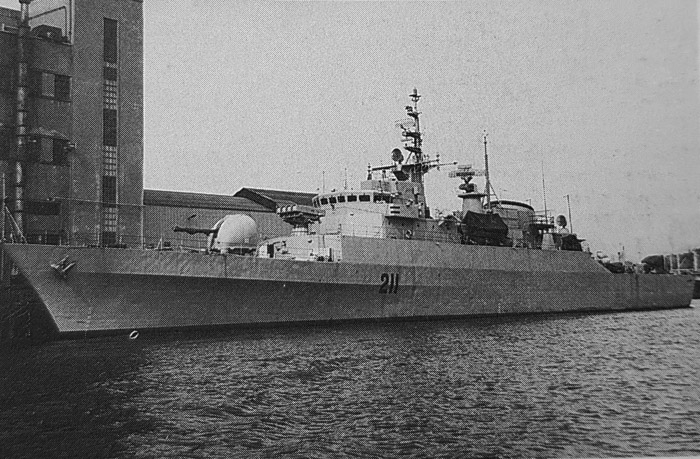
Class: DAT ASSAWARI Vosper launched 13.10.69 by Thornycroft.
Vosper Thornycroft Mk 7 Ordered in February 1968, laid down 27 September 1968 and completed 1 February 1973, slightly larger than the two Iranian Mk 5s and has a different armament. Vibrated strongly at speeds over 27kts. Dat Assawari was retitted (1979 81) by CNR, Riva Trigosa (Genoa) despite bomb damage on 29 October 1980 with the following changes: 4 Otomat Mk 1 SSM (4 x 1) added aft, 4 Albatros SAM (1 x 4) in place of Seacat forward, 6 12.75in ASW TT (2 x 3), Decca TM 1229 radar, Diodon sonar and Selenia RAN-12/X combat data system added. Italian RAN-10S search radar gives a reported 50 per cent range improvement on the old British set. Now numbered 211 (ex-101). She underwent a major refit in 1989-9.

Displacement: 1325t standard; 1625t full load
Dimensions: 330ft oa, 310ft pp x 36ft x 11ft 2in 94.5m, 100.6m x 11.0m x 3.4m
Machinery: 2-shaft CODOG: 2 Rolls-Royce Olympus gas turbines, 46,400shp = 37.5kts, plus 2 Paxman Ventura 16Y JCM diesels, 3500bhp = 17kts. Range 5700nm at 17kts
Armament: 1-4.5in/55 Mk 8, 240mm/70 (2×1), 2-35mm/90 Oerlikon (1×2), 2 Seacat SAM (2×3), 1 Limbo Mk 10 ASW mortar.
Sensors: Radar Plessey ASW-1, RDL-1; sonar Types 185, 170, 174
Complement: 132.
Ex-Soviet KONI IID class frigates
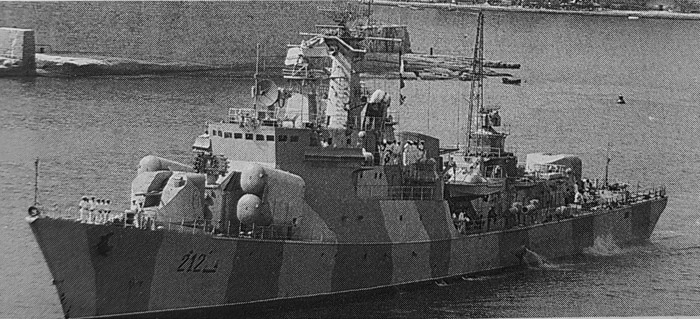
Class: 212 AL HANI (Zelenodolsk) 28.6.86, 213 AL GHARDANIA (Zelenodolsk) 23.10.87.
These were the eleventh and twelfth units of Koni III class built for export. They had an Extended deckhouse to accommodate additional air-conditioning equipment. Same as the regular Koni III.
As of today only Al Hani is in service, Armament: 4 × SS-N-2C Styx SSMs, 2 × SA-N-4 SAMs, 4 × 76mm guns, 4 × 30mm guns, 4 × 406mm torpedoes, 1 × RBU-6000 A/S mortar, 20 mines.
Soviet FOXTROT class submarines

Class: Al Badr (311), Al Fatah (312), Al Ahad (313), Al Matrega (314), Al Khyber (315), Al Hunyan (316).
Constructed on a re-activated Sudomekh SY building line in Leningrad; Al Badr reached Tnpoli 27 December 1976. Rest delivered late 1977, early 1978, 17 March 1981 and February 1982. Libyan crews were trained in the USSR and up to twelve Soviet advisers served aboard each boat until 1992, Only one submarine fully operational listed as of 1995, now all scrapped.
In 1982 Libya received indeed six Foxtrot-class submarines from the Soviet Union, however the lack of maintenance had all them immobile by 1984, no patrols reported. In 1993 one submarine was reported sunk (probably by rust and leakages) another abandoned in Lithuania due to international sanctions. Other reports had one allegedly refitted in 2003. In 2011 the Libyan civil war saw one of these captured by the rebels at the Benghazi naval base.
Yugoslav MALA class midget submarines:
Two ordered 1979. First delivered January 1982. No photo, no data, lost 2011.
IBN OUF class landing ships

Class: 130 IBN OUF 22.10.76, 131 IBN HARITHA, 18.10.77 (La Seyne CNIM)
Built at La Seyne. Can carry 570t cargo inc eleven tanks. Stern helicopter platform. 130 was laid down in April 1976 and completed 11 March 1977, 131 laid down 18 April 1977 and completed 10 March 1978. Renumbered 132 and 134. Lost 2011.
Displacement: 2200t standard; 2800t full load
Dimensions: 326ft 5in x 51ft 2in 7A 10in 99, 5m x 15,60 x 2,4
Machinery: 2 shafts, 2 SEMT-Piclstick diesels, 5340bhp = 15.4kts, Range 4000nm at 14kts, 30-day endurance
Armament: 6-40mn/70 Breda AA (3 x 2), 1 81mm mortar
Sensors: Radar Decca 1226, Thomson-CSF Triton
Complement: 35 (+ 240 troops)
Soviet ‘POLNOCNY-C’ class landing ships
Class: Ibn al Hadrani (112), Ibn al Qis (113), Ibn Omaya (116) and Ibn el Farat (118)
Number 112 transferred December 1977, 116 and 118 in June 1979. 113 lost by fire at sea 14/15 September 1978 during landing exercise. Like Iraq’s export versions with helicopter deck forward of superstructure.
Ex-Turkish ‘C 107’ class large landing craft
Class: Ras el Hillel (ex-C 132), El Kobayat (ex-C 133), Ibn al Idrissi (ex-C 130), Ibn Marwhan (ex-C 131)
Transferred on 7 December 1979. Up to fifty originally planned but only four transferred. Built by Taskizak and Gélctik N Yds. Cargo 300 troops, five tanks. All extant 1995.
TOBRUK corvette
Class: C411 TOBRUK: Vosper, 29.7.65, Hulked 1989 in Portsmouth.
Type 1 corvette, laid down 22 February 1965 and completed 30 March 1966, arrived Tripoli 15 June 1966. Generally similar to Keta and Kromantse built for Ghana but with less powerful machinery, and AA armanent. Two 40mm guns removed c1970. Apartments for use as state yacht. Vosper anti-roll fins and air conditioning.
Specs:
Displacement: 440t standard; 500t full load Dimensions: 177ft oa x 28ft 6in x 13ft 54.0m x 8.7m * 4.0m Machinery: 2 shafts, 2 Paxman Ventura 16 YJCM diesels, 3800bhp = 18k«s. Oil 60t. Range 2900nm at 14kts Armament: 1-4in/40 Mk 23 LA, 4 40mm 60 Mk 9 (4« 4), 2 2in RFL, 2 12.7mm MG Sensors: Radar surface warning Complement: 63.
WADI M’RAGH class missile corvettes
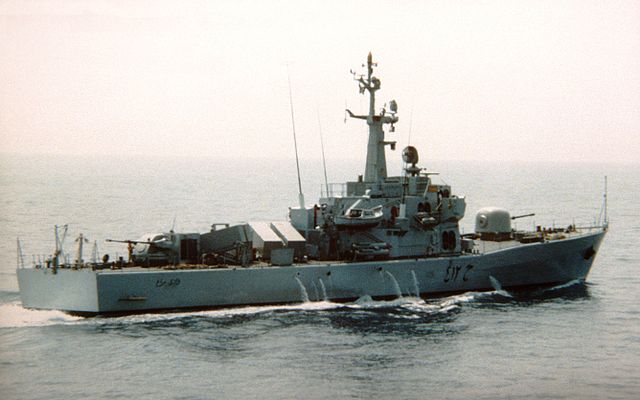
C 412 ASSAD AL Muggiano, 29.9.77 Deleted TADJIER La Spezia 1993 (exWadi M’Ragh) C 413 ASSAD AL Muggiano, 20.4.78 Deleted TOUGOUR La Spezia 1993 (exWadi Majer) ’ C 414 ASSAD AL KALIJ Muggiano, 14.12.79 Deleted (exWadi Marseat) La Spezia 1993 C 415 ASSAD AL HUDUD Muggiano, 21.6.79 Deleted | (exWadi Magrawa) La Spezia 1993
Missile corvettes ordered in 1974: 412 and 413 laid down 25 May 1976; 414 on 26 October 1977; 415 on 25 May 1978. 412 entered service on 14 September 1979, 413 on 12 February 1980, 414 and 415 on 28 March 1981. All renamed 1981. Four more ordered May 1980. Slower than comparably armed FAC, but have much greater range and sea-keeping qualities. NBC protection.
Six similar ships were built for Ecuador and four for Iraq. Only one unit, operational 1990, and all discarded by 1995.

specs:
Displacement: 545t light; 670t full load S.
Dimensions: 189ft 7in pp, 202ft Sin oa x 30ft 6in x 8ft 10in 57.8m, 61,7m x 9.3m «x 2.7m
Machinery: 4 shafts, 4 MTU type MA 16V 956 TR 14,000bhp = 31.5kts. Oil 126t. Range 1400nm/10 kts, 33kts/18kts, 15 day endurance
Armament: 4 Otomat Mk 1 SSM (4 x 1), 1-76mm/62 OTO Melara Compact, 2-35mm/90 Oerlikon (1 x 2), 6-12.7 Sin Asia TT (2 x 3), 16 mines on 2 rails (as minelayer)
Sensors: Radar Selenia RAN-11L/X, Decca TM-1226, RTN-10x Orion; Sonar Thomson-CSF Diodon; ECM Selenia ISN-intercept.
Complement: 58
Soviet ‘NANUCHKA IP class missile corvettes
Class: Tariq Ibn Ziyad (416, Oct 1981), Ain al Galaza (417, 1983), Ain Zaara (418, 1983), Ain Zaquit (419, 1983).
419 sunk by US aircraft 24 March 1986, and 416 damaged next day, and – repaired in the USSR 1990. Survivors extant 1995.
SUSA class fast attack craft (missile)
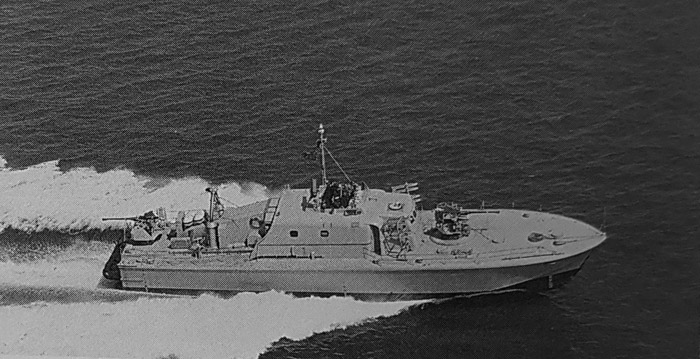
Class: Susa (P 512, 31.8.67), Sirte (P 513, 10.1.68), Sebha (ex-Sokna) (P 514; 29.2.68).
Wooden, nylon sheathed boat ordered from Vospers 12 October 1966 and modelled on Vosper’s Danish Sdléven class. All commissioned January 1969 as the West’s first missile-armed FAC after Vosper and Nord Aviation had designed a sighting turret for the wire-guided SS12. All completely refitted 1977 in Italy and fitted with new engines 1985 86. Possibly out of action 1990s.
Displacement: 95t standard; 114t full load
Dimensions: 100ft oa x 25ft 6in x 7ft 30.5m x 7.8m x 2.1m
Machinery: 3-shaft CODOG: Bristol Siddeley Proteus gas turbines; 12,750shp = 54kts; 2 GM 6-71 cruising diesels, 190hp
Armament: 8 SS12 SSM (2 x 4), 2-40mm/60 Mk 9 (2 x 1), 2 RFL
Complement: 20
Ex-Soviet ‘OSA II’ class fast attack craft (missile)
Class: Al Katum (205), Al O’ Work (206), Al Revae (207), Al Baida (208), Al Nabhaa (209), Al Fikar (210), Al Safhaa (952), Al Zakab (954), Al Zuara (956), 953 and 513 plus one other.
Libya has twelve, the first transferred in October 1976, four in 1977, one in 1978, three in October 1979 to Tobruk and three in 1980, Fitted with new engines in Italy 1984-85. All sank 2011.
BEIR GRASSA class fast attack craft (missile)
Class: 518 BEIR GRASSA Sharara 28.6.79 Extant 1995 519 BEIR GZIR Shehab 22.1.80 Extant 1995 520 BEIR GTIFA Wahg 20.5.80 Extant 1995 521 BEIRGLULUD Waheeg 30.9.80 Sunk 24.3.86 522 BEIRALGANDULA Shouaae 14.1.8, 523. BEIRKTITAT Shouala 22.4.81, 524 BEIR ALKARIM Shafak 23.6.81, 525 BEIR ALKARDMEN Bark 23.6.81, 526 BEIRALKUR Raad 30.11.81, 527 BEIRALKUESAT Laahibe 28.1.82
“Combattante IIG” type boats ordered from CMN, Cherbourg in May 1977 at an estimated cost of about £300 million. Laying down dates: 518 (13.3.78), 519 (10.6.78), 520 (30.1.79), 521 (20.10.79), 522 (12.9.79), 523 (17.12.79), 524 (11.3.80), 525 (9.6.80), 526 (20.10.80) and 527 (20.1.81). Beir Grassa was to have been delivered in February 1981 but the French embargo on arms sales to Libya, umposed because of Libyan intervention in Chad, delayed her handover till 5 February 1982, that of Beir Gzir until 3 April 1982. 520 and 521 were delivered in July 1982 and 522 in September, 525 on 11 March 1983. Renamed, and renumbered, 1983. Survivors reported non-operational as of 1995. All but one lost in 2011.
Surviving ships as of 2024: Beir Grassa class Shafak (534) armed on paper with 4× Otomat SSMs, 1× 76mm gun and 2× 40mm guns.
Specs:
Displacement: 258t standard; 31 1t full load
Dimensions: 160ft 8in oa x 24ft Llin x 7ft Ilin 49.0m x 7.6m x 2.4m
Machinery: 4 shafts, 4 MTU 20V538 TB91 diesels, 18,000bhp = 40kts. Range 1600nm at 1 5kts
Armament: 4 Otomat Mk 1 SSM (4 x 1), 1-76mm/62 OTO Melara Compact, 2-40mm/70 Breda Bofors (1 x 2)
Sensors: Radar Thomson-CSF: Triton search, Castor track, Vega II fire-control; ECM Thomson-CSF
Complement: 27
GARIAN class large patrol craft
Class: Garian (PC 1, 21.4.69), Khawlan (PC 2, 29.5.69), Merawa (PC 3, 30.9.69), Sabratha (PC 4, 25.10.69)
Ordered from Brooke Marine, Lowestoft, England, in December 1967, First two commissioned 20 August 1969, second two early 1970. At least one has Soviet BM21 122mm 20-barrel MRL instead of the 20mm gun. All lost 2011.
Specs:
Displacement: 120t standard; 159 full load
Dimensions: 106ft oa x 21ft 2in x 5ft 6in 32.3m x 6.5m x 1.7m
Machinery: 2 shafts, 2 Paxman l2cyl Ventura 10YJCM diesels, 3600bhp = 24kts. Range 1800nm/2300nm at I 3kts/1 1 kts
Armament: 1-40mm/60 Mk 9, 1-20mm (690rds for both), 2-2in RFL
Complement: 15
FARWA class large patrol craft
Class: Ar Rakib (4.5.67), Farwa (4.5.67), Benina (29.8.69), Afisurata (29.8,09), Akrama early 1969), Lloms (early 1969)
Vosper Thornycroft type, for customs and fishery protection, launched 1967 68, Ar Rakib, Akrama and Marva transferred to Mala in 1978; rest destroyed 2001
Specs:
Displacement: 100t full load
Dimensions: 100ft oa x 21ft x Sft 6in 30.5m x 6.4m x 1.7m
Machinery: 3 shafts, 3 Rolls-Royce DV8TLM diesels, 1740bhp = 1 8kts, Range 1800nm at 14kts
Armament: 1 20mm Oerlikon Mk 7
Complement: 18
Ex-British ‘HAM’ class
Inshore minesweepers: Brak (ex-Harpham), Zuara (ex-Greetham).
Loaned by the RN in 1963 as the new Libyan Navy’s first ships. Transferred Permanently and renamed in September 1966. Both discarded 1973.
Soviet ‘NATYA’ class ocean minesweepers
Class: Al I’sar (ex-Ras el Gehts, 111), Al Tayyar (ex-Ras Hadad, 113), Ras al Hamman (115), Ras al Falluga (117), Ras al Oula (119), Ras al Dawar (121), Ras Massad (123), Ras al Hani (125)
Eight delivered 1981-86. As with India’s six they lack the stern ramp of Soviet Navy units. Two minefields laid 8 miles from Tripoli in June 1973, several since using Italianbuilt ro-ro ship E/ Timsah (acquired 1979).
MISCELLANEOUS
-1x 78ft Thornycroft coastal patrol craft (built Singapore 1962)
-1x Maintenance repair craft Zleiten (ex-British MRC 1013) bought 5 September 1966, hulk 1995
-1x 2200t logistic support ship Zeltin (Vosper, launched 29 February 1968, 15kts) can dock FAC of up to 120ft
-14x SAR 33 class customs patrol boats (150t, 40kts, 140mm and 2-12.7mm MG) W German design ordered early 1980 from Taskizak N Yd, Istanbul
-2x customs patrol boats: Fad and Salam (120t, 27kts, 420mm Hispano-Suiza A32) from Muller of W Germany in January 1978 when Lebanon was unable to pay.
-6x Yugoslav-built PB 90 class, in service 1985-86.
Combat with the USN
Libya’s first naval military action was with the Sixth Fleet in March 1986 in the Gulf of Sidra. One missile boat and a corvette were destroyed, another ship damaged by A-6 Intruders from the local carrier with cluster bombs such as the Mk.20 Rockeye. On 9 July July 1984, the roll-on/roll-off ferry Ghat hit a mine in the Red Sea south of the Suez Canal. 19 ships were damaged, including a Soviet container ship claimed by the Islamic Jihad Organisation. President Hosni Mubarak did not believe the claims, blaming Muammar Gaddafi and Libya. A Libyan ship suspected of the minelaying operation was inspected by French officials in Marseilles, noting its the aft door was damaged. Egypt asked for international assistance with minehunters from France, UK, Italy, the Netherlands and the USA. A British minehunter recuperated a axamined a Soviet-made mine which coukld be traced back to those sold to Libya in 1981.
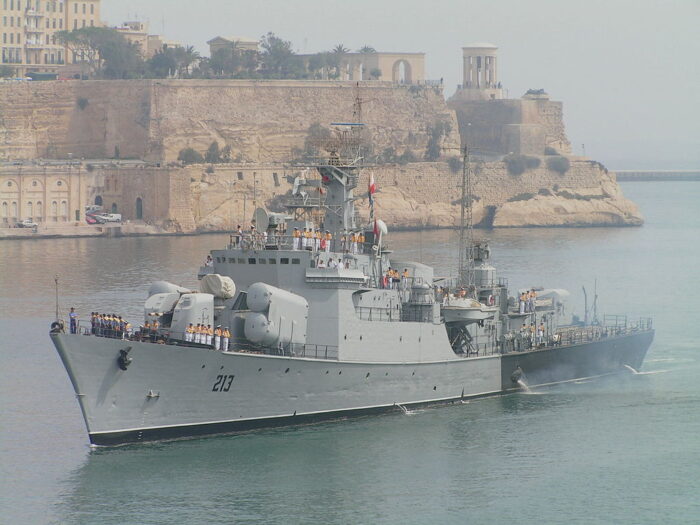
The Koni class corvette Al Gharabia in 2005, sunk in 2011.
From the civil war to this day
The 2011 Libyan civil war saw NATO forces destroying eight warships in the night before 20 May, one on 17 August. Later two were also captured by rebels at Benghazi. On was a Foxtrot class, probably more a wreck than a serviceable ship.
The new government managed to secure some funding to rebuilt the Navy from May 2012. The focus was on fast patrol boats for basic border protection purposes. These were the MRTP-20 fast attack boats and by June Commodore Hassan Ali Bushnak became Chief of Staff of the Navy and tried to further rebuilt its capabilities. The British Royal Navy organized joint exercises at Dartmouth Naval College the same month to rebuilt skills. Later the navy was under command of Rida Issa (Gvt. of National Accord) and took part in liberation of Sirte from ISIL. The Libyan Navy assisted ground forces there, intercepting fleeing militants by boats. On 20 June 2016, the US announced Operation Sophia extended until 2017, to help train the Libyan Navy and coast guard.
In 2021, the navy coexist with a small rebel force loyal to Gen. Haftar, under the autyhority of the new President, Mohamed al-Menfi.
With just four ships, it’s capabilities are quite reduced, but the country needs to rebuilt an economy first after the ravages of the civil war.
The ships in question are the Koni class Al Hani (212) as flagship, the FAC Shafak (534), the Polocny landing craft Ibn Ouf (132) and Ibn Haritha (134) as well as the EDIC type lancing craft Ç-130
and Ç-131 donated by Turkey in the 1980s. The average age of this fleet is now 40 years.
Sources
Levie, Howard. Mine Warfare at Sea. Dordrecht, NL: Martinus Nijhoff, 1992.
War machines encliclopedy, Limited publishing, in Italian version Armi da guerra.
Annati Massimo, Al diavolo le mine!, RID magazine, Coop Riviera Ligure, Italy, June 2005.
en.wikipedia.org/ Libyan_Navy
battleships-cruisers.co.uk libyan_navy.htm
newsinfo.inquirer.net/ nato hits 8 kadhafi ships
web.archive.org/ Libya_Navy
www.gov.uk/ libyan-navy-visits
libyaobserver.ly 57th-anniversary-foundation
 Lithuanian Navy
Lithuanian Navy
The Lithuanian Navy (Lietuvos Karinės jūrų pajėgos) is today the naval arm of the Lithuanian Armed Forces, formally established on 1 August 1935. After the Red Army took over the country, its units were impressed in the Soviet naval forces and fought in World War II. Still, the Navy was re-established since the independence in 1990 and duly modernized.
The Lithuanian Navy
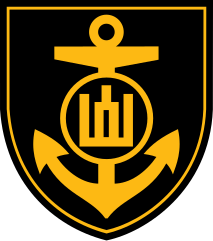 Its roots went back to the earliest Medieval sea faring companies in the Baltic Sea. The Baltic tribe of “Aistians” settled on the shore and started to build ships, using them for trade and war as well in the 12th Cent. They looked like scandinavian vessels, symmetrical, with oars and sails, and with a low freeboard allowing them to enter deep into inland waterways. In the 13th century the Coronians and Samogitians attempted a naval siege of the castle of Riga, the Viking way. The victory of the Lithuaniansin a naval battle at the Nemunas River under Duke Vytenis (Duchy of Lithuania) was another landmark of this early history. However it’s under hetman Jan Karol Chodkiewicz on 24 March 1609 near Salismünde (Salacgrīva) that a coalition comprising manu Lithianian ships, defeated a Swedish fleet, breaking the blockade of Riga. Still, loss of territories iompacted the Lithuanian maritime trade. During the Polish–Lithuanian Commonwealth there was a small Lithuanian component while played a minor role in Commonwealth successed in the Baltic. Neither Poland nor Lithuania had significant naval victories in that era.
Its roots went back to the earliest Medieval sea faring companies in the Baltic Sea. The Baltic tribe of “Aistians” settled on the shore and started to build ships, using them for trade and war as well in the 12th Cent. They looked like scandinavian vessels, symmetrical, with oars and sails, and with a low freeboard allowing them to enter deep into inland waterways. In the 13th century the Coronians and Samogitians attempted a naval siege of the castle of Riga, the Viking way. The victory of the Lithuaniansin a naval battle at the Nemunas River under Duke Vytenis (Duchy of Lithuania) was another landmark of this early history. However it’s under hetman Jan Karol Chodkiewicz on 24 March 1609 near Salismünde (Salacgrīva) that a coalition comprising manu Lithianian ships, defeated a Swedish fleet, breaking the blockade of Riga. Still, loss of territories iompacted the Lithuanian maritime trade. During the Polish–Lithuanian Commonwealth there was a small Lithuanian component while played a minor role in Commonwealth successed in the Baltic. Neither Poland nor Lithuania had significant naval victories in that era.
Under the Polish Commonwealth
However by the 17th century, Poland started butting heads with the House of Vasa, which kings attempted to create a proper fleet, encountering repeated failures due to lack of funds. The Polish nobility saw little need for a fleet and refused to contribute. Under Sigismund III, the Commonwealth Navy under Admiral Arend Dickmann had success against Sweden at the Battle of Oliwa in 1627. This ensired permanent access to the Atlantic and allowed expeditions beyond Europe. This greatly benefited both Polish and Lithuanian trade. Plans for an independent fleet fell through however due to poorly conceived alliance with the Habsburgs in 1629.
A Polish Commission of Royal Ships (Komisja Okrętów Królewskich) was created in 1625 to allocate funds and create a Navy at the horizon of 1637 for the Commonwealth. Władysław IV Waza in 1632 bought 12 ships, and created the naval arsenal and port of Władysławowo. Under the Władysław IV Pacta conventa, the fleet was consolidated further, and Kind Władysław, whuich succeeded Sigismund III Vasa wanted an expansion of the Commonwealth Navy.
The previously captured ships in Wismar and Travemuende were not recovered so decision was made to create a new fleet monitored by a Naval Commission under Gerard Denhoff and comprising wealthy king supporters and merchants, notably Georg Hewel (Jerzy Hewel) from Danzig. However still this was resisted by the Sejm (Polish Diet). Hewel gave to the king’s 10 ships with a few small caliber cannons but they needed to be modernized and rebuilt to carry heavier cannons. The King wanted also to build galleons in Danzig and Puck or purchase them abroad, but this again never happened.
The ‘Polish fleet’ also partially manned by Lithuanians, consisted of 10 ex-merchant ships ranging from 420 to 140 tons plus a small galley under command of rear admiral Aleksander Seton.
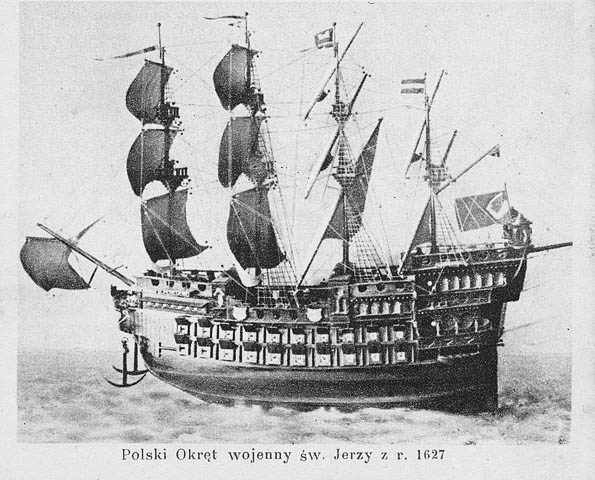
The Commonwealth Galleon Rycerz Święty Jerzy (“Knight St George”), 31 guns, 400t under command of Johann Storch at the battle of Oliwa in 1627
The Harbor in Puck was however too shallow while Wisłoujście fortress near Gdansk was blocked by Danzig Patricians. So royal engineers Friederich Getkant, Jan Pleitner and Eliasz Arciszewski looked for a poper site and choosed the the Hel peninsula. It was completed in 1634 with palisades, earthen walls, trenches and moats and defended by the small forts of Władysławowo and Kazimierzowo. There was a perfect, deep bay to have the ships anchored. 500 Cossacks (Konstanty Kołek) came with their own Chaika ships. From there, the idea was to attack Swedish supply and trade lines in the Vistula Bay, capture merchant ships and multiply raids on Swedish islands.
The Polish nobles support the enterprise but it was hardly paid at all. The fleet took no part in the Smolensk War with Muscovy and after a new armistice with Sweden at Stumsdorf the Diet refuse any naval spending at all. To financed it, the king wanted instead to use his fleet as the first long range Polish merchant company under the patronage and financing of Hewel but the latter efused, arguing these ships were just too small and not tailored for such long voyages. The ships were sold and even the fortifications were destroyed in 1640s.
After the death of Gustavus Adolphus the Polish nobles preferred still a new armistice for 35 years and preparations for a next land war were even marred by the king’s relief of Smolensk in 1634 and his campaign against Moscow, so again, coffers were empty. What remained of the commonwealth fleet was destroyed in 1637 by Denmark without declaration of war and the reminder sold in 1641-1643. The most interesting of these had been the Ritter Sankt Georg 31 guns galleon (400t) and Fliegender Hirsch 20 guns galleon of 300t.
Interwar
Fast forward to the XXth Century. Lithuania fell to the Russian Empire, as wel as Poland, and both countries stayed under this rule until the end of WWI. The new Government of Lithuania in 1920 wanted to to establish a maritime defense force but between political and economical issues, the plan was not implemented. In 1923 Klaipėda harbor was obtained and the plan consisted in reinforcing maritime defenses only. At last a minesweeper was purchased in 1927, as the training ship Prezidentas Smetona. Captain Antanas Kaskelis was its first commanding officer. Three to six Small cutters completed this for basic shore patrol duties and a small yacht in Klaipėda harbor as HQ. Officers were educated abroad. On 1 August 1935, the commander in chief of the Lithuanian Armed Forces, General Stasys Rastikis, officially established the Navy. Read More about the interwar Lithuanian Navy
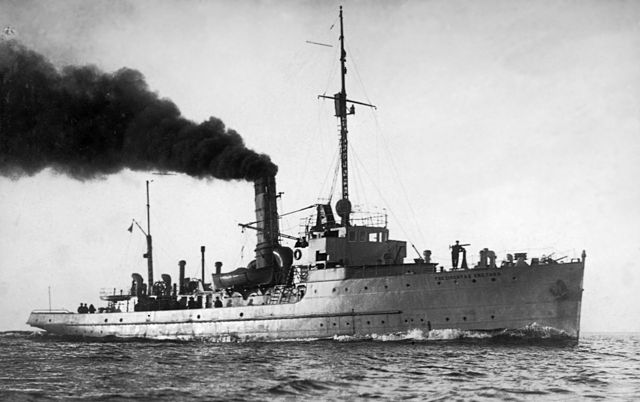
Interwar Lithuanian warship Prezidentas Smetona (1935)
On 22 March 1939 Klaipėda was occupied by Germany, and yet Lithuanian naval ships were forced to leave Klaipėda for Liepāja, in Latvia. The Soviet occupation had 3 Russian boats preventing Prezidentas Smetona in Sventoji harbor to depart. She was captured. The Lithuanian Navy was attached to the Baltic maritime defense force. Prezidentas Smetona beame “Korall”, having skimished with light Kriesgmarine forces. On 11 January 1945 she hit a mine sank in the Gulf of Finland.
Renaissance in 1990
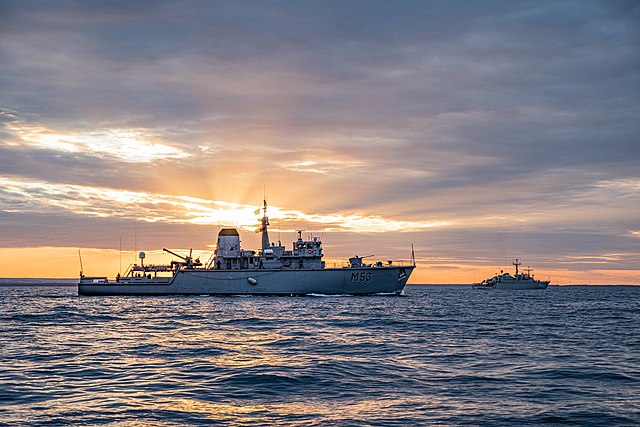
The minsweeper Skalvis (M53) in training, Baltic 16 June 2020. These had been a permanent fixture of BALTOPS since 1993.
After the restoration of independence on 11 March 1990, Lithuania started to re-establish its Armed Forces an on 4 July 1992 this was the Navy, under Juozapas Algis Leisis as commander of the Coast Guard Squadron. A41 Vėtra (Klaipėda harbour administration) was a small vessel used for SAR and supply operations. In 1992, two Grisha-class corvette, Zemaitis (F11) and Aukstaitis (F12) were acquired from Russia and consitituted the bedrock of the reconsitituted navy. After initil training by June 1992, the corvettes took part in NATO BALTOPS 93 exercise. Lithuania started a serie of yearly naval cooperation with other Baltoc or Northern European navies.
Until 2000 three Storm-class patrol boats were acquired from Norway, two Lindau-class minehunter from Germany and the early cutter (Vilnele, launched 1983) from the Klaipėda harbor administration, served by a a tug and dive cutter Lokys (Sweden). Next was established the Sea Coastal Surveillance Company in 1993, with radar and missile systems.
The Grisha III-class corvettes F11 Žemaitis and F12 Aukštaitis* as well as the Lindau-class minehunters (M51 Kuršis, M52 Sūduvis), and Storm-class patrol boats (P31 Dzūkas, P32 Selis, P33 Skalvis) as well as support ships and cutters (A41 Vėtra, H23 Lokys) were retired in the meantime, or planned to be in 2025.
The large Grisha III were already old, launched 1980-81 and in poor state already when purchased. They were decommissioned on 22 October 2008 and April 2010.
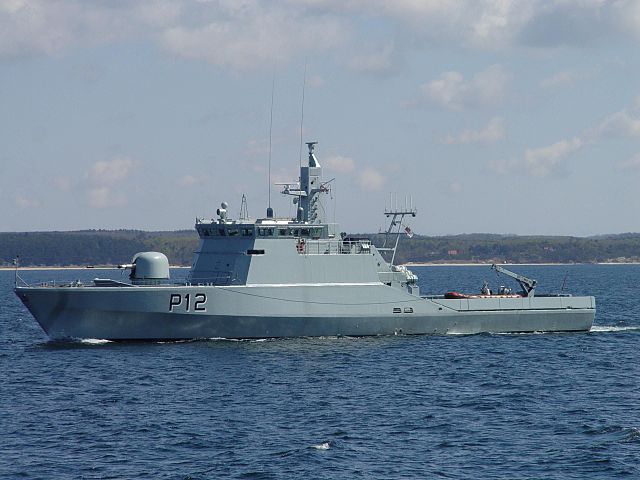
P12 Dzukas multirole OPV.
In 2004, Lithuania entered NATO and in 2006, the ex-HNoMS Vidar (N52) was acquired as Jotvingis (N42), used as command and supply ship. From 2008 to 2016 the Navy acquired four Danish Flyvefisken-class patrol vessels as P11 Žemaitis, P12 Dzūkas, P14 Aukštaitis and P15 Sėlis. Joined also the SAR ship Šakiai also from the Klaipėda harbour administration. In 2013, the ex-HMS Cottesmore and ex-HMS Dulverton were purchased after modernization as M53 Skalvis and M54 Kuršis, used for Mine Countermeasures.
In May 2020, a third Hunt-class minehunter was approved fore transfer, and by April 2022, Finnish Jehu-class patrol boats were also announced on purchase.
List Today
-Jotvingis (Vidar-class) Minelayer/command vessels (1977) from 2006
-3x M53 Skalvis, M54 Kuršis, M55 Hunt-class Mine warfare vessels (1982) from 2013 and 2020, the latter after modernization.
-4x P11 Žemaitis, P12 Dzūka, P14 Aukštaitis, P15 Sėlis Multirole Patrol ships (Flyvefisken-class) from 2008, 2009, 2010, 2016.
-P351 Žaibas (Storebro SB90E type) Marine security and patrol boat (1997) acquired 2023
-2 Jehu-class Marine security and patrol boats (To be delivered 2025)
-PGL Šakiai SAR (ex soviet 1986)
-H21 Vilnelė (ex Soviet 1983) Cutter and Support vessel.
-H22 Atlas swedish Tugboat (1955) acquired 2000, used also a icebreaker.
Read More
Eric Wertheim: The Naval Institute Guide to Combat Fleets of the World: Their Ships, Aircraft, and Systems (2007), p. 449 ff.
Juliusz Bardach, Boguslaw Lesnodorski, and Michal Pietrzak, Historia panstwa i prawa polskiego 1987
Hackett, James, ed. (14 February 2022). “The 2022 Military Balance Chart”. The Military Balance
https://www.kariuomene.lt/kas-mes-esame/kariniai-laipsniai/16
https://www.lrt.lt/en/news-in-english/19/1682250/lithuania-to-buy-patrol-boats-from-finland-ministry
https://kam.lt/sustiprinta-baltijos-saliu-oro-gynyba-nato-oro-policijos-misija-lietuvoje-vykdys-lenkija-ir-prancuzija/
https://www.15min.lt/naujiena/aktualu/lietuva/klaipedos-uosto-direkcija-karinems-juru-pajegoms-perdave-kateri-56-2164220
https://www.15min.lt/gyvenimas/naujiena/keliones/jau-teikiami-siulymai-iveiklinti-nurasyta-kariniu-juru-pajegu-laiva-suduvis-1630-1380590
https://en.wikipedia.org/wiki/Lithuanian_Naval_Force
 Mauritanian Navy
Mauritanian Navy
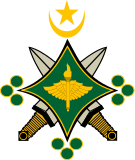 The Armed Forces of Mauritania defence force of the Islamic Republic of Mauritania created in 1985 is the sum of its army, navy, air force, gendarmerie, and presidential guard. From 2018 its global budget is accounted for3.9% of GDP.
The Armed Forces of Mauritania defence force of the Islamic Republic of Mauritania created in 1985 is the sum of its army, navy, air force, gendarmerie, and presidential guard. From 2018 its global budget is accounted for3.9% of GDP.
The Mauritanian National Navy is its smallest branch. The CIA reports that the navy includes naval infantry. It had no proper air components and received support from its small Air Force with 250 personnel, 2 FTB-337 aircraft, 15 transport aircraft, 4 SF-260E trainers and 10 helicopters, Harbin Z-9, Agusta-Westland AW109 and MD-500.
Its navy is nothing more than a small coast guard force comprising 6 patrol boats today.
Mauritania, an independent Islamic republic since 1960, is larger in area than Nigeria but mainly desert, with a population of only 1.5 million, uneasily divided between the 80 per cent Arabs and 20 per cent black Africans. There are few natural resources, and the country has been exhausted by her 1975-79 support for Morocco against the Polisario Front guerrillas of the Western Sahara. Several palace revolutions since 1978 have caused a change of sides, and the French and Moroccan troops that formerly assisted her weak army have left. The Islamic Navy was formed on 25 January 1966. The country’s fishing fleet of French and locally built trawlers is aiming to catch 250,000 tons a year. South Korea is to help build a naval shipyard. The 500 volunteer naval personnel man a growing force of patrol craft based at Port Etienne, Nouadhibou, on Cape Blanc adjoining Western Sahara. In the south are the Senegal river ports of Rosso, Boghé and Kaedi.
Cold War Mauritanian Navy
–Spanish BARCELO class: 3 fast attack craft (gun): El Vaiz (P 362, Dec 1979), El Beg (P 363, May 1979), El Kenz (P 364, Jan 1981).
Ordered 21 July 1976 from Bazan, Cadiz. First two delivered late due to trials collision in December 1978. Discarded 2000s.
–French PATRA class: El Nasr (P 411, ex-Le 10 Fuillet, ex-French Rapiére, 1.11.81)
Build by CNA as a private venture, purchased initially by the French Navy and then transferred to Mauritania. Not fitted with rumoured SSM armament. Renamed 1988, active.
–Ex-British JURA class offshore patrol vessel Class (former name, acquired): N’Maadi (ex-Cniscella, ex-Fura, Jul 1989)
Former Scottish fisheries patrol vessel built Hall Russell 1975. Very similar to British Jsles class except fitted with two Polar SP112 diesels. Sold commercially in 1988 and leased to Mauritania. Discarded 2000s
–TICHITT class coastal patrol craft Class: Tichitt (Apr 1969), Dar el Barba (Sept 1969).
Built by CNE in France. First refitted at Dakar 1980, second in the Canaries 1982. Same as Tunisian Istiklal and Moroccan El Sabig patrol craft. Discarded 2000s.
–18m coastal patrol craft Class: Imrag’ni (Nov 1965), Slought (May 1968)
CNE built 20t units (21kts, 2 diesels, 1-12.7mm MG, 8 men) given to Mauritania. Sloughi deleted 1986, Imrag’ni out of service c1990.
MISCELLANEOUS:
Ex-Spanish patrol vessels Centinela and Serviola (1953, 2701, 2 37mm, 12kts) served as Tekane and Keur Macenf from 5 March 1977
Two ex-Soviet whalers, the Boulanouar and Idini (1956, 847t, 2-30mm, 1 MG), converted as patrol vessels and support ships. Sold to a Las Palmas shipbroker 12 January 1981.
One ex-East German Nieastadt class border patrol craft Z’Bar (ex-Uelzen) given by the German government in March 1990, stil, active.
The Mauritanian Navy Today
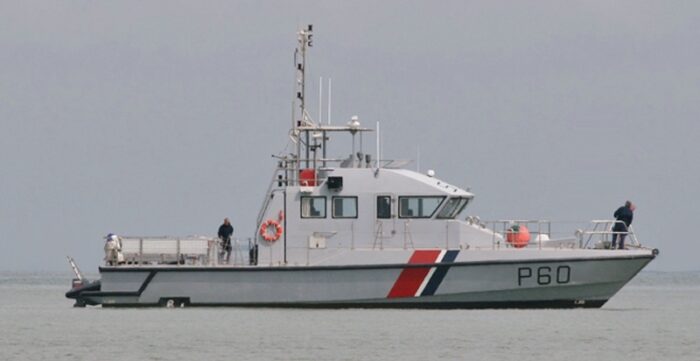
-LIMAM EL HADRAMI (China) donated 2001
-TIMBEDRA, GORGOL (class, via China) purchased in 2016 formerly a CMS design (France), LYNCEA class
-Abourbekr Ben Amer (France) purchased 1992
-El Nasr: Patra-class purchased 2020
-Z’bar, ex-German Neustadt-class PB, date unknown.
Src:
country-data.com/
armyrecognition.com/
en.wikipedia.org/
 Mexican Navy
Mexican Navy
The Mexican Navy was probably the oldest in South America, created in 1800. Now 225 years old, the Armada de México still have to monitor 3,149,920 km2 (1,216,190 sq mi)) of coastline (11,122 km (6,911 mi)) between the Carribean and Pacific, with 189 ships and 87500 personel today. It is a blue-green water navy with a full array of service, including special forces, Marines and naval aviation, missile frigates (5 ships, 7 in construction), 2 FACs, and 35 OPV and 44 CPVs, 50 counter-nartocics interceptors, 5 logistic/amphibious ships, 6 minehunters, 3 auxiliary/trainers. Its cadet flagship and ambassador round the world’s tall ships reunions is B.E.Cuauhtémoc.
Some ships are now 80 years old like the Valle class OPVs (ww2 AUK class), others quite recent as the Dutch-Mex 2005 Reformador class frigates, replacing the four Garcia class still in service. Full list below.
A bit of History
Despite being formed in 1800, the Navy struggled to acquire ships and was only formalized with the Ministry of War in 1821. It was joint to the Maxican army until 1939 and its budgets and capoabilities were closely linked to the latter, with relative independence. It was not helped by a tumultuous internal situation. Let’s cite the 1821-28 Attempts by Spain to reconquer Mexico, the first French intervention in Mexico (1838-39 ‘Pastry War’), in which the entire Armada was captured at Veracruz, the Texan Independence (1836–1845), Yucatán Independence (1841–1848), Mexican–American War (1846–1848), Second French Intervention (1862–1867), and Mexican Revolution (1910–1919), Second invasion by the United States (1914). The early armada comprised the Schooner Anáhuac and Iguala and the Cutters Campechana, Chalco, Chapala, Orizaba, Texcoco, Zumpango, Papaloapan, Tampico, Tlaxcalteca, Tuxpan, the somewhat frigate size Congreso Mexicano (ex-San Jerónimo), the Brigantines Constante and Vicente Guerrero. Later were added the Steamer paddle frigate Guadalupe, Montezuma and the first of many gunboats: The Libertad and Independencia flatiron gunboats (1874), the Demócrata and Mexico (1875) and the presidential Steam yacht Orizaba.
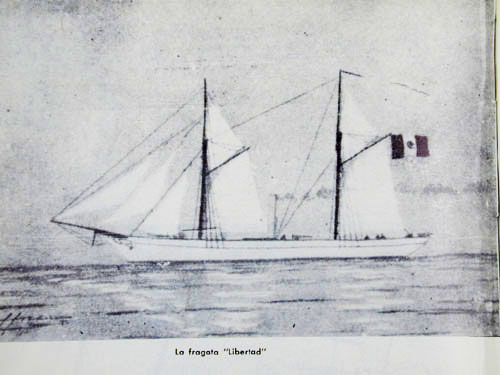
Libertad class: Laird built 480t, 38.10 x 732 x 2.67, 425 ihp/10 kts, one 100 pdr, 4×20 pdr and schooner rigged, hulked 1914, used as troop transports, BU 1920
Democrata class: Rennie built, 3 masts schooner rigged mixed construction, 445t, 42.7 x 7.6 x 3.4m, 600 ihp 11 kts, 2x 100 pdr, 2x 20pdr, TS 1914.
To these were added later the corvette or 3rd rate cruiser (French built) Zaragosa in 1892 (discarded 1924), gunboat Plan de Guadalupe (1892, 824 tons) stricken 1924, Tampico class gunboats (1902, 980 tons) stricken 1924, Nicholas Bravo class (1903, 1227 tons) stricken 1925. During the interwar, the 1932 naval plan, enabled a large coast defence ship purchased in 1924 to Brazil, three destroyer-size patrol sloops (Spanish built), two gunboat-transports (also Spanish built), and ten gunboats (Basque-built on British plans). The government chose to support the Spanish Republicans in 1931 and still during the civil war.
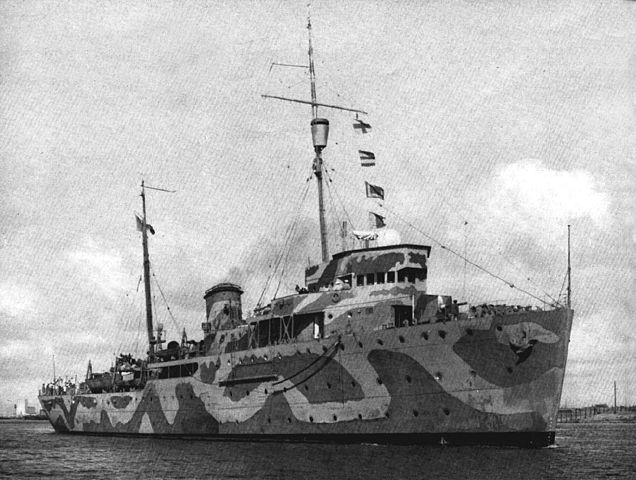
Durango circa 1942
One of the largest vessels acquired was the 1,850 tons transport cruiser General Guerrero (1908) and then the 1590t Italian built Gunboat Progreso (1907), Spanish 1300t Guanajuato class patrol sloops (1934), Spanish built 1600t Durango class transport gunboats (1934), Spanish built G class gunboats (1934). The previous Gunboats were fitted for troop transport.
Full article on the Mexican Navy in WW2
The Mexican Navy in 1947 and evolution
The Armada de Mexico remained relatively small up to that point, albeit taking part in operations with the allies:
The oldest ship still around was the Progreso (1907), discarded in 1947, followed by three 1934 Patrol sloops (Guanajuato) whioch survived until 1975 (The first was preserved), Durango (1935) until the late 1990s, and the nine G20 class patrol gunboats until 1953-56. First acquisitions the same year were four ex-Tacoma class frigates (California class) and five PCE sub-chasers as well as eight PC type sub-chasers.
Ex-US PCE type submarine chasers: Blas Godinez (ex-PCE 844, discarded 1965), David Porter (ex-PCE 847, discarded 1965), Pedro Sainz de Baranda (ex-PCE 868, discarded 1965), Tomas 7 Mann (ex-PCE 871, discarded 1972), Virgilio Unbe (ex-PCE 875, discarded 1965). Purchased 1947, armed with a 3-in, 640mm, 4-20mm, 4 DCT. Unbe had no DCT, Godinez 3-40mm, 5 20mm.
Ex-US PC type submarine chasers: CG 30 (ex-PC 820, discarded 1966), CG 31 (ex-PC 608, discarded 1964), CG 32 (ex-PC 614, discarded 1964), CG 33 (ex-PC 813, discarded 1966), CG 34 (ex-PC 794, discarded 1964), CG 35 (ex-PC 824, discarded 1966), CG 36 (ex-PC 1224, discarded 1964), CG 37 (ex-PC 819, discarded 1966), CG 38 (ex-PC 1210, discarded 1971)
All units purchased 1947. Many were not armed while in Mexican service.
It was reconstituted from there to become the firth largest navy in South America, behind Argentina, Brazil, Chile and Peru but unliked these, lacked the “big boys”, aircraft carriers, cruisers or even submarines in its inventory. Acquisition were made from US WW2 stocks under MDAP still to create the largest fleet the country ever had in its history, taking part of the communist containment strategy in these waters (and play its part in counter nartocics in the 1980s).
There was another wave of acquisitions in 1962 with 19 Admirable class minesweepers (DM-1 to DM-19) and 1963-67 with six Crosley class destroyer escorts (California class).
But by far the largest aqcquisition plan was in the 1970s:
-2 destroyers, Fletcher class (Cuathemoc class) in 1970
-1 Frigate, Manuel Azueta Ex-Edsall class in 1973
-2 LSTs Panuco class (Panuco, Manzanilla) 1972
-19 Minesweeper class AUK in 1973, ids IG-01 to 19, reclassied as corvettes (ASW gear removed), now OPVs, still active.
-31 1974-76 “Azteca” class Patrol Boats (P 01 to P31), see below.
The third wave was in the 1980s:
-2 Quetzacoalt class destroyers (Gearing FRAM I) in 1982
-6 Halcon class Corvettes (Spanish built, comp. 1982) see later
The last wave was in the 1990s:
-2 Bronstein class frigates (Bravo class) in 1993
-4 Aguila class corvettes (1991-93) Mexican built
-2 Point class OPVs (Punta Morro) 1991
-3 Cape class OPVs (Cabo class) 1990
-4 Isla Coronado class FAC P41-54 made by Equitable Shipyards 1994 (52t, 3 diesels 16,200 hp, 50 kts, 1x 0.5 in HMG, 2 LMGs, 9 crew)
To be more precise:
Ex-US ‘Point’ class patrol craft: Punta Morro (P 60, ex-US Point Vende) and Punta Mastun (P 61, ex-P 46, ex-US Point Herron) built in the early 1960s and acquired 1991.
Ex-US ‘Cape’ class patrol craft: Cabo Corrientes (P 42, ex-Jalisco, ex1S Cape Carter), Cabo Corzo (P 43, ex-Nayarit, ex-US Cape Hedge) and Cabe Catoche (P 44, ex-US Cape Hatteras) built between 1953 59 and acquired 1990-91.
Four Isla Coronado class fast attack craft: Built by Equitable Shipyards 1994 (52t full load, 3 diesels, 16,200bhp = 50kts, 1-12.7mm MG, 2~7.62mm MG, 9 crew): Isla Coronado (P 51), Isla Lobos (P 52), Ista Guadalupe (P 53), Iva Cozumel (P 54).
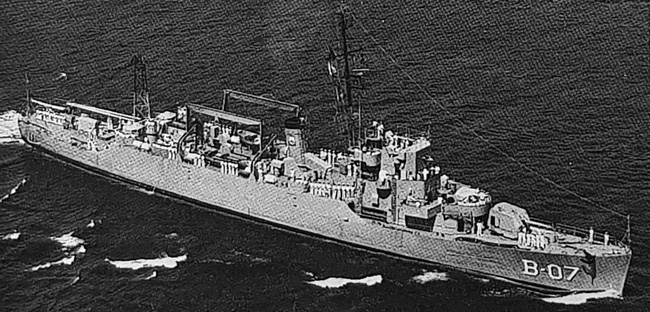
Vincente Guerrero, Crosley class (California class DDs)
To be more precise:
Ex-US AUK class minesweepers (corvettes): Leandro Valle (IG 01, ex-Pioneer), Guillermo Prieto (IG 02, ex-Symbol), Mariano Escobedo (IG 04, ex-Champion), Ponciano Amaga (IG 03, ex-Competent), Manuel Doblado IG 05, ex-Defense), Sebastian Leido de Tejada (IG 06, ex-Devastator), Santos Degollado (IG 07, ex-Gladiator), Ignacio de la Llave (IG 08, ex-Spear), Fuan N Alvarez (IG 09, ex-Ardent), Melchior Ocampo (AG 10, ex-Roselle), Valentin G Farias (IG 11, ex-Stariing), Ignacio Altamirano (IG 12, ex-Sway), Francisco Zarco (IG 13, ex-Threat), Ignacio L Vallana (IG 14, ex-Velocity), Fesus G Ortega (IG 15, ex-Chief), Gunerriez Zamora (1G 16, ex-Seater), Juan Aldarnna (IG 18, ex-Pilot), Hermenegildo Galeana (IG 19, ex-Sage)
All units transferred 1973. Reclassified as corvettes after minesweeping and ASW gear removed.
Ex-US ADMIRABLE class minesweepers (corvettes): DM 01 (D 01, ex-Fubdant), DM 02 UD 02, ex-Huarity), DM 03 (ID 03, ex-Execute), DM 04 (ID 04, ex-Specter), DM 05 AD 05, ex-Scuffle), DM 06 (ID 06, ex-Eager), DM 10 ID 10, ex-Jnstill), DM 11 (ID 11, ex-Device), DM 12 GD 12, ex-Ransom), DM 13 (ID 13, ex-Knave), DM 14 (ID 14, ex-Rebel), DM 15 (ID 15, ex-Crag), DM 16 (ID 16, ex-Dour), DM 17 (ID 17, ex-Diploma), DM 18 (ID 18, ex-Jnvade), DM 19 (ID 19, ex-Intrigue)
All units transferred 1 October 1962, except DM 04, February 1973. Reclassified as corvettes after minesweeping and ASW gear removed. DM 02, 06, 10 and 16 deleted 1986.
The bulk of the Armada reflected its main role, patrolling fishing grounds as poaching was frequent and brushes with Guatemala on this topic. Later in the 1980s discovery of oil fields offshore became another point of national interest and security for which the fleet was deployed. This was reflcted in the budget, which rose from 567 millions dollars in 1979 to 1150 millions in 1981. The navy was organized into a Pacific and Gulf commands, sub-divided each into areas of patrol.
Organization and Main bases
President: Commander in chief of all military forces, then the Navy Secretary for daily management, but no joint force command structure with the army.
General Headquarters, three naval forces, eight regions: 4 Pacific coast, 3 Mexican Gulf coast and Región Naval Central in Mexico City, with the 7th Naval Infantry Brigade, Central Special Operations Group, Air Transport Squadron between 13 zones, 14 naval sectors.
Naval Infantry
 The Mexican Naval Infantry Corps was reorganized in 2007–2009 in 30 Battalions (Batallones de Infantería de Marina) and included a paratroop battalion, Presidential Guard Brigade, two Fast Reaction Forces (6 battalions each), 3 Special Forces groups. Tasks are port security, protection of the coastal (10 km) waters and major waterways.
The Mexican Naval Infantry Corps was reorganized in 2007–2009 in 30 Battalions (Batallones de Infantería de Marina) and included a paratroop battalion, Presidential Guard Brigade, two Fast Reaction Forces (6 battalions each), 3 Special Forces groups. Tasks are port security, protection of the coastal (10 km) waters and major waterways.
The National Service obligation for Mexicans is also applicable to the Marines.
The corps was founded in 1822 and swa plenty of action. Today their training methods are very much based on USMC methods.

Its ground assets includes a large array of vehicles:
Armoured:
-3 (20+) APC-70s, Mod BTR-60s turret-less based on the civilian variant without firing ports, periscopes but with bulletproof windows. HK21 or FN MAG-58 LMG/Mk 19 GL.
-15 MACK Sherpa Scout 4×4 APCs (2014). Also used by the Unidad de Operaciones Especiaes.
Softskin:
Ural-4320, Unimog U-4000, freightliner M2, Mini Comando Ford/Dodge, G-class, Land Rover, Dodge Ram, F-150, Chevy Cheyenne.
There are organic artillery units using the OTO Melara Mod 56 105 mm, Bofors 40 mm, 51 mm FIROS MLRS, 60 mm and 81 mm mortars.
Naval Aviation
 Created in 1918 it is probably one of the oldest in South America. The Fuerza AeroNaval had in 1926 a squadron of float-planes, training was done in the US. In World War II was created the Naval Aviation school in 1943 at Las Bajadas, Veracruz and assets patrolled the Gulf of Mexico for German submarines. In the cold war it was assigned the support of ground and sea naval units in Search & Rescue, coastal patrol and assistance in disaster relief. Its procurement was very diverse, including soviet models.
Created in 1918 it is probably one of the oldest in South America. The Fuerza AeroNaval had in 1926 a squadron of float-planes, training was done in the US. In World War II was created the Naval Aviation school in 1943 at Las Bajadas, Veracruz and assets patrolled the Gulf of Mexico for German submarines. In the cold war it was assigned the support of ground and sea naval units in Search & Rescue, coastal patrol and assistance in disaster relief. Its procurement was very diverse, including soviet models.
Gulf of Mexico Naval Air Force (HQ in Tuxpan, Veracruz) comprised the Tampico Naval Air Base, Las Bajadas Naval Air Base in Veracruz, Campeche Naval Air Base, and Chetumal Naval Air Base.
Pacific Naval Air Force HQ Manzanillo, Colima: Guaymas Naval Air Base, La Paz Naval Air Base, Lázaro Cárdenas Naval Air Base, Mexico City Naval Air Base, Acapulco Naval Air Base, Salina Cruz Naval Air Base and Tapachula Naval Air Base.
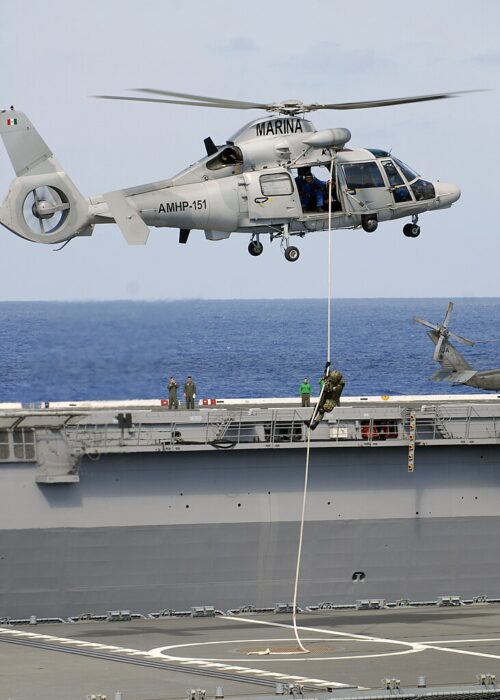
MAYPORT, Florida.,-(April 26, 2009) is participating in the 50th iteration of the multi-national UNITAS exercise involving the nations of Argentina, Brazil, Canada, Chile, Colombia, Ecuador, Germany, Mexico, Peru, Mexico, Germany, Canada and the United States Ecuador. The two week exercise includes realistic scenario-driven training opportunities such as live-fire exercises, shipboard operations, maritime interdiction operations and special warfare. (U.S. Navy photo by Mass Communication Specialist Seaman Patrick Grieco/RELEASED)
Today’s assets comprises:
-17 Patrol aircraft (5 King Air 350, 7 CASA C-212 and 6 CASA CN-235)
-20 Transporters (cessna, Casa, Dash 8, Learjet…)
-52 helicopters (22 Mil-17, 5 MD explorer, 8 UH-60, 17 Eurocopter models)
-51 trainers (Zlin 42-43, T6 texan, S-333)
SAR units
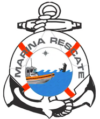 Maritime Search and Rescue branch was created in 2008, allocated in strategic ports in the Pacific and Gulf of Mexico to provide assistance. It used Coast Guard Defender class ships, two per station, and one 47-Foot Motor Lifeboat coast guard vessel per station.
Maritime Search and Rescue branch was created in 2008, allocated in strategic ports in the Pacific and Gulf of Mexico to provide assistance. It used Coast Guard Defender class ships, two per station, and one 47-Foot Motor Lifeboat coast guard vessel per station.
Port Protection (UNAPROP)
There is also a port protection component, Port Protection Naval Units (Unidades Navales de Protección Portuaria: UNAPROP) including Marines, created in 2014. These are responsible for surveillance and inspection of vessels in and out of the port.
Training
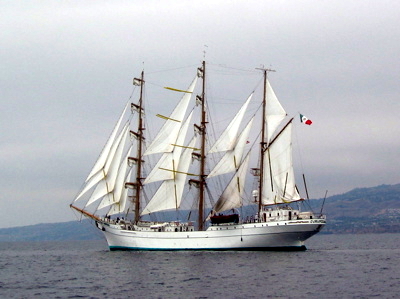
The barque cadet ship Cauhtemoc
Heroica Escuela Naval Militar (officers, General Corps after completing high school)
Naval Medical School (Mexico City)
Naval Engineering School (Mata Grape and Anton Lizardo, Veracruz)
Naval Nursing School at the Naval Medical Center.
Naval Aviation School, La Paz, Baja California Sur.
Search, Rescue and Diving School (Acapulco), also trains state police officers and firefighters.
Notable ships
Halcon class Corvettes (1982)
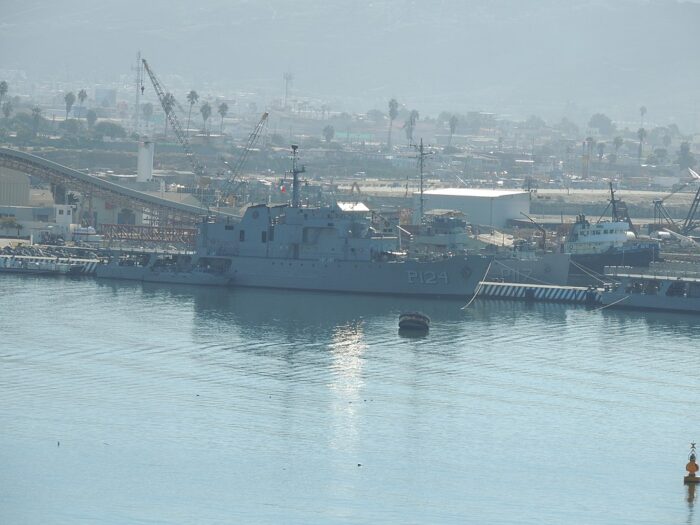
Class: All built at Bazan, Cadiz: GH 01 CADETE VIRGILIO 2.6.82, URIBE GH 02 TENIENTE JOSE 30.8.82, AZUETA GH 03 CAPITAN DE FREGATA 30.10.82, PEDRO SAINZ DE BARANDA, GH 04 COMODORO CARLOS 4.11.82, CASTILLO BRETON. GH 05 VICEALMIRANTE 16.11.82 Extant 1995 OTHON BLANCO GH 06 CONTRAALMIRANTE 17.12.82, ANGEL MORTIZ MONASTERIO
Ordered 1980. Generally similar to the ships built for Argentina. Contracts for further eight have been shelved. Delivery of GH 04 delayed by accident. GH 05 and GH 06 reportedly delivered only on 24 February 1983 and 24 March 1983. According to some reports main engines of 20V 956 TB 91 type capable of 13,300bhp for speed of 22—32kts. Large landing deck and hangar for helicopter. Used for EEZ patrol. Pennant nos. changed to C 11-C 16.

Specs:
Displacement: 767t normal; 910t full load
Dimensions: 220ft oa, 206ft 9in x 34ft 6in «x 1O0ft 67.0m, 63.0m x 10.5m x 3.08m
Machinery: 2 shafts, 2 MTU-Bazan 16V 956 TB91 diesels, 7500bhp = 2lkts. Range 5000nm at 18kts
Armament: 140mm Breda, 1 MBB BO 105C helicopter
Sensors: Radar Decca AC 1226, Tacan, optronic director CSEE Naja
Complement: 52 (10 officers)
Aguila class Corvettes (1993)

Class: GA01 UXMAL (Tampico NSY) Nov 1991, GA02 MITLA (Veracruz NSY) 1992, GA 03 PETEN (Tampico NSY) 1993, GA04 ANAHUAC (Veracruz NSY) 1993.
Originally one ship ordered each from Tampico NSY and Veracruz. Improved version of Halcon class. Fitted with hangar and landing deck for helicopter. Programme slowed down considerably due to financial problems. The first unit renamed on completion Sebastian José Holzinger (C01) and the others, respectively, Capitan de Navio Blas Godinez Brito (C02), Brigadier Jose Maria de la Vega Gonzalez (C03), General Filipe B Berriozabal (C04). On completion, C01 and C02 were temporarily armed with a 40mm gun. To be used for EEZ patrol duties.
Specs:
Displacement: 910t normal; 1175t full load Dimensions: 244ft x 34ft din = 8ft 4:n 74.41 x 10.5 x 2.502
Machinery: 2 shafts, 2 MTU 20V 956 TB92 diesels, 11,700bhp = 22kts. Range 3820nm at 18kts
Armament: 1 57mm/70 Bofors Mk 2, 1 helicopter MBB BO 105C
Sensors: Radar Raytheon SPS 64 (V), fire control Elsag NA 18 optronic director
Complement: 75 (11 officers)
Azteca class OPVs
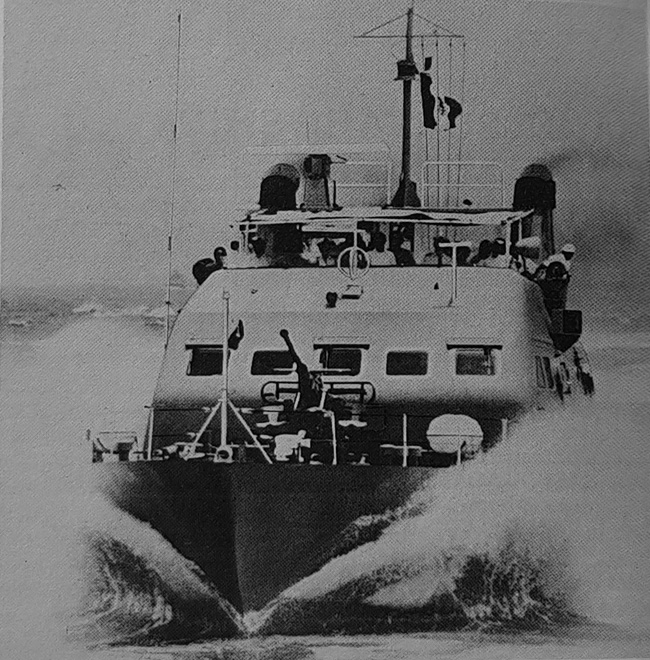
Class: Andres Quintana Roo (P 01), Matias de Cordova (P 02), Miguel Ramos Arizpe (P 03), José Mana Izazago (P 04), Juan Baunsta Morales (P 05), Ignacio Lopez Rayon (P 06), Manuel Crescencio Rejon (P 07), Antonio de la Fuente (P 08), Leon Guzman (P 09), Ignacio Ramirez (P 10), Ignacio Mariscal (P 11), Heriberto Jara Corona (P 12), Fosé Maria Mata (P 13), Feliz Romero (P 14), Fernando Lizard (P 15), Francisco y Mujica (P 16), Pastor Rouaix Fosé Maria (P 17), Fosé Mana del Castillo Velasco (P 18), Luis Manuel Rojas (P 19), fosé Natividad Macias (P 20), Esteban Baca Calderon (P 21), Ignacio Zaragoza (P 22), Tamaulipas (P 23), Yucatan (P 24), Tabasco (P 25), Veracruz (P 26), Campeche (P 27), Puebla (P 28), Margarita Maza de Juarez (P 29), Leona Vicario (P 30), Josefa Orniz Dominiquez (P 31)
Designed by a British agency and ordered from Associated British Machine Tool Makers which sub-contracted the construction of the first twenty-one (from 1974 onwards) and assisted with the building in Mexico of a further ten (at Vera Cruz and Salina Crus). They are not entirely satisfactory in service, being subject to maintenance problems.
Specs:
Displacement: 148t full load, Dimensions: 111 ft 10in, 101 ft 4in pp x 28ft 3in x 6ft 6in 34.(30.9m x 8.6m x 2m)
Machinery: 2 shafts, 2 Ruston Paxman Ventura diesels, 3600bhp = 24kts. Range 2400nm at 12kts
Armament: 140mm, 1-20mm, 2 MG, Complement: 24
The modern Mexican Navy

Allende class Frigates (1998): F211 Ignacio Allende, F212 Mariano Abasolo, F213 Guadalupe Victoria, F214 Francisco Javier Mina, ex-USN Knox-class acquired in 1998. Decommissioned 2016-2022.
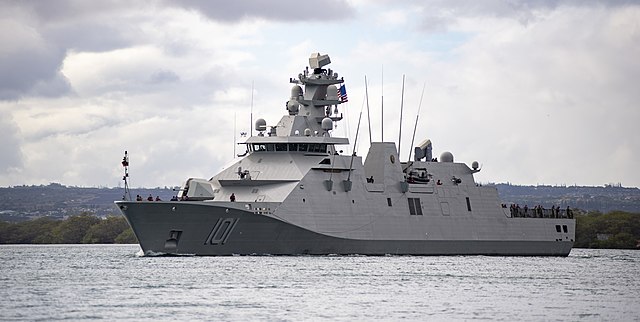
Reformador class (DAMEN Sigma-class design) Multipurpose Frigates, Netherlands design built partly in Mexico. 8 ships planned as part of fleet modernisation: F101 Benito Juárez of the 10514 POLA type was built from 2017, completed 2020. RGM-84L Harpoon Block II, RIM-162 ESSM (MK 56 VLS launcher), MK 54 Mod 0 lightweight torpedoes (2×3 MK 32 SVTT), Block II Rolling RAM missiles, Bofors 57 mm gun.
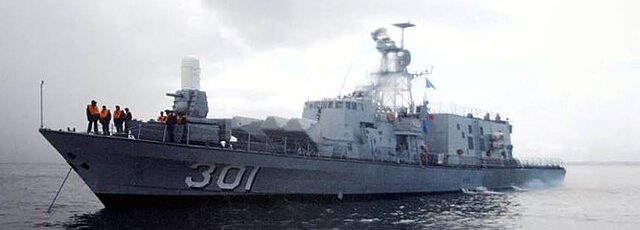
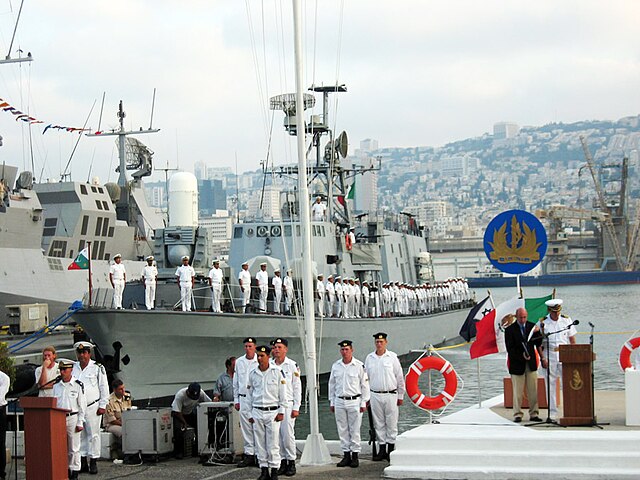
Huracán class FAC/M (2004): A301 Huracán, A302 Tormenta, ex-IDF Sa’ar 4.5-class missile boat, Gabriel SSMs, 30 mm CIWS and helideck/hangar aft. Ex INS Aliya and INS Geula.

Oaxaca class (2003): Mex-built 1680t OPVs: P161 Oaxaca, P162 Baja California, P163 Independencia, P164 Revolución, P165 Chiapas, P166 Hidalgo, P167 Jalisco, P168 Tabasco
OTO Melara 76/57, 12.7mm and 30 mm cannons, Eurocopter Panther helicopter.
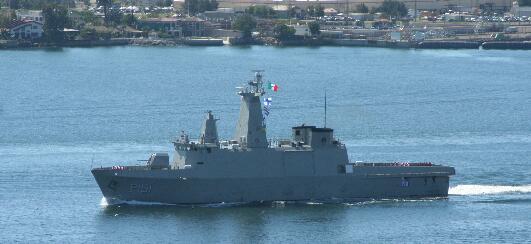
Durango class OPVs (2000): 1300t P151 Durango, P152 Sonora, P153 Guanajuato, P154 Veracruz. Mex-built (SEMAR). Bofors 57 mm/70 Mk 3, 1 medium helicopter
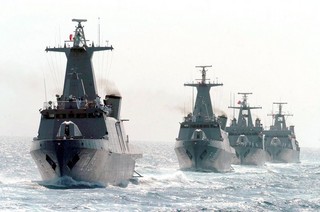
Sierra class Corvette/OPVs (1998). Mex built 1366t P141 Sierra, P142 Juarez (burnt 2003, sunk 2007), P143 Prieto, P144 Romero. Bofors 57mm, Helicopter.
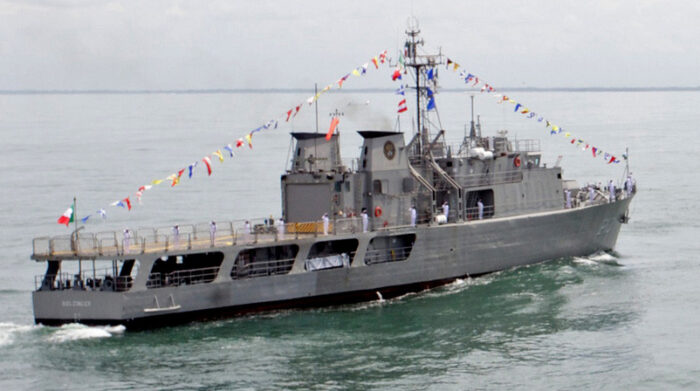
Holzinger class OPVs (1991). Mex built 1022t; Bofors 40mm, Bo 105 Helicopter. P131 Holzinger, P132 Godínez, P133 De la Vega, P134 Berriozabal

Uribe class OPVs (Spanish Built 1982, see Halcon class above), ARM Uribe (Sunk artificial reef), ARM Azueta, Baranda, Bretón, Blanco, Monasterio.
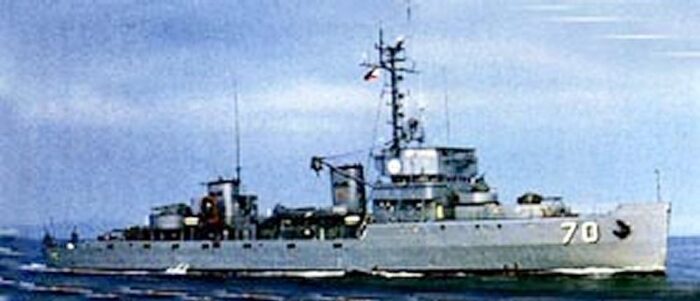
Valle class, ex AUK class, Converted Minesweeper OPVs. Still active: P102 Juan de la Barrera, Mariano Escobedo, Manuel Doblado, Santos Degollado, Juan N. Álvarez, Manuel Gutiérrez Zamora, Valentín Gómez Farías, Francisco Zarco, Ignacio L. Vallarta, Jesús González Ortega, Mariano Matamoros.
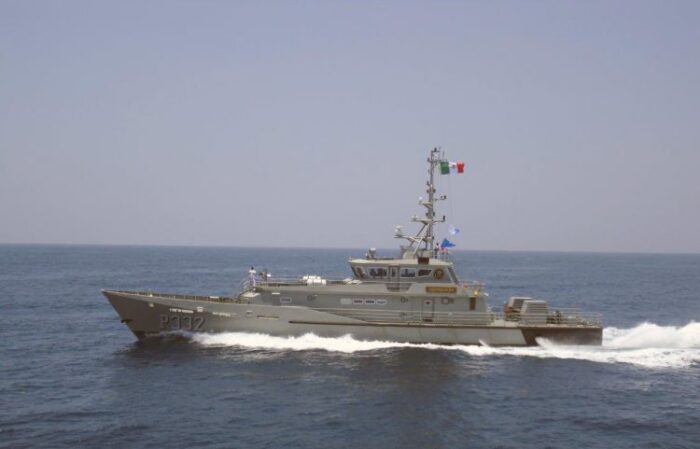
Tenochtitlan class Coastal patrollers (2011). Mex built Damen Stan Patrol 4207: PC331 Tenochtitlan, Teotihuacan, Palenque, Mitla, Uxmal, Tajin, Tulum, Monte Albán, Bonampak, Chichen Iztzá.
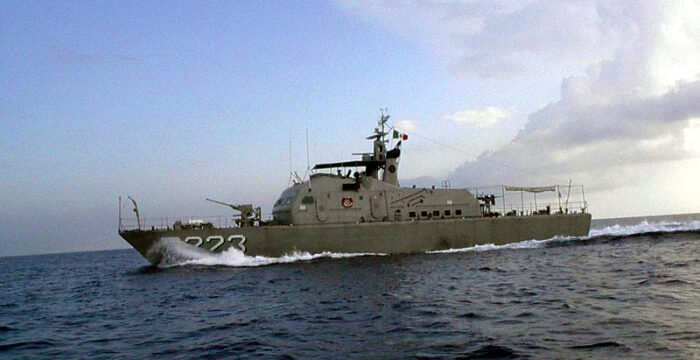
Azteca class CPVs: See above for specs. PC202-231 still active.
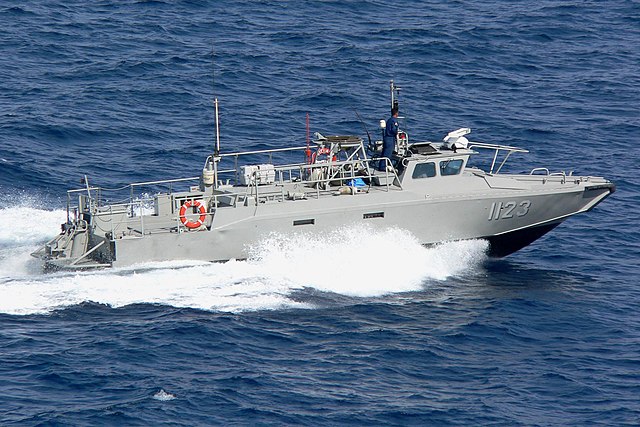
Polaris class Interceptors: 44 Polaris I (Built Sweden), 6(+17 construction Mex).
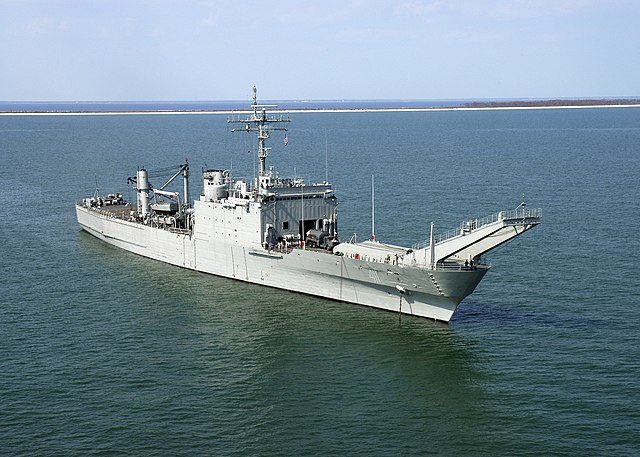
Amphibious ships still active:
-Papaloapan class Tank landing ships, A411 Papaloapan, A412 Usumacinta ex-USN Newport-class purchased 2001
-Panuco class Tank landing ship A402 Manzanillo, ex USS Clearwater County, transferred 1972
-Montes Azules class Landing ship: BAL01 Montes Azules, BAL02 Libertador (Mex built 2012)
-TBD class Supply ship Isla Madre Launched (2016=: Damen Stan 5009 Fast Crew Supplier.
Other vessels:
-Banderas class Minesweepers: Banderas, Magdalena, Kino, Yavaros, Chamela, Tepoca, US transferred.
-Huasteco class Multipurpose logistics vessels: AMP01 Huasteco, AMP02 Zapoteco (Mex built)
-Maya class Multipurpose vessels: ATR01 Maya, ATR02 Tarasco (Mex built)
-B.E.Cuauhtémoc cadets three-masted barque sail training ship.
Src
web.archive.org/ primerojunio.htm
web.archive.org/ gob.mx/semar/ la-secretaria-de-marina-armada-de-mexico…
excelsior.com.mx
web.archive.org/ crea marina unidades navales proteccion portuaria
navyrecognition.com
web.archive.org/ navyrecognition.com/ stan patrol mex
web.archive.org/ navyrecognition.com/ mex patrollers
web.archive.org mx black-hawk-helicopters
en.wikipedia.org Mexican_Navy
en.wikipedia.org Naval_Infantry_Corps
en.wikipedia.org/ Mexican_Naval_Aviation
 Royal Morrocan Navy
Royal Morrocan Navy
Origins
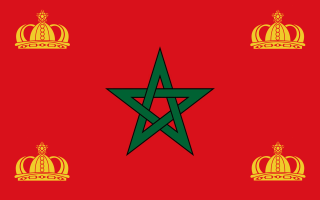 Morocco is an old civilization from the Westerrn Sahara/North Africa which roots are found in the Tamazight civilization, with a first kingdom in 225 BC under Bagad of Mauretania, later a client of the Roman Empire but long in the sphere of influence of Carthage. Troubled times followed under the Berbers, 429 Vandals invasion, 530 Eastern Roman Empire brief rule, and Muslmim conquest under the Umayyad Caliphate by 709. The first known independent state of the early middle age was the Idrisid dynasty from 788. Morocco reached its peak as a regional power in the 11th and 12th centuries, under the Almoravid and Almohad dynasties when controlling most of the Iberian Peninsula and Maghreb.
Morocco is an old civilization from the Westerrn Sahara/North Africa which roots are found in the Tamazight civilization, with a first kingdom in 225 BC under Bagad of Mauretania, later a client of the Roman Empire but long in the sphere of influence of Carthage. Troubled times followed under the Berbers, 429 Vandals invasion, 530 Eastern Roman Empire brief rule, and Muslmim conquest under the Umayyad Caliphate by 709. The first known independent state of the early middle age was the Idrisid dynasty from 788. Morocco reached its peak as a regional power in the 11th and 12th centuries, under the Almoravid and Almohad dynasties when controlling most of the Iberian Peninsula and Maghreb.
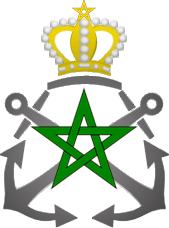 In the 11th century under the Almoravid dynasty, it had the ambition of naval hegemony in the Mediterranean and Admiral Abdullah Ben Meimoun was credited as the first commander of the Almoravid dynasty naval forces. Heped by the seafaring and shipbuilding know-how of Al-Andalus, the dynasty became indeed the “first fleet of the Mediterranean” at leas dominating the western Med, with a solid reputation, so much so that the Ayyubid dynasty Egypt and Saladin called it for help in preventing later Crusades. The 16th century was a decline with later the capture of major coastal cities and locations by Spain and Portugal.
In the 11th century under the Almoravid dynasty, it had the ambition of naval hegemony in the Mediterranean and Admiral Abdullah Ben Meimoun was credited as the first commander of the Almoravid dynasty naval forces. Heped by the seafaring and shipbuilding know-how of Al-Andalus, the dynasty became indeed the “first fleet of the Mediterranean” at leas dominating the western Med, with a solid reputation, so much so that the Ayyubid dynasty Egypt and Saladin called it for help in preventing later Crusades. The 16th century was a decline with later the capture of major coastal cities and locations by Spain and Portugal.
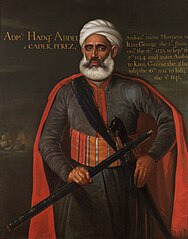 In the 15th and 16th centuries, after the loss of Iberia Morocco faced Portugal in the West, seizing territory and the Ottoman Empire in the east. But the country escaped Ottoman dominion and under the Alawi dynasty ruling the country to this day from 1631, expanded diplomatic and commercial relations with the Western world. This was also the rise of Morocco as a naval power with tradtional trade fleets going along the African coast and to the Eastern mediterranean. Under pressure from a coalition of European powers, Sultan Slimane dismantled the last remanents of the Moroccan Navy.
In the 15th and 16th centuries, after the loss of Iberia Morocco faced Portugal in the West, seizing territory and the Ottoman Empire in the east. But the country escaped Ottoman dominion and under the Alawi dynasty ruling the country to this day from 1631, expanded diplomatic and commercial relations with the Western world. This was also the rise of Morocco as a naval power with tradtional trade fleets going along the African coast and to the Eastern mediterranean. Under pressure from a coalition of European powers, Sultan Slimane dismantled the last remanents of the Moroccan Navy.
The country exacerbated appetites from western powers due to its strategic location and in 1912, France and Spain divided the country into respective protectorates, with an international zone in Tangier.
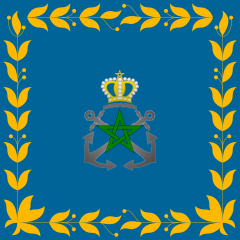 In 1956, Morocco regained its independence and reunified. Remaining stable, the country attracted investors and became gradually the 5th-largest economy in Africa. Apart tense relations with Algeria, the country remained solidly anchored to the West in its relations and this was reflected also in its vibrant tourism industry. The Moroccan Navy was at least created in 1960, April 1st, by King Mohammed V. So it’s modern history is indeed recent and it grew exponantially until reaching today 7800 personal (including 1500 marines), 121 ships and 17 aircraft, including a fleet of AS565 Panther. Unlike Algeria its procurement was aligned to the West. It’s a regional blue water navy capable of projecting power far in the Mediterranean, Red sea and Atlantic, taking part in many multi-navies exercises.
In 1956, Morocco regained its independence and reunified. Remaining stable, the country attracted investors and became gradually the 5th-largest economy in Africa. Apart tense relations with Algeria, the country remained solidly anchored to the West in its relations and this was reflected also in its vibrant tourism industry. The Moroccan Navy was at least created in 1960, April 1st, by King Mohammed V. So it’s modern history is indeed recent and it grew exponantially until reaching today 7800 personal (including 1500 marines), 121 ships and 17 aircraft, including a fleet of AS565 Panther. Unlike Algeria its procurement was aligned to the West. It’s a regional blue water navy capable of projecting power far in the Mediterranean, Red sea and Atlantic, taking part in many multi-navies exercises.
Cold war expansion 1960-1990
The Sherifian Empire, later Kingdom of Morocco obtained independence in 1956 from France and Spain, which had ruled it as a protectorate since 1912. Internally, initial and unsuccessful attempts at parliamentary government gave way to direct rule by King Hassan Il. To obtain a national consensus for intervention in the Western Sahara since 1975, a four-party democratic system and parliament has been reintroduced, but ultimate power remains firmly in royal hands, Moroccan foreign policy in the Middle East and Africa has been pro-Western since independence.
French interventions in the Shaba province of Zaire in 1977 and 1978 were supported, Moroccan soldiers being airlifted to put down the rebel forces. Morocco also publicly approved the Camp David agreements between the United States, Egypt and Israel, but modified her attitude to retain essential subsidies from the Saudis and the Gulf States. Her main external problem in recent years, however, has been the West Sahara War.
Morocco and Mauritania jointly occupied the former Spanish Sahara when Spain withdrew in 1975 to secure the world’s richest nitrate deposits, but faced growing resistance from the Polisario Front, sponsored by Algeria and more recently Libya. In spite of French and Moroccan military support, Mauritania gave up the struggle in July 1979 and transferred her portion of the territory to Morocco; a military stalemate resulted, with Morocco controlling the main towns and the phosphate mines, and the Polisario Front making sporadic guerrilla raids from its bases near the Algerian border. The Western Sahara extends Morocco’s 2100-mile coastline by half as much again.
Military, Morocco has concentrated her efforts on her Army and Air Force, with France as the main arms supplier. The United States has also supplied arms and in May 1982 concluded an agreement allowing the Rapid Deployment Force to use Moroccan bases. The self-esteem and prestige of the armed forces is high, as often happens when a right wing regime lacks a strong political base, but their loyalty to the throne has sometimes been justly suspect. The Royal Moroccan Navy from 1960 was relatively small (personnel 7000 in 1995 including 1500 marines), but expanding, with most warships and naval equipment from France, although important recent orders have gone to Spain. An analysis of the 18-month conscript sailors suggests that they are reliable politically and adequately trained, but operationally inexperienced.
Cold war Royal Moroccan Navy
Ex-British ‘RIVER’ class frigate:
#31 EL MAOUNA Blyth acquired 1964 Discarded 1980s. (ex-La Surprise, 1975 ex-Torridge) Ex-RN frigate bought by France in 1944 and by Morocco in June 1964. Transferred in 1965 after conversion as flagship and royal yacht, extra accommodation and a helicopter landing deck having been added aft.
Modified Spanish DESCUBIERTA class frigates:
COLONEL Bazan, 26.2.82, ERRHAMAN Ferrol (ex-El Maouna). Ordered 14 June 1977 and laid down 20 March 1979. Strikes delayed delivery ull 10 March 1983. Full details of modifications are not available, but Exocet MM38 or MM40 SSM are to be carried in option instead of Harpoon in the Spanish ships. Particulars are as for the Spanish Descubierta class.
French CHAMPLAIN class landing ships: #42. DAOUD BEN Dubigeon, 28.5.77, AICHA AHMED, June 1977, SAKALI ABOU Dubigeon, Dec 1978, ABDALLAH EL AYACHI Ordered 12 March 1965 (first two) and 19 August 1975.
French EDIC type landing craft:
Lieutenant Malghagh (41, ex-21) ordered 1963 from CN Franco-Belges. Laid down 17 September 1963, launched 10 January 1964 and commissioned 1965.
Ex-French CHAMOIS class corvette (minesweeping sloop)
#33 EL LAHIQ Arsenal de 1961 Returned (ex-Annanite) Lorient France 1967
CORMORAN class fast attack craft (missile):
Class: El Khattabi (P 35, 30.6.81), Boutouba (P 36, 11.12.81), El Harty (P 37,25.2.82), Azouggarh (P 38, 2.8.82).
Ordered 14 June 1977 from Bazan, Cadiz, as modified Spanish Lezaga class (derived from Lirssen Type 143 design). El Khattabi launched 1 July 1980.
Displacement: 363t standard; 355t full load
Dimensions: 194ft 6in 0a x 24ft 7in x 6ft 3in 59.3m x 7.5m x 1.9m
Machinery: 2 shafts, 3 MTU-Bazan 16V956 TB 91 diesels, 13,500bhp = 36kts. Range 700nm/2500nm at 27kts/15kts
Armament: 4 Exocet MM38 SSM, 1—76mm/62 OTO Melara Compact (300rds), 140mm/70 Breda Bofors (1472rds), 2-20mm/ 90 Oerlikon GK204 (2 x 1, 3000rds)
Sensors: Radar Raytheon 1620, HSA WM-25 fire control, Decca TM-1229C
Complement: 41
OKBA class fast attack craft:
Class: Okba (33, 10.10.75), Triki (34, 1.12.76)
PR 72 type boats ordered from SFCN June 1973. Laid down 28 April 1975 and 22 November 1974, completed 16 December 1976 and 12 July 1977. Renumbered 302, 303, 302 refitted 1985. Discarded early 2000s.
Displacement: 375t standard; 445t full load
Dimensions: 177ft lin pp, 188ft 9in oa x 25ft x 7ft lin 57.5m, 54.0m x 7.6m x 2.1m
Machinery: 4 shafts, 4 AGO V16 diesels, 11,040bhp = 28kts. Range 2500nm at 16kts, 20 days endurance
Armament: 1—76mm/62 OTO Melara Compact, 1-40mm/70 Breda
Sensors: Radar Vega system
Complement: 53
OSPREY 55 class patrol craft:
Class: El Lahig (308, Nov 1987), El; Talifig (309, Feb 1988), E/ Hamiss (316, Feb 1990), El Karib (317, Feb 1990)
Four units built by Danyard, Denmark 1987-90. Intended for fishery protection. Similar vessels built for Greece (with more powerful armament) and Senegal.
Displacement: 4201 normal; 5001 full load
Dimensions: T8Oft 5in x 26ft Jin x Of 55.0 « 8 Int 2.75
Machinery: 2 shafts, 2 MAN/B & W diesels, 4960bhp = 1&kts. Range 4500nm at 1LOkts
Armament: 1 40mm, 2 20mm (2 = 1)
Sensors: Radar Decca 1226
Complement: 15
VIGILANCE class patrol boats:
Class: Lieutenant de Vaisseau Rabhi (310, Sep 1988), Errachiq (311, Dec 1988), El Akid (312, Apr 1989), El Maher (313, Jun 1989), El Majid (314, Sep 1989), El Bachir (315, Dec 1989)
Six units built by Bazan, Spain. Reduced power and armament than Spanish Lazaga class for fishery protection duties.
Machinery: 2 shafts, 2 MTU TB 82 diesels, 7600bhp = 22kts Armament: 140mm, 2 20mm (2 x 1)
Other particulars: As Spanish Lazaga class
Ex-US PC type patrol vessels:
AGADIR (ex-Goumier, Defoe 1960 Returned (ex-USS PC 545) France 1964. Transferred from the USN to France in 1944 and from France to Morocco in 1960, as the first ship in the new Moroccan Navy. Returned to France in 1964 and sold in 1965.
Modified French LE FOUGUEUX class:
Large patrol craft Lieutenant Riffi (32); Built by CMN, Cherbourg, laid down May 1963, launched 1 March 1964 and in service May 1964. Armament reduced to 2-40 by 1982. Discarded 1990.
AL BACHIR large patrol craft:
Numbered 22 (ex-12), ordered in 1964 from CMN, Cherbourg, laid down June 1965 and launched 25 February 1967. In service since April 1967. Ex-French SIRIUS class coastal minesweeper Tawfic (ex-Aries). Transferred on 4-year loan 28 November 1974 (renewed 1978). In 1982 patrol duties as P 659. Loan made permanent 1980. Discarded 1986.
Displacement: 125t light; 154 ft full load
Dimensions: 124ft 8in pp, 133ft 2in oa x 20ft 10in x 4ft 8in 40.6m, 38.0m x 6.4m x 1.4m
Machinery: 2 shafts, 2 SEMT-Pielstick diesels, 3600bhp = 25kts. Oil 21t. Range 3000nm at 12kts
Armament: 2-40mm Bofors, 2-12.7mm MG
Complement: 23
MISCELLANEOUS cold war vessels:
-Ten coastal patrol craft: one ex-French seaward defence motor launch (ex-P 762, VC 12), transferred free 15 November 1960 and named Al Sabig, discarded 1980.
-Six Albatros CMN P 32 type (built 1975-76) numbered 23 28, with six more planned
-Three 3 Arcor 31 type.
Organization
The main Atlantic bases are Casablanca, Safi, Agadir, Kenitra and Tangier; none near the Western Sahara. The age-old Spanish colonial ports of Ceuta and Melilla continue to dominate Morocco’s Mediterranean coastline. A fishing dispute in 1973 caused a brief Moroccan-Spanish naval action. Morocco has been trying to acquire new frigates since the mid-1980s but lacked adequate funds until the 2000s.
Casablanca, Al Hoceima, Dakhla, Agadir are for the Navy, as Ksar Sghir but Laayoune and Tangier have extra coast guard/custom and gendarmerie posts.
Its penultimate admiral was Vice Admiral Mohammed Triki, as Commander in Chief for 14 years from 1991 to 2005. He was instrumental to modernize the Moroccan Navy post-cold war,and as its retirement for his efforts, was awarded the Legion of the Order of Commander, Knight of the Order of the Throne, French Legion of Honor and Legion of Merit by President Bill Clinton as well as the Spanish Legion of Merit.
Moroccan Marines
1,500 personal; created in 1960, regularly trained with France, Spain and the US. Considered an elite force.
Moroccan Naval Air branch
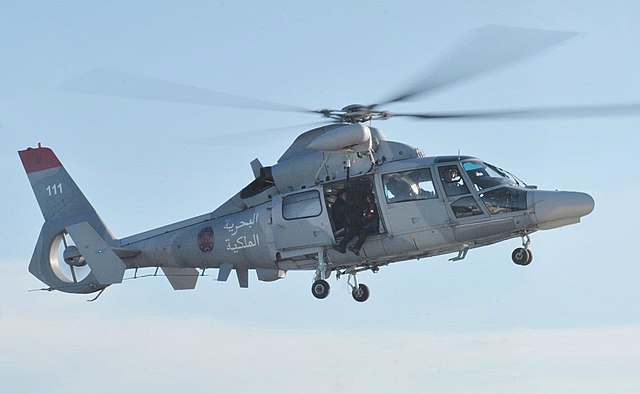
13x Britten-Norman Defender BN-2T (Air Force, used for Naval reconnaissance by the Gendarmerie) pic
4x Beech King Air 350ER (same) pic
3x Eurocopter AS565 MA helicopters for the FREMM and Floeral class frigates
24x Bell 412 MA used for ASW by the Navy. Photo
Today’s Navy
-1x FREMM Mohammed VI frigate (2014), ASW version, flagship
-2x Floréal class frigates (FR) Mohammed V and Hassan II (2002)
-1x Sigma 10513 class frigates (NL) Tarik Ben Ziyad (2011)
-2x Sigma 9813 class frigates (NL) Sultan Moulay Ismail, Allal Ben Abdellah (2012).
-1x Descubierta class corvette, Lieutenant-Colonel Errahmani (1983, mod 2014)
-4x Lazaga class corvettes (1981): El Khattabi, Commandant Boutouba, Commandant El Harty, Commandant Azouggarh
-1x OPV-70 (FR 2011) Bir Anzaran +4 under local construction
-5x OPV-64 (FR 1995) Raïs Bargach, Britel, Charkaoui, Maaninou, Al Mounastiri
-4x Osprey 55 (DAN 1988) El Lahiq, El Tawfiq, El Hamiss, El Karib
-6x local Cormoran (1988) class OPVs Lieutenant De Vaisseau Rabhi, Errachiq, El Akid, El Maher, El Majid, El Bachir
-2x PR-72 class (Legacy FR 1976) OPVs Okba class, TBD
-5x Damen Interceptor 1503 (NL, 2016, coast guard, 60 kts)
-3x BATRAL LCTs (FR 1977) Daoud Ben Aicha, Ahmed Es Sakali, Abou Abdallah El Ayachi
-1x LCT Sidi Ifni, replacing the BATRAL, local construction
-1x Dar Al Beida (2018) Hydrographic and oceanographic boat
-1x Ad Dakhla CLS class Daoud Ben Aicha (1997) 2100t navy cargo
-1x H-01 2011 Hydrographic research boat
-1x Al Mounkid Damen Stan Tug 2208 2015 coastal tug
-1x BBP Submariner training ship
-10x P-32 El Wacil class IPVs
-10x VCSM/RPB 20 IPVs
-18x Arcor-46 boats with the Moroccan Customs
-15x Arcor 35 boats, Moroccan Gendardmerie
-2x Griffon 500TD hovercraft, Moroccan Gendarmerie
-10x Rodman 55 ribs, same
-10x Arcor-17 ribes, same.
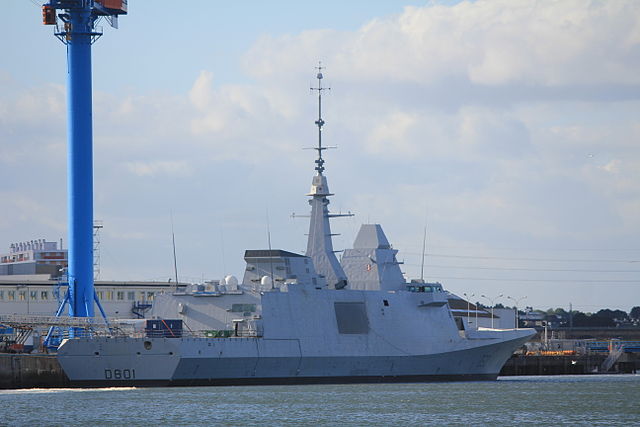
The FREMM Mohammed VI at Lorient in 2013
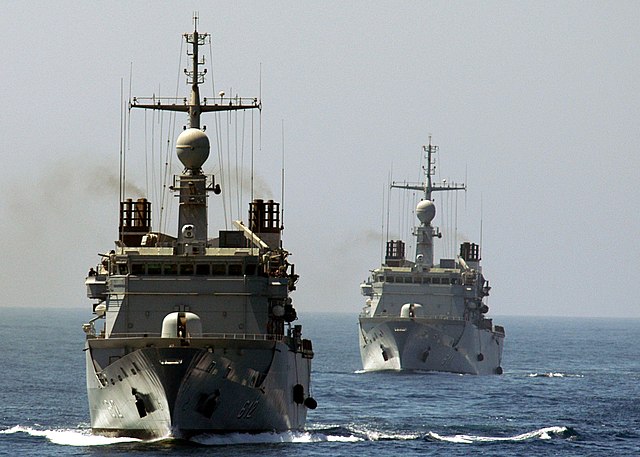
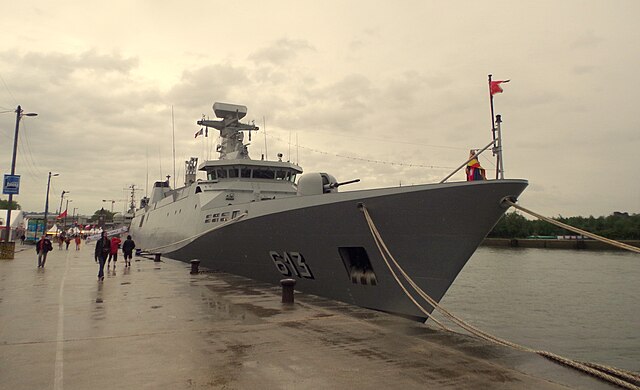
The Sigma 10513 version Frigate Tarik Ben Ziad, pennant 613.
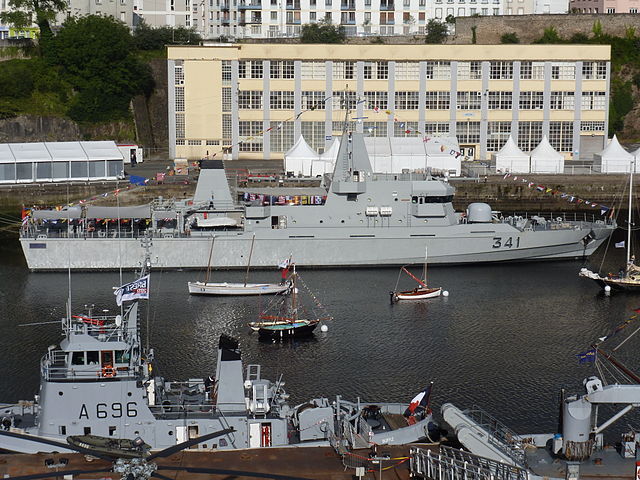
OPV Bir Anzarane, unique OPV-70 in service with 4 in construction in Morocco by STX France SA. Pennants P-342 to P-344.
Specs: 800 tonnes, 70 x 11,3 x 3,25 m
Propulsion: 2x Wärtsilä 12V26 diesels 8.16 MW (5 500 cv) 22 knots (41 km/h) and 4200 Nm (7780 km) @ 12 knots
Armed with an Otobreda 76 mm, a Bofors 40mm, two 14,5 mm MG and two 12,7 mm MG
Also capable of launching a Fast intervention craft on the deck and helideck.
Sensors: Surface search DECCA Bridgemaster II radar.
Crew: 64 officers; ratings 4 pax
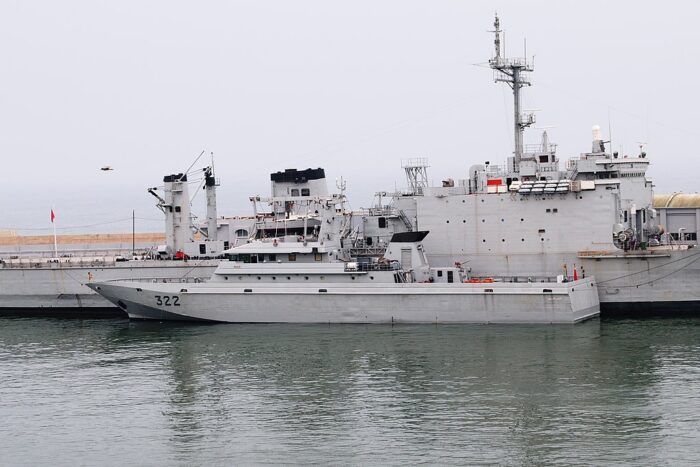
OPV Rais Al Mounastiri of the OPV-64 class
Leroux & Lotz patrol vessel concept designed for the Royal Moroccan Navy, ordered 1993.
Specs: 580 standard, 650 t FL, 64 x 11.42 x 3 m
2 shafts Wartsila Nohab 16V25 diesels, 2 Leroy-Somer electric propulsors: 7.6 MW (10,200 hp); 25 knots; RA 4,000 nmi /12 knots
Armament: 1× 40 mm Bofors, 2 × 20 mm Oerlikon, 2×2 14.5 mm guns
Surface search Decca Bridgemaster 2000, Navigation Decca 2090 ARPA, Commercial fathometer
Crew 46 (incl. 6 officers) + 8 spare berths
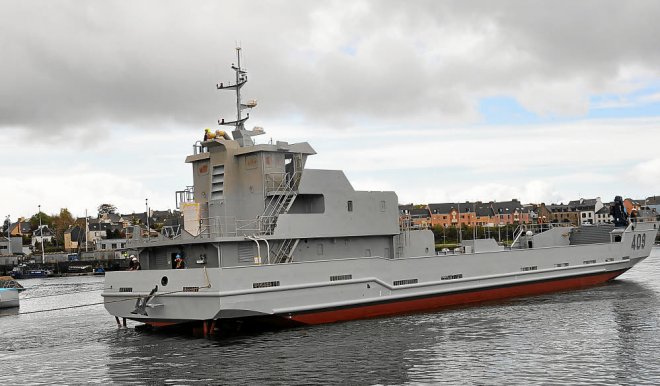
LCT 50M Sidi Ifni
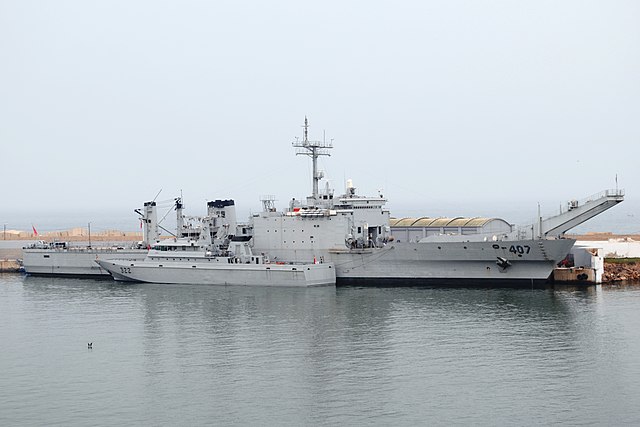
LCT Sidi Mohammed Ben Abdallah; ex-Bristol County (LST-1198)
Sources
farmorocco.wordpress.com royal-moroccan-navy
en.wikipedia.org/
navypedia.org/ships
far-maroc.forumpro.fr
africom.mil/
alchetron.com/Royal-Moroccan-Navy
defenceweb.co.za royal-moroccan-navy/
tacticalreport.com Royal Moroccan Navy
warsearcher.com
/farmorocco.wordpress.com current-ships/
combatfleetoftheworld.blogspot.com
moroccoworldnews.com/ bell-412-helicopters
lemarin.ouest-france.fr/
armyrecognition.com/
africanews.com/ moroccan-royal-navy-conscripts
defense.info/
military.africa royal-moroccan-navy
 Nicaraguan Navy
Nicaraguan Navy
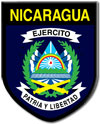 The Nicaraguian Navy is one of the youngest in the world. The “Naval Force of the Nicaraguan Army” (Fuerza Naval del Ejercito de Nicaragua) is a branch of the Armed Forces, for defense and security of the islands and territorial waters, EEZ in the Pacific and Caribbean.
The Nicaraguian Navy is one of the youngest in the world. The “Naval Force of the Nicaraguan Army” (Fuerza Naval del Ejercito de Nicaragua) is a branch of the Armed Forces, for defense and security of the islands and territorial waters, EEZ in the Pacific and Caribbean.
It was founded on August 13, 1980 as the Sandinista Navy, with a few old patrol boats while soon were aquired eight Soviet Yevgenya class minesweepers, in service until 1993. Three Zhuk-class patrol boats of a total of seven were still around by the end of 1990. There were also three North Korean fast patrol boats and two Vedette-type boats from France armed with Soviet 14.5mm machine guns. Their mission was to foil seaborne Contra attacks and deter CIA operations. Such as blwoing out diesel storage facilities at Corinto in 1983, mining of Nicaraguan harbors in 1984. The Marina de Guerra Sandinista at peak reached 3,000 personnel in 1990, was down to 800 by 1993.
The largest of the Central American republics, Nicaragua has had an unstable and strife-torn history. Until 1979, government was in the hands of General Somoza, commander of the National Guard, who had become president in 1936. The declaration of martial law in 1973 had lead to the emergence of a strong, communist-backed guerrilla organisation, the Sandanista Liberation Movement, which forced Somoza to resign in 1979, following the withdrawal of US aid for the regime by the Carter Administration. Fears of the Sandanistas’ links to the Soviet Union (a $166.8m aid deal was signed in 1982) and of Nicaragua serving as a base for further Communist subversion in Central America caused the Reagan government to back the Contra rebels against the Sandanistas, and a ten-year civil war ensued, until the Sandanistas lost their parliamentary majority in the February 1992 elections. However, political unrest since then has seen the reemergence of the Sandanistas in a coalition government and in 1992~ 94 government forces fought disgruntled Sandanista and former Contra guerrillas dissatisfied with the failure of economic reforms. Nicaragua has no navy as such; patrol boats are operated by the Marine Section of the National Guard (1200 officers and men). Main bases are at Corinto (the main port), Puerto Cabezas (Caribbean), Puerto Somoza and San Juan del Sur.
Fleet strength in detail until 1995 (Conways, page 285, all the world’s fighting ships 1947-95).
The Four Israeli ‘Dabur’ type patrol craft were: CG 10, CG 11, CG 12, CG 13, all delivered in 1978; One lost in 1985, second severely damaged in 1987. Non-operational.
The Ten North Korean ‘Sin Hung’ type patrol craft were nubered 400, 402-410, delivered in 1983 (two), 1984 (two) and 1989 (six). Two were deleted. Now two in active service.
The Four North Korean ‘Kim Jin’ type patrol craft were numbered 306, 308 plus two more delivered in 1980s, two deleted in 1990, non-operational 1995.
Ten ex-Soviet ‘Zhuk’ type patrol craft were the largest of the Navy, numbered 304, 305, 307, 309, 311, 313, 315, 317 and two more, delivered in 1982-89; two lost in the hurricane of October 1989, one deleted 1991.
Two French ‘Vedette’ type patrol craft were numbered 300, 302 delivered in 1983 (57t full load, 28.2m, 1520bhp = 24kts, 2-14.5mm). Two “Tuyacan’ class patrol craft 301, 303, (32.0m, 2—37mm), non
operational.
Also there was the Rio Kuringwas (GC 7) patrol craft of Sewart type (60t, 26kts, 3 MG) delivered in 1972, reported captured by Honduras.
Six American ‘Hatteras’ type patrol craft were transferred in 1980; two 24.5m patro] craft GC 6, GC 7 acquired in 1960, four 27.5m patrol cratt GC 2, GC 3, GC 4, GC 5 acquired in 1947; all deleted.
Four ex-Polish ‘K 8 (Type 3611) type minesweeping boats were transterred in 1984, extant 1995.
Four ex-Soviet ‘Yevgenya’ class inshore minesweepers were transferred, named SO1, S03, S08, S10, transferred in pairs 1984 and 1986; On was sunk in hurricane in 1989
Two tank landing lighters (45.8m, kts) built in 1985 by Damen, Netherlands were also integrated in the Navy, status unknown.
Two more patrol vessels based on the Damen Stan 4207 design were acquired in 2017, commissioned as Soberanía I (409) and Soberanía II (411) by August 2019. Now the most valuable assets of the Navy. In addition of their coast guard or environmental monitoring, thay have a full military sensor suite and deck gun at a cost of US$20 million. They were acquired from Jamaica as HMJS Cornwall and HMJS Surrey.
The commander was a Major from the Sandinista Popular Army or Ejército Popular Sandinista, with main bases at Corinto (Pacific) and Puerto Cabezas (Caribbean) with more installations are at El Bluff and San Juan del Sur, Pacific.
PICS dabur and Damen 4207 awaited
Sources
en.wikipedia.org Nicaraguan_Navy
armyrecognition.com/ stan-patrol-4207
defensa.com/ fuerza-naval-nicaragua
Fleet Today
2x Damen Stan 4207 Patrol Vessel (NL built)
4x Rodman-101 (Spain) Fast Patrol Boat
2x Sin Hung-class torpedo boat (North Korean built)
3x Zhuk-class patrol boat (7 delivered “seaworthy” orinally)
10x Dabur-class fast patrol boat from Israel
2x ‘Vedettes côtières de surveillance maritime’ from France, Swift Boat type.

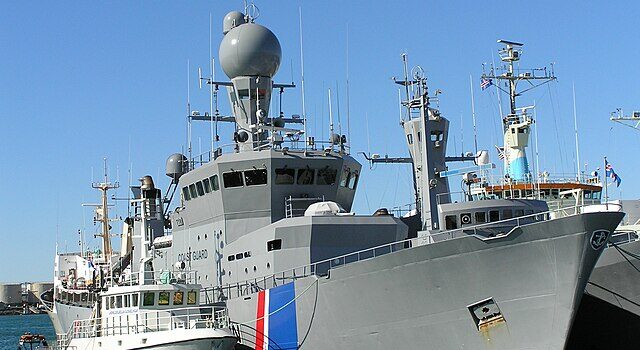
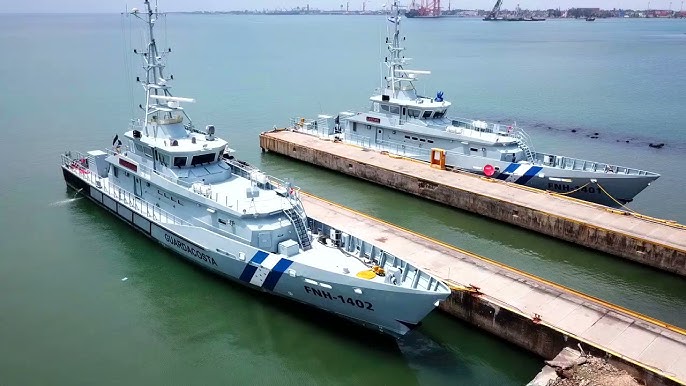
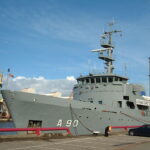
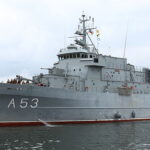
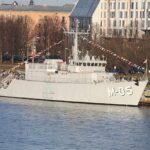
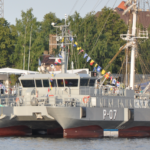
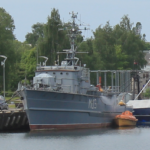
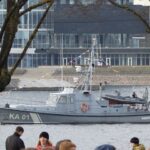
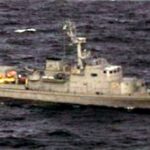
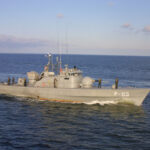
 Latest Facebook Entry -
Latest Facebook Entry -  X(Tweeter) Naval Encyclopedia's deck archive
X(Tweeter) Naval Encyclopedia's deck archive Instagram (@navalencyc)
Instagram (@navalencyc)





 French Navy
French Navy Royal Navy
Royal Navy Russian Navy
Russian Navy Armada Espanola
Armada Espanola Austrian Navy
Austrian Navy K.u.K. Kriegsmarine
K.u.K. Kriegsmarine Dansk Marine
Dansk Marine Nautiko Hellenon
Nautiko Hellenon Koninklije Marine 1870
Koninklije Marine 1870 Marinha do Brasil
Marinha do Brasil Osmanlı Donanması
Osmanlı Donanması Marina Do Peru
Marina Do Peru Marinha do Portugal
Marinha do Portugal Regia Marina 1870
Regia Marina 1870 Nihhon Kaigun 1870
Nihhon Kaigun 1870 Preußische Marine 1870
Preußische Marine 1870 Russkiy Flot 1870
Russkiy Flot 1870 Svenska marinen
Svenska marinen Søværnet
Søværnet Union Navy
Union Navy Confederate Navy
Confederate Navy Armada de Argentina
Armada de Argentina Imperial Chinese Navy
Imperial Chinese Navy Marinha do Portugal
Marinha do Portugal Mexico
Mexico Kaiserliche Marine
Kaiserliche Marine 1898 US Navy
1898 US Navy Sovietskiy Flot
Sovietskiy Flot Royal Canadian Navy
Royal Canadian Navy Royal Australian Navy
Royal Australian Navy RNZN Fleet
RNZN Fleet Chinese Navy 1937
Chinese Navy 1937 Kriegsmarine
Kriegsmarine Chilean Navy
Chilean Navy Danish Navy
Danish Navy Finnish Navy
Finnish Navy Hellenic Navy
Hellenic Navy Polish Navy
Polish Navy Romanian Navy
Romanian Navy Turkish Navy
Turkish Navy Royal Yugoslav Navy
Royal Yugoslav Navy Royal Thai Navy
Royal Thai Navy Minor Navies
Minor Navies Albania
Albania Austria
Austria Belgium
Belgium Columbia
Columbia Costa Rica
Costa Rica Cuba
Cuba Czechoslovakia
Czechoslovakia Dominican Republic
Dominican Republic Haiti
Haiti Hungary
Hungary Honduras
Honduras Estonia
Estonia Iceland
Iceland Eire
Eire Equador
Equador Iran
Iran Iraq
Iraq Latvia
Latvia Liberia
Liberia Lithuania
Lithuania Mandchukuo
Mandchukuo Morocco
Morocco Nicaragua
Nicaragua Persia
Persia San Salvador
San Salvador Sarawak
Sarawak Uruguay
Uruguay Venezuela
Venezuela Zanzibar
Zanzibar Warsaw Pact Navies
Warsaw Pact Navies Bulgaria
Bulgaria Hungary
Hungary

 Bundesmarine
Bundesmarine Dutch Navy
Dutch Navy Hellenic Navy
Hellenic Navy Marina Militare
Marina Militare Yugoslav Navy
Yugoslav Navy Chinese Navy
Chinese Navy Indian Navy
Indian Navy Indonesian Navy
Indonesian Navy JMSDF
JMSDF North Korean Navy
North Korean Navy Pakistani Navy
Pakistani Navy Philippines Navy
Philippines Navy ROKN
ROKN Rep. of Singapore Navy
Rep. of Singapore Navy Taiwanese Navy
Taiwanese Navy IDF Navy
IDF Navy Saudi Navy
Saudi Navy Royal New Zealand Navy
Royal New Zealand Navy Egyptian Navy
Egyptian Navy South African Navy
South African Navy






























 Ukrainian Navy
Ukrainian Navy dbodesign
dbodesign